PICKARD CHILTON


Editorial Director
Cesare Maria Casati
Editorial Coordination
Elena Cardani Texts
Mario Pisani Pickard Chilton Editing
Elena Cardani Elena Tomei Translations
Martyn J. Anderson Diffusion
Claire Nardone Graphic Design
Patrizio Barbera
Editorial Coordination Pickard Chilton Mig Halpine
I Protagonisti
Series of books by l’Arca International
S.A.M. M.D.O., 31 avenue Princesse Grace MC 98000 Monaco
Achevé d’imprimer: Janvier 2022 ISBN: 978-2-9559981-8-2
Dépôt légal : Janvier 2022
Printed in Italy by BOOST GROUP Spa Via Dante Alighieri, 12 24060 San Paolo D’Argon (BG)
www.arcadata.com
© l’Arca International. All rights are reserved. No parts of this publication may be reproduced, stored in a retrieval system or transmitted, in any form or by any means, electronic, mechanical, photocopying, recording or otherwise, without the prior permission of l’Arca International.
Every effort has been made to gain permission from copyright holders and/or photographer, where known, for images reproduced in this book, and care has been taken to caption and credit those images correctly. Any omissions are unintentional, and we will be happy to include appropriate credit in future editions if further information is brought to the publisher’s attention.
PICKARD CHILTON
PICKARD CHILTON
1 Contents The Architecture of Pickard Chilton by Mario Pisani 003 ExxonMobil Global Campus River Point 018 032 042 052 062 072 082 092 100 Houston, Texas Chicago, Illinois Akamai Headquarters Cambridge, Massachusetts The Eight Bellevue, Washington Devon Energy Center Oklahoma City, Oklahoma 600 Canal Place Richmond, Virginia Norfolk Southern Headquarters Atlanta, Georgia 2+U Seattle, Washington Tokyo Midtown Yaesu Tokyo, Japan 609 Main Houston, Texas Google Cambridge Headquarters 120 Cambridge, Massachusetts Global Gateway Shinagawa 130 Tokyo, Japan Eaton House 138 Dublin, Ireland Plieninger Straße 140 Development 144 Stuttgart, Germany 164 176 184 194 202 206 The RO Uber Sky Tower CalPERS Headquarters Complex Next Generation Workplace Mass Timber Architecture Studio Profle 154 T3 RiNo Denver, Colorado Houston, Texas Los Angeles, California Sacramento, California Amsterdam, The Netherlands Northwestern Mutual Headquarters 108 Milwaukee, Wisconsin 300 North LaSalle Chicago, Illinois 024 006
The Architecture of Pickard Chilton
by Mario Pisani *
PICKARD CHILTON practices from the second and third foors of a 1918 building on Chapel Street in New Haven, Connecticut, a small city graced by the gothic towers of Yale University and modern architectural landmarks by Louis Kahn, Paul Rudolph, Eero Saarinen, Roche Dinkeloo, Gordon Bunshaft, and Marcel Breuer. The studio of only 50 people competes for projects with today’s architectural elite of much larger frms that include Foster + Partners, Kohn Pedersen Fox, Skidmore Owings & Merrill LLP, Robert A. M. Stern Architects, Murphy/Jahn, Pelli Clarke Pelli Architects, and Pei Cobb Freed & Partners. Pickard Chilton has worked in 20 countries, with approximately 7,5M m2 (80M GSF) of projects built, under construction, or expected to be built.
Pickard Chilton’s process and ethos draw on a deep heritage that informs its practice. Principals Jon Pickard FAIA, RIBA, William Chilton FAIA, RIBA, and Anthony Markese FAIA, RIBA, LEED AP, all share a common Midwestern upbringing, and all three can trace their professional lineage to Eero Saarinen – Pickard and Markese through their work with Cesar Pelli, who practiced with Saarinen; and Chilton through his studies at the University of Minnesota with Ralph Rapson and his work with Leonard Parker, who also practiced with Saarinen. Before founding Pickard Chilton in 1997, the three principals had already lent their design prowess to signifcant projects that include the Petronas Towers in Kuala Lumpur, Malaysia (Pickard, Design Collaborator at Cesar Pelli & Associates), Kingdom Centre in Riyadh, Saudi Arabia (Chilton, Principal at Ellerbe Becket), and Reagan National Airport in Arlington, Virginia (Markese, Design Team Leader at Cesar Pelli & Associates).
In a society driven by consumption, the pressure to constantly produce has negatively impacted technical know-how, the actual practice of architecture and construction, and the relationship with those working on the site. The concepts of beauty and patient, meticulous design and execution have been stripped away by a process that reinforces excessive individualism and obscures history and context. In sharp contrast to a process that focuses solely on the end-product, Pickard Chilton approaches design without ties to theoretical architectural debate or to what is showcased at international biennials or major exhibitions. The studio is not interested in establishing a singular design identity through extravagant theories or buildings designed for press headlines. Instead, its design methodology aims to create urban spaces and buildings that refect an ethical modernity that captures the true essence of the modern movement.
We can see from sketches and scale models that Pickard Chilton focuses on patiently and precisely transforming its ideas into something concrete, unanimously valued, and above all, satisfying to its clients and the occupants of its buildings. Designers often frst convey an idea of what a building will look like in a hand-drawn sketch that is sometimes embellished with watercolor. The studio’s principals studied architecture in the pre-computer era and learned design as a process of exploring ideas using pencil on paper and hand-built models. Drawing also carries with it a freshness in the relationship between the idea that underscores a project and the hand ready to design it. In What is Called Thinking, Martin Heidegger sang the praises of the hand when he wrote: “The hand not only grasps and takes, not only takes and strikes. The hand offers and receives, and
3
not only things; it also offers itself and receives itself in the other hand. The hand keeps, the hand holds. The hand draws signs because probably man is a sign. Two hands join when this gesture of man must lead to great simplicity”. Pickard Chilton’s drawings portray this ability of the hand to communicate profound concepts in the briefest and simplest of recognizable gestures. This effect is exemplifed in the central atrium of the CalPERS Headquarters Complex in Sacramento, California; T3 RiNo in Denver, Colorado; and The RO master plan in Houston, Texas.
It is interesting to note that the studio is focused solely on design, and clients are closely involved from the earliest sketches to the completion of the work. The studio recently published The Art of Collaboration by Michael J. Crosbie, which offers a detailed description of a responsive approach that cultivates a relationship between architect and client. Within each relationship, Pickard Chilton collaborates with its clients to determine a unique expression of their values and aspirations. It was Frank Lloyd Wright who reminded us that the beauty of architecture depends on the intelligence of the client.
The principals’ shared midwestern background could provide a partial explanation for their practical approach, inspirational leadership style, and aptitude for listening to, learning from, and building rapport and trust with all stakeholders. Proof of concept comes from considering Pickard Chilton’s impressive portfolio in which the commonalities between projects are the successful execution of a solution unique to the client, context, and community using building technologies that serve the purpose of the structure and mitigate its environmental impact. These concepts are also common to Eero Saarinen’s practice. His use of new methods and materials and
his approach to each project as a unique problem to be solved while maintaining the awareness of the solution as a space that would be inhabited by his client have profoundly infuenced the work of Pickard, Chilton, and Markese.
This process has been utilized in the design of large buildings, multinational corporate headquarters, offce skyscrapers, hotels, and academic facilities – all projects of remarkable variety and quality that are immediately understandable architecture. As Pickard explained in Thomas Fisher’s essay “Building Good Relationships” in Pickard Chilton, “We don’t seek a signature style. Instead, we look for the keys to each client’s culture and try to give it a strong, simple form.” Projects like the Northwestern Mutual Headquarters in Milwaukee, Wisconsin, and Devon Energy Center in Oklahoma City, Oklahoma, were conceived of using a knowledge of architecture that emphasizes design vision, integrity, and a focus on the client’s objectives. In both cases, the client wanted to bring employees together on campuses that served the needs of the corporation and brought value to their cities. Both campuses engage the city with publicly accessible spaces and careful integration with adjacent parks. These high-performance towers and their associated functional and amenity elements have invigorated their respective urban locations, creating jobs and spurring substantial investment in their cities.
With many of Pickard Chilton’s projects, one does not enter a conventional lobby that rises upwards to highlight the importance of the client, but rather an open and communal space, a welcoming piazza in which people “exchange glances” as they did in such medieval squares as Piazza del Campo in Siena, Italy. Where the building meets the ground, where it is in relationship with the soil and Mother Earth, is also where it welcomes those who interact
4
with the structure and where it presents the most immediate image, the very face of architecture, a face that should be open and welcoming as it is in this studio’s designs. The ground level is the most distinctive aspect of the design in such projects as The RO, in Houston, Texas; The Eight in Bellevue, Washington; and Northwestern Mutual Headquarters in Milwaukee, Wisconsin.
When the studio sketched its frst ideas of Global Gateway Shinagawa, its observations and approach mirrored an observation made by Wim Wenders while making Tokyo-Ga, the documentary flm about Yasujirō Ozu: “When we look at the landscape, here we only see buildings, not images. We should start digging, like archaeologists, to fnd something out of this abused landscape... Today, there are very few people in the world who advocate the need for appropriate images. We absolutely need images that harmonize with our civilization and our deepest inner selves.” The site stretches along 1.6 kilometers of what was originally the shoreline of Tokyo Bay, now transformed into a fowing pedestrian promenade that links the development to Takanawa Gateway Station by Kengo Kuma & Associates and knits together an urban area split by multiple rail lines. At 300 North LaSalle and River Point in Chicago, Pickard Chilton was able to reclaim actual waterfront and improve public access to the river, while again creatively solving a problem with rail lines that disrupted the urban fabric.
Uber Sky Tower in Los Angeles, a concept designed to LEED Platinum standards, was developed in collaboration with ARUP for an invited competition organized by Uber Elevate. It is a mega-skyport that exemplifes the future of urban aviation transport. The tower operates like a conventional mechanized hanger for parking vehicles and is intended to facilitate at least 1000 vehicle arrivals and 1000
departures per hour, with each vehicle ferrying up to fve passengers. The project works like an intriguing adaptation of Moebius’ world that merges with Sant’Elia’s drawings to create a kit of parts that can ft into the most diverse contexts to provide a valid solution to air transport. While Uber Sky Tower pulls the future into the present moment, on a much smaller scale at Eaton House, in Dublin, Ireland, we see how Pickard Chilton, through attentiveness to detail and regard for historic materials and methods, reimagines the past to generate a relevant conversation between a useful and vital present and its elegant Georgian context.
In 1966, around the time many of the Yale University landmarks near Pickard Chilton’s studio were being constructed, Luigi Pareyson could have been commenting on the frm’s design methodology when he wrote in Conversazioni di Estetica, “Tradition and innovation, even if they sometimes seem in opposition, are in fact united by an original and profound solidarity. It is by virtue of innovative acts that traditions are not only born but maintained. To continue without innovating is just copying and repeating, and to innovate without continuing is to build on sand a pointless daydream.” Pickard Chilton builds on solid ground, with a foundation in a modern tradition in which architecture employs technology, beauty, and utility in pursuit of creating spaces and places that inspire.
* Mario Pisani, born in Rome in 1947, graduated from La Sapienza University. He taught History of Modern and Contemporary Architecture and History of the Garden and Landscape at Luigi Vanvitelli University of Campania in Aversa; at La Sapienza in Rome; and at the Faculty of Engineering, University of Perugia. He is a Member of the International Academy of Architecture (IAA), Sofa. He has written more than 200 essays and volumes cited by more than 500 scholars. Since 2021, he has been a member of the commission for graduation exams at the Faculty of Architecture, Islamic University of Beirut.
5
ExxonMobil Global Campus
Houston, Texas
ExxonMobil Offce Complex: Master planned and designed by Pickard Chilton, ExxonMobil’s new offce complex within the 156-hectare wooded site brings together 10,000 employees from across a variety of locations in both greater Houston and nationally.
The design for the large complex comprises 14 low-rise offce buildings, a laboratory, Wellness Center, conference and training centers, a child care center and other employee amenities.
The iconic Energy Center—a 9,072 metric ton cube foating above an outdoor plaza and refecting pool— anchors the campus at the East, with the Wellness Center to the West.
Designed to high standards of energy effciency and environmental stewardship, the new campus provides a high-quality work environment. Open atriums are designed to unite several foors easily and to enhance opportunities for employee collaboration.
ExxonMobil Energy Center: The iconic jewel of the campus, the Energy Center is designed to embody the company’s commitment to leading technology and engineering while showcasing its heritage, people and leadership. It serves as the front door of the campus, reception for dignitaries and visitors and space for training as well as larger community events.
continued on page 12
Location: Houston, Texas
Status: Completed in 2015
Size: 763,300 gsm
Certifcation: LEED Gold
Client: ExxonMobil
Master Plan & Design Architect: Pickard Chilton
Executive Architect: Gensler
Structural Engineer: Ensight Haynes Whaley
MEP Engineer: Cosentini Associates, Thompson Company
Landscape: Hargreaves Associates
Interiors: PDR, Gensler
Contractor: Gilbane Building Company, Harvey Builders
6
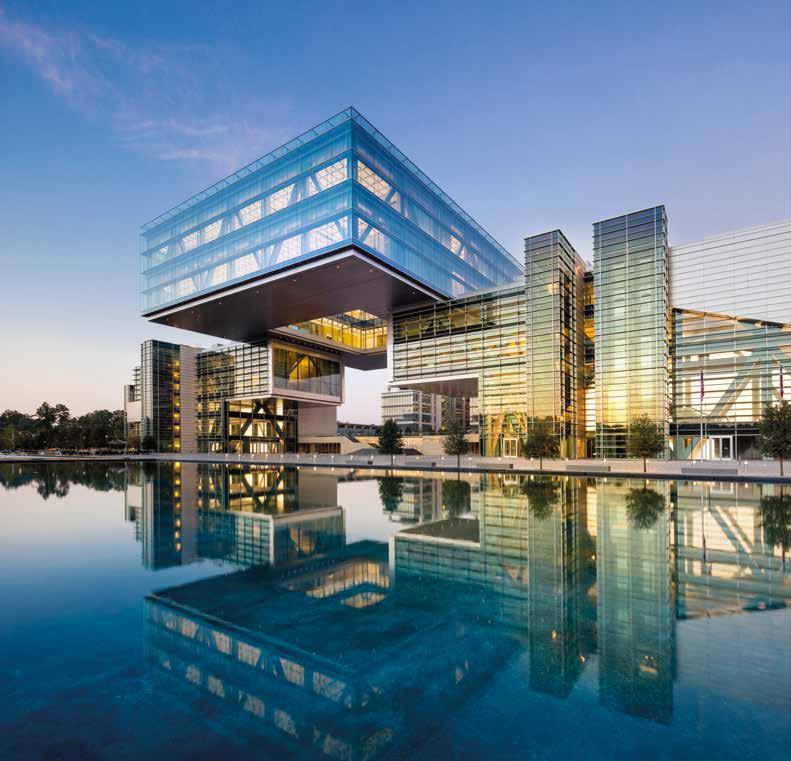
7
© David Sundberg/Esto
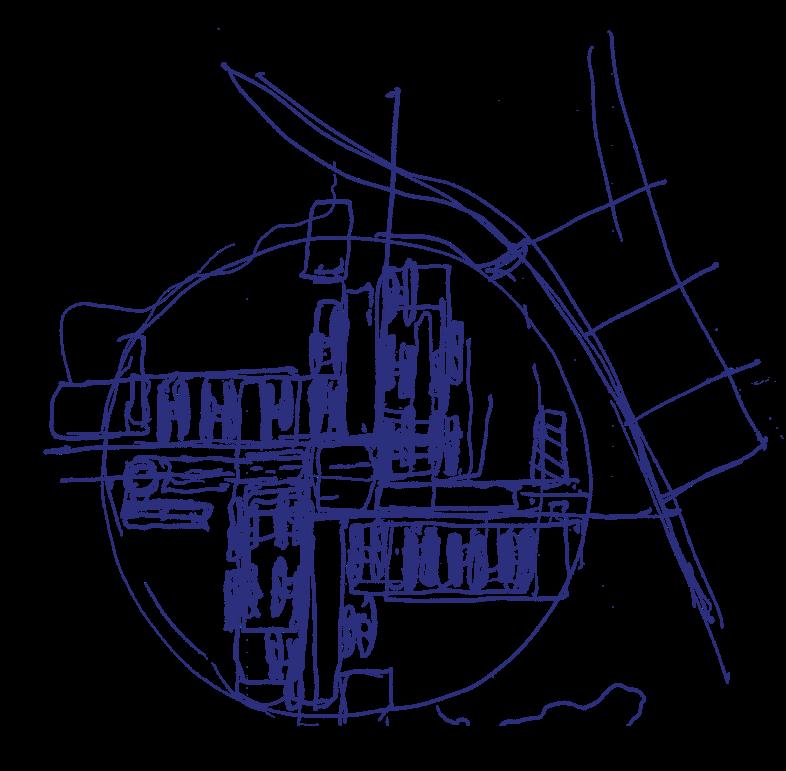
© Pickard Chilton 8

© Pickard Chilton

30M 60M
ExxonMobil 10
©
SITE PLAN 10M 30M 60M 0
from page 6
The Energy Center’s main feature is a 9,072 metric ton foating Cube that appears to hover above the plaza below. The Cube offers spectacular views back to the campus and out over the wooded campus. Two multi-story atria located in the wings create gathering spaces for visitors and employees. Monumental stairs and escalators cascade openly through the space, and glass elevators at the façade lead people through the Energy Center and up into the Cube.
ExxonMobil Wellness Center: A 12,078 m2 Wellness Center features a three-story glass atrium allowing for views of the campus and the nearby lake. Employees have access to the latest

Imaging 12
©
Joe Aker/Aker
ftness offerings, including cardio, yoga, spinning, Pilates and strength training facilities. A basketball court, personal training services and healthy dining venues are also available.

The Wellness Center is also home to the Medical and Occupational Health Clinic, where employees have access to travel health services and work-related injury and illness management. Employees are able to visit the Wellness Center any time during the workday, an option intended to improve health and well-being.
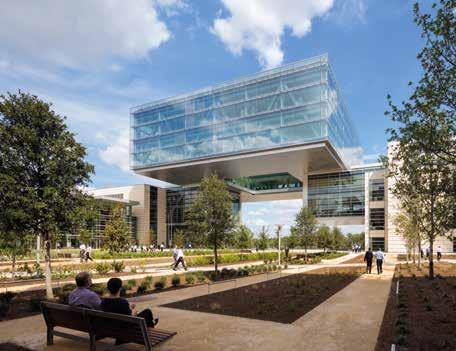
13
David Sundberg/Esto
©
© David Sundberg/Esto
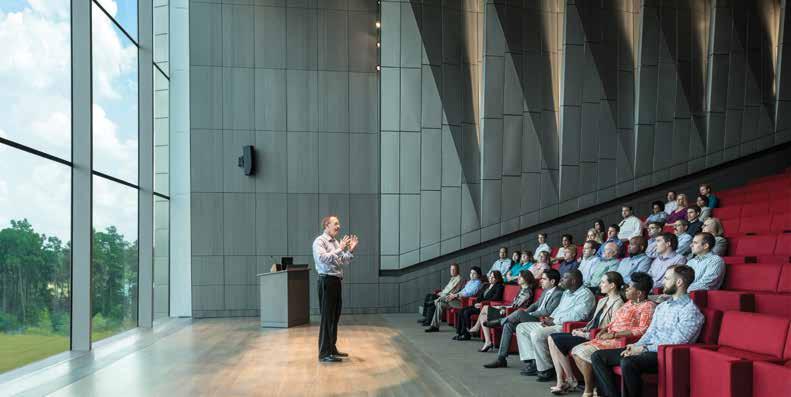
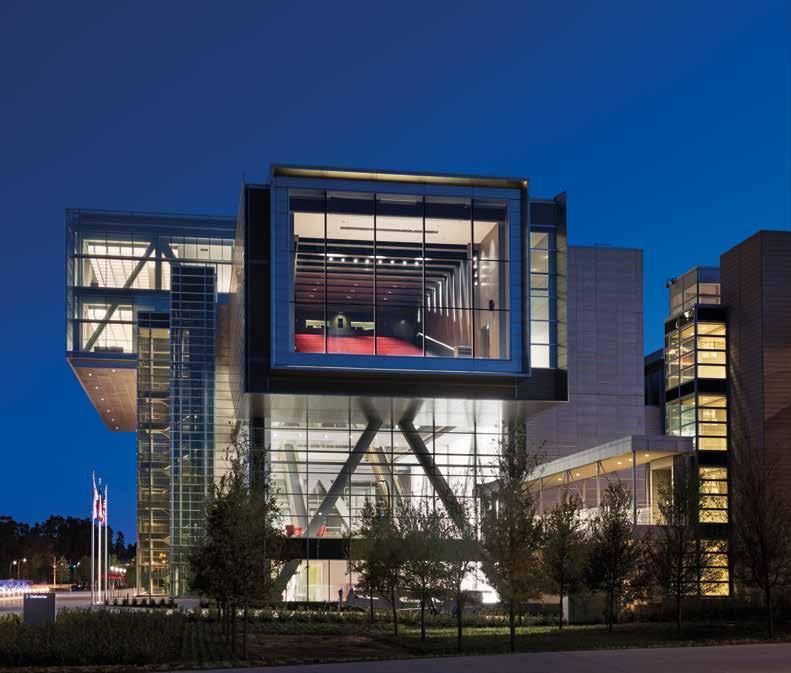 © David Sundberg/Esto
© David Sundberg/Esto
14
© Terry Vine
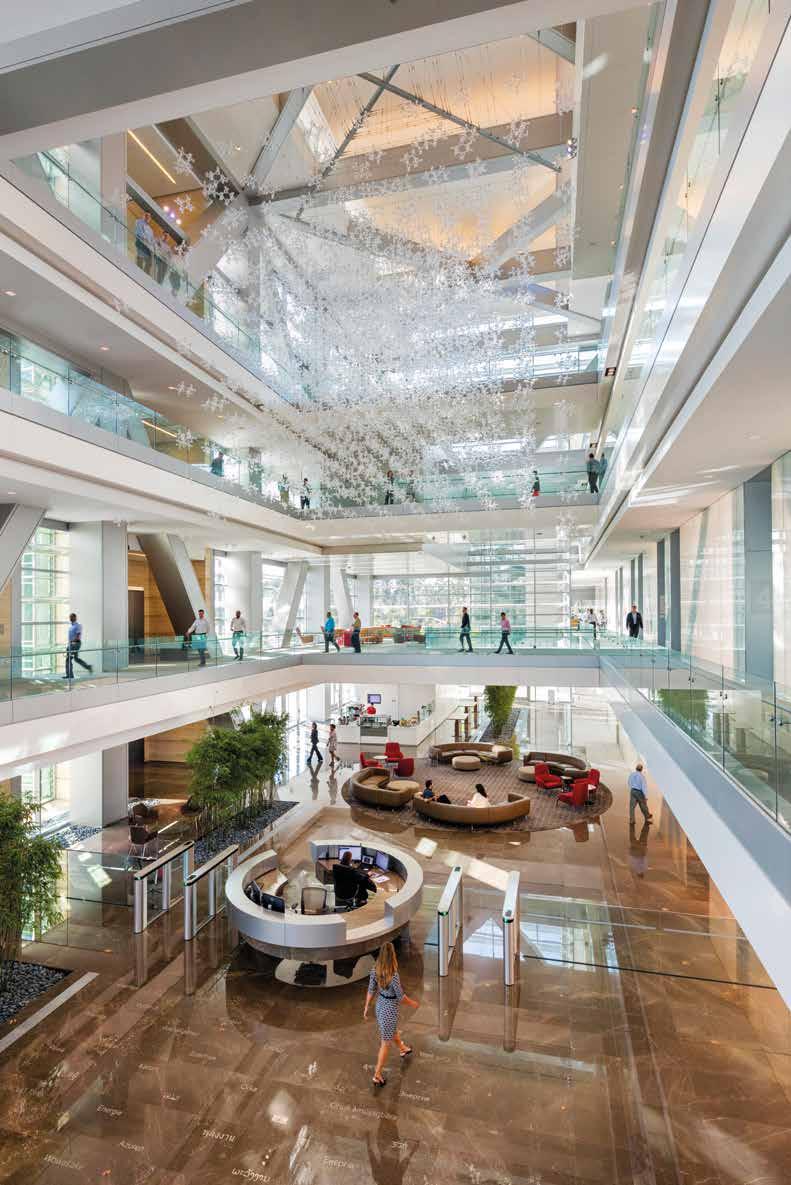
David Sundberg/Esto 15
©
 © David Sundberg/Esto
© David Sundberg/Esto
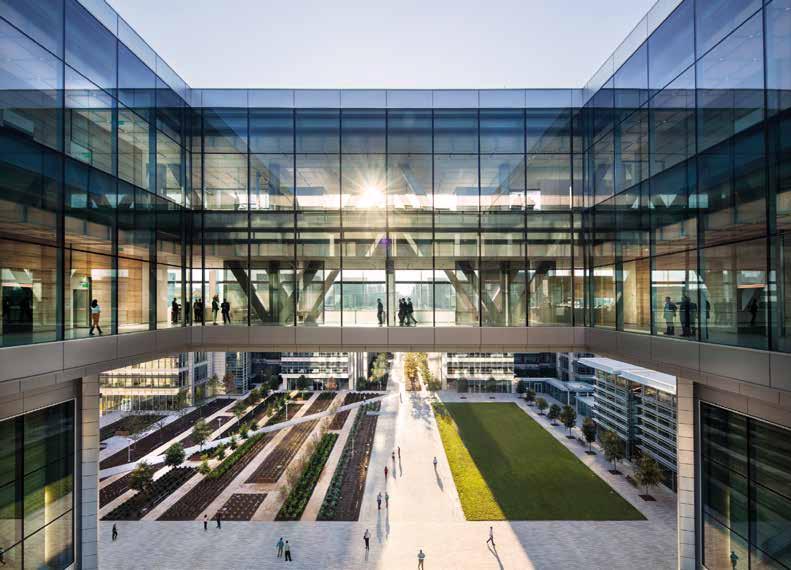
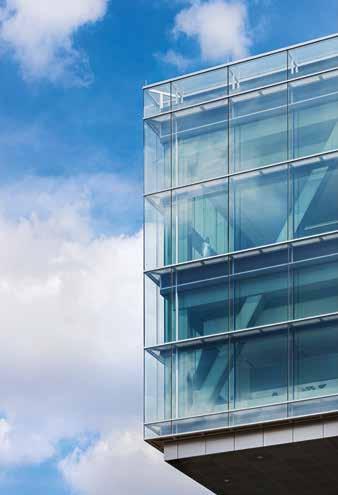 © David Sundberg/Esto
© David Sundberg/Esto
17
© David Sundberg/Esto
River Point
Chicago, Illinois
IN THE SPIRIT of Millennium Park, and Chicago’s current arts-based renaissance, River Point presents a shimmering, curved façade at the confuence the Chicago River and its North Branch in Chicago’s downtown. The convex surface captures natural light for the interior and provides panoramic views outward. The building overlooks not only the river but, from its upper foors, Lake Michigan and Chicago’s bustling downtown.
At the tower’s base, enlivened by shops and restaurants, a 4,860-m2 terraced public park on the riverfront provides a welcome amenity for the West Loop neighborhood. This new civic space, with water features and seating, joins others in encouraging pedestrian activity along downtown Chicago’s unique riverfront.
Location: Chicago, Illinois
Status: Completed in 2017 Size: 111,500 gsm
Certifcation: LEED-CS Platinum
Client (Owner/Developer): River Point LLC (a joint venture of Ivanhoé Cambridge, Hines and Levy Family Partners)
Client (Developer): Hines
Design Architect: Pickard Chilton
Executive Architect: Kendall/Heaton Associates
Structural Engineer: Magnusson Klemencic Associates
MEP Engineer: Alvine Engineering
Landscape: OJB Landscape Architecture
Contractor: Lend Lease
18
 © David Sundberg / Esto
© David Sundberg / Esto
 © David Sundberg/Esto
© David Sundberg/Esto
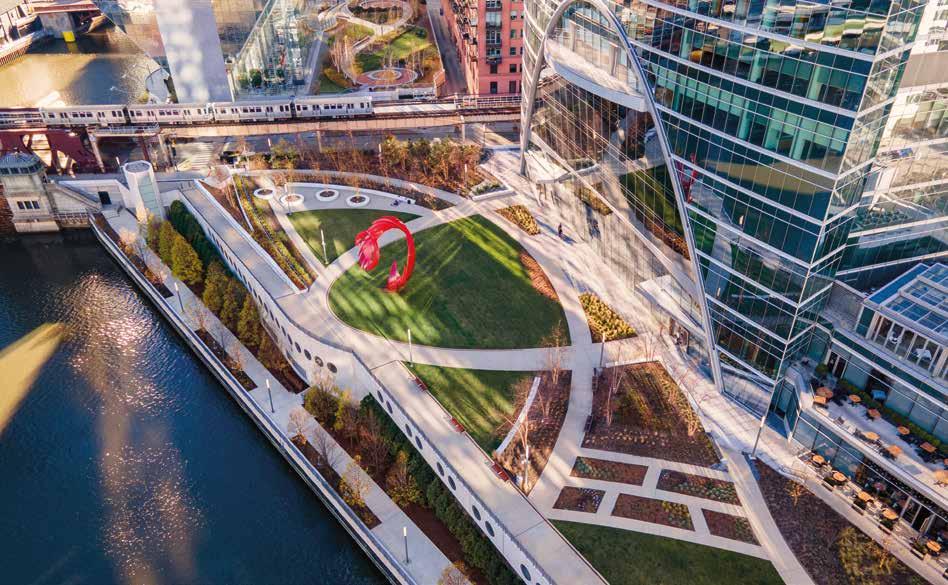

©Pickard Chilton
© Angie McMonigal

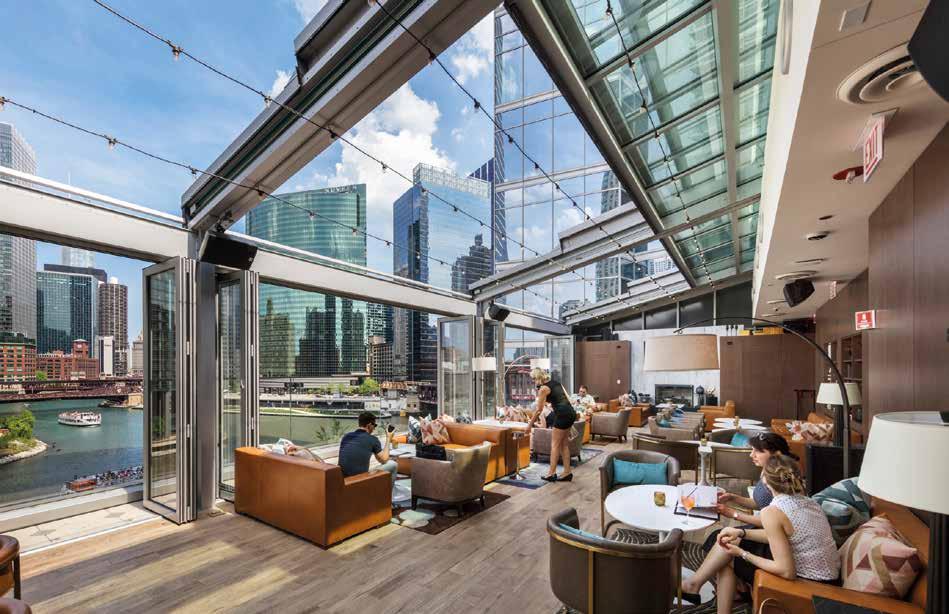 © David Sundberg / Esto
© David Sundberg / Esto
/ Esto
© David Sundberg
EAST ELEVATION 15M 45M 0 30M EAST ELEVATION 15M 45M 0 30M UPPER LOBBY PLAN 5M 15M 30M 0 23
300 North LaSalle
Chicago, Illinois
300 NORTH LASALLE pays homage to Chicago’s tradition of famous, early skyscrapers with richly articulated façades. The project also honors Chicago’s commitment to its public waterfronts. The tower presides over a half-acre, sunlit, riverfront public garden, with landscaped terraces cascading to the Chicago River. With nearly 60 stories of offces, 300 LaSalle boasts shops, restaurants, and public spaces as well as generous sub-grade parking.
The low-E glass façade of the LEED-EB Platinum–certifed building maximizes daylight and views of the city skyline while minimizing solar heat gain. Featuring warm and elegant interior materials, the tower is effcient and fexible in interior planning, has a ffty-percent green roof, and uses condenser water supplied by the river, thus eliminating cooling towers and 38,000 m 3 of evaporation annually.
Location: Chicago, Illinois Status: Completed in 2009 Size: 120,800 gsm Certifcation: LEED-EB Platinum (originally CS-Gold)
Structural Engineer: Magnusson Klemencic Associates
MEP Engineer: Alvine Engineering
Landscape: Wolff Landscape Architecture
Contractor: Clark Construction
Client (Owner/Developer): Hines
Design Architect: Pickard Chilton
Executive Architect: Kendall/Heaton Associates
24
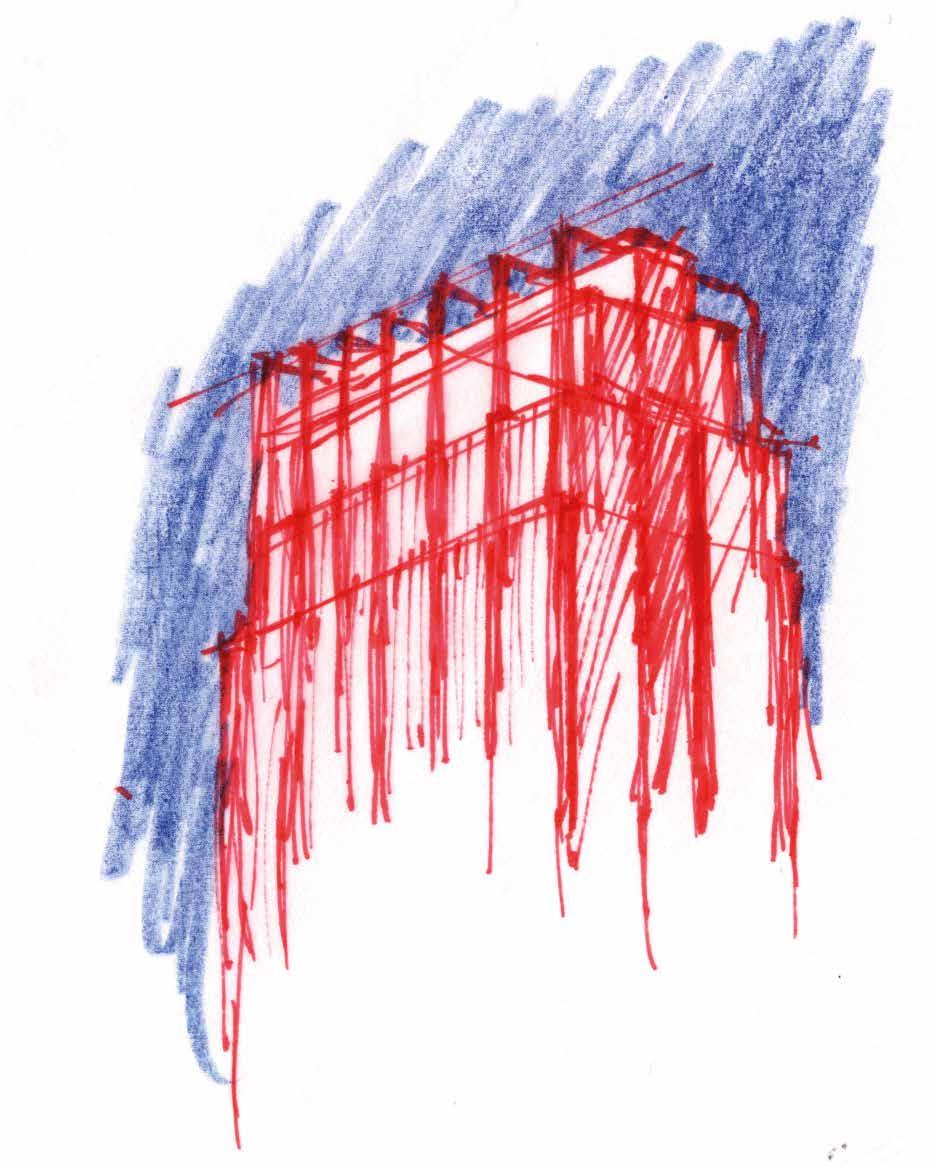
©Pickard Chilton 25
 © Alan Karchmer
© Alan Karchmer
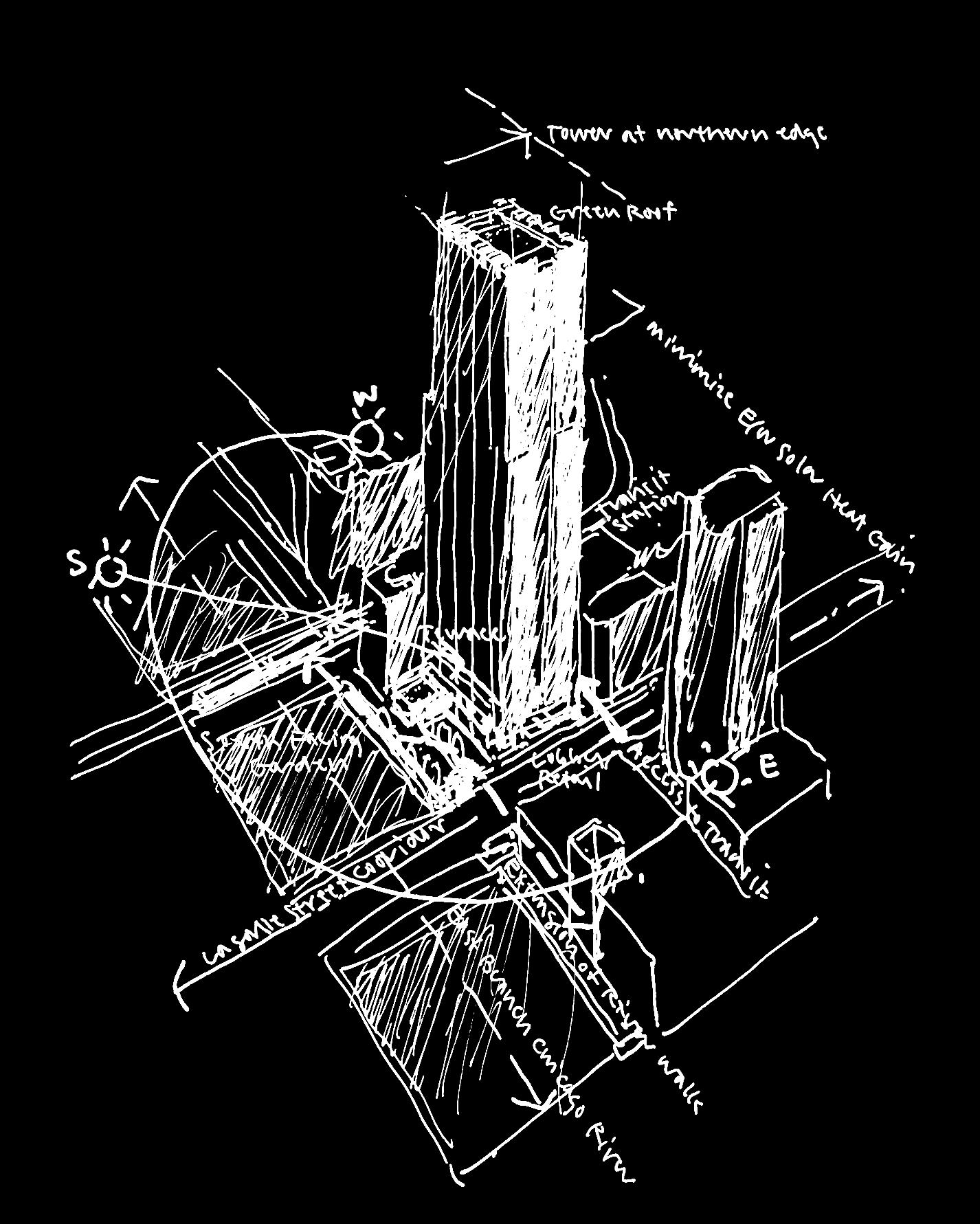
©Pickard Chilton

 © Alan Karchmer
© Alan Karchmer
28
© Alan Karchmer
 © Peter Aaron/Eston
© Peter Aaron/Eston

©Alan Karchmer 30

31
Akamai Headquarters
Cambridge, Massachusetts
145 BROADWAY is the new global headquarters for Akamai Technologies, one of the world’s leading providers of content delivery network services. Located in the heart of Kendall Square, the fastest growing technology hub in the country, the 19-story mixed-use high-performance corporate offce tower comprises approximately 58,000 gsm. Their new headquarters consolidates Akamai’s entire work force from across six disparate locations in Kendall Square into a single unifed vertical campus.
As a major infll urban development, 145 Broadway was the frst phase of a larger three-phase, 92,900-m2 development proposed by Boston Properties. It replaced 11 Cambridge Center, an existing four-story masonry structure.
To offer Akamai the greatest fexibility in creating their new workplace, typical foor plates of approximately 2,322 m 2 feature two large open bars organized around a central core. Typical foor-to-foor heights of 3.6 m allow for ample daylight throughout the workplace as well as expansive views to Cambridge, the Charles River and Boston beyond. Vertical breaks defne the tower’s massing and organize it into clearly expressed elements. Articulated bays and balconies minimize monolithic massing and humanize the scale. Roof terraces created by the building’s interlocking massing relate directly to the important urban pocket park at the building’s front door.
Location: Cambridge, Massachusetts
Status: Completed in 2019
Size: 58,000 gsm
Certifcation: LEED Gold Targeted
Client (Owner/Developer): Boston Properties
Client (Main Tenant/User): Akamai Technologies
Design Architect: Pickard Chilton
Executive Architect: Stantec
Structural Engineer: Magnusson Klemencic Associates
MEP Engineer: BALA
Landscape, Interiors: Sasaki
32

©
Anton Grassl

© Anton Grassi

35
© Anton Grassi

© Anton Grassi

© Pickard Chilton
10M 30M 60M 0 10M 30M 60M 0 LEVEL 10 LEVEL 17 5M 15M 30M 0 LEVEL 6 LEVEL 17 LEVEL 10 LEVEL 6 LEVEL 10 LEVEL 17 SITE PLAN GROUND PLAN 5M 15M 30M LEVEL 6 LEVEL 10 LEVEL 17 38
AXON 5M 15M 30M 0 39
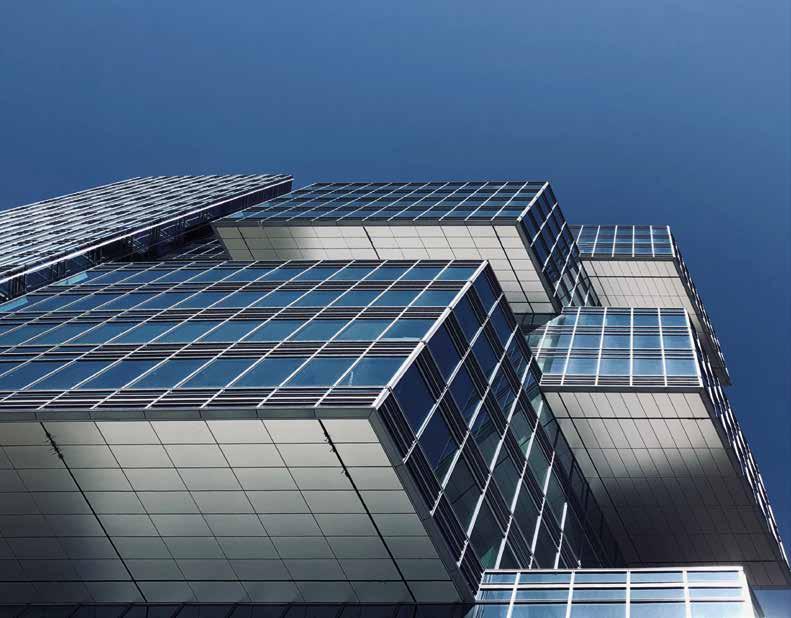
© Pickard Chilton 40

©
Anton Grassi
The Eight
Bellevue, Washington
THE EIGHT is a next-generation Class A commercial offce development in Bellevue’s downtown core that will serve as the gateway to the city center. The Eight’s premier location offers unparalleled connectivity with pedestrian access to both the new light rail station and Bellevue transit center as well as direct freeway access. The site is in close proximity to downtown’s hotels, restaurants and entertainment venues as well as The Bellevue Collection, the region’s major retail destination.
The Eight comprises approximately 45,450 m2 of offce space and fve levels of below-grade parking for tenants. Clad in a high-performance façade, the 25-story tower offers highly effcient foor plates.
The tower’s massing is articulated with exposed structure and balconies
that are interwoven with greenery to knit the building together. Building upon the team’s recent success of 2+U in Seattle, the development will create a wholly unique, activated space dubbed the Living Room. It has been envisioned as a “third place” public amenity for gathering, working, and socialization directly connected to local retail. It is intended that this vitality and connectivity will carry through the entire tower.
Designed to enhance and engage the neighborhood and broader community, it is anticipated that The Eight‘s architecture will raise the design aesthetic in Bellevue, creating a project with a strong visual impact and a compelling design distinguishing it within Bellevue’s burgeoning skyline.
Location: Bellevue, Washington
Status: Completion in 2022 Size: 74,300 gsm
Certifcation: LEED-CS Platinum Anticipated
Client (Owner/Developer): Skanska Commercial Development
Design Architect: Pickard Chilton
Executive Architect: Adamson Associates
Structural Engineer: Magnusson Klemencic Associates
Landscape: Hargreaves Associates
42
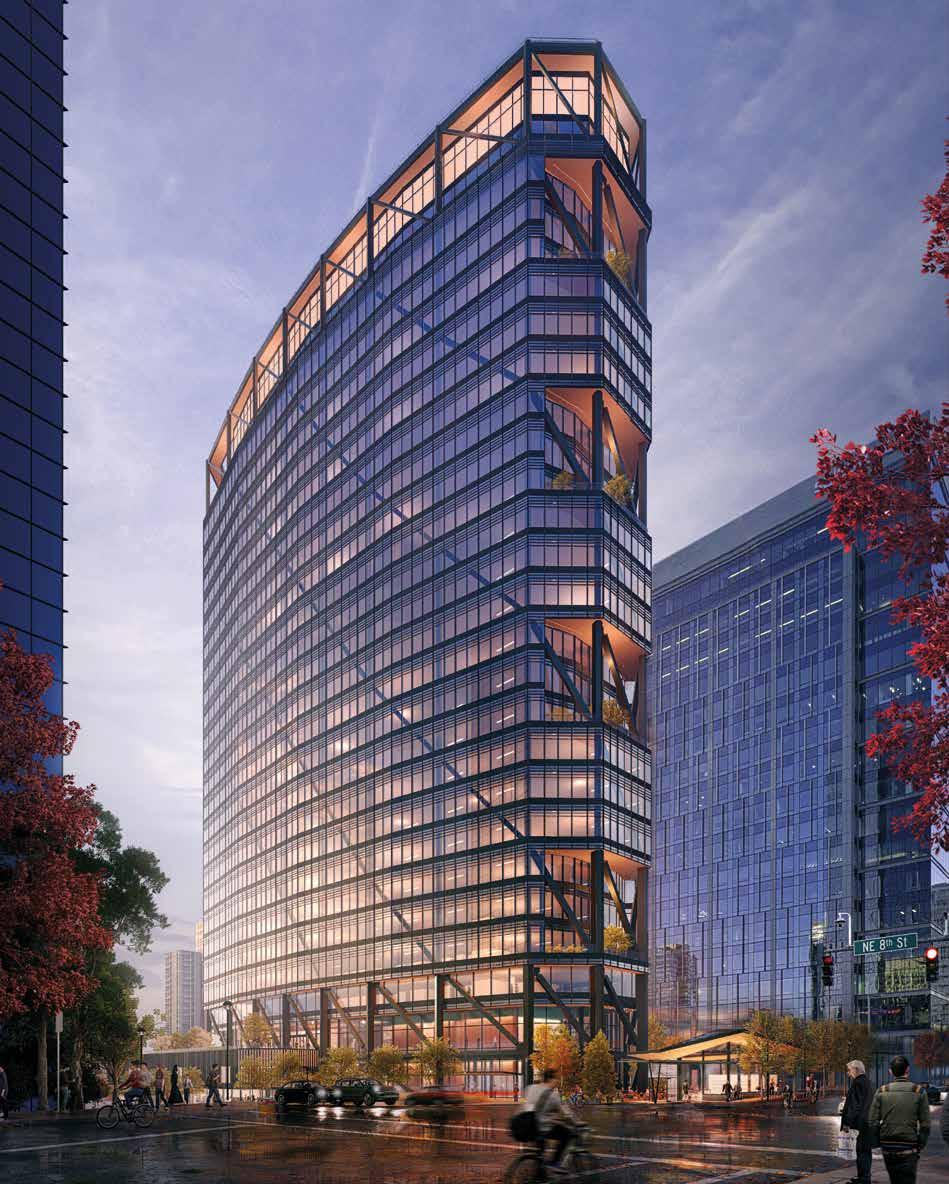
© Pickard Chilton
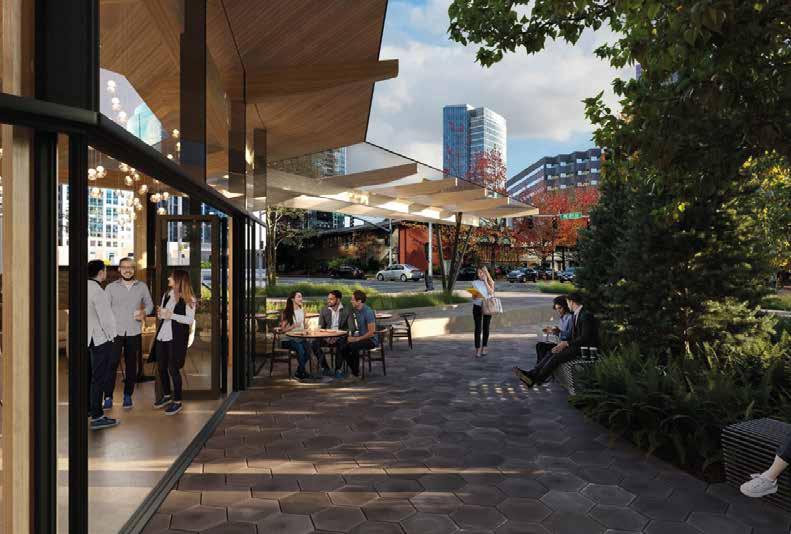
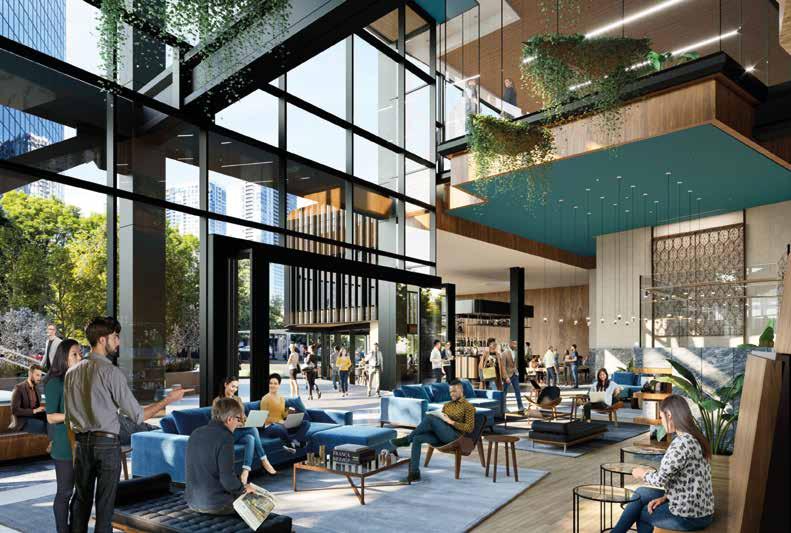 © Pickard Chilton
© Pickard Chilton
44
© Pickard Chilton

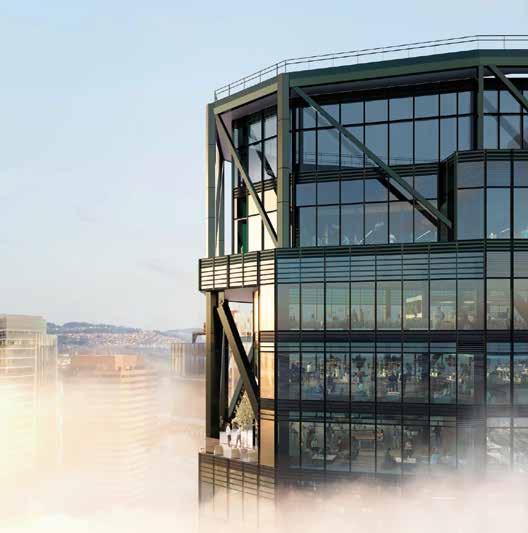 © Pickard Chilton
© Pickard Chilton
45
© Steelblue
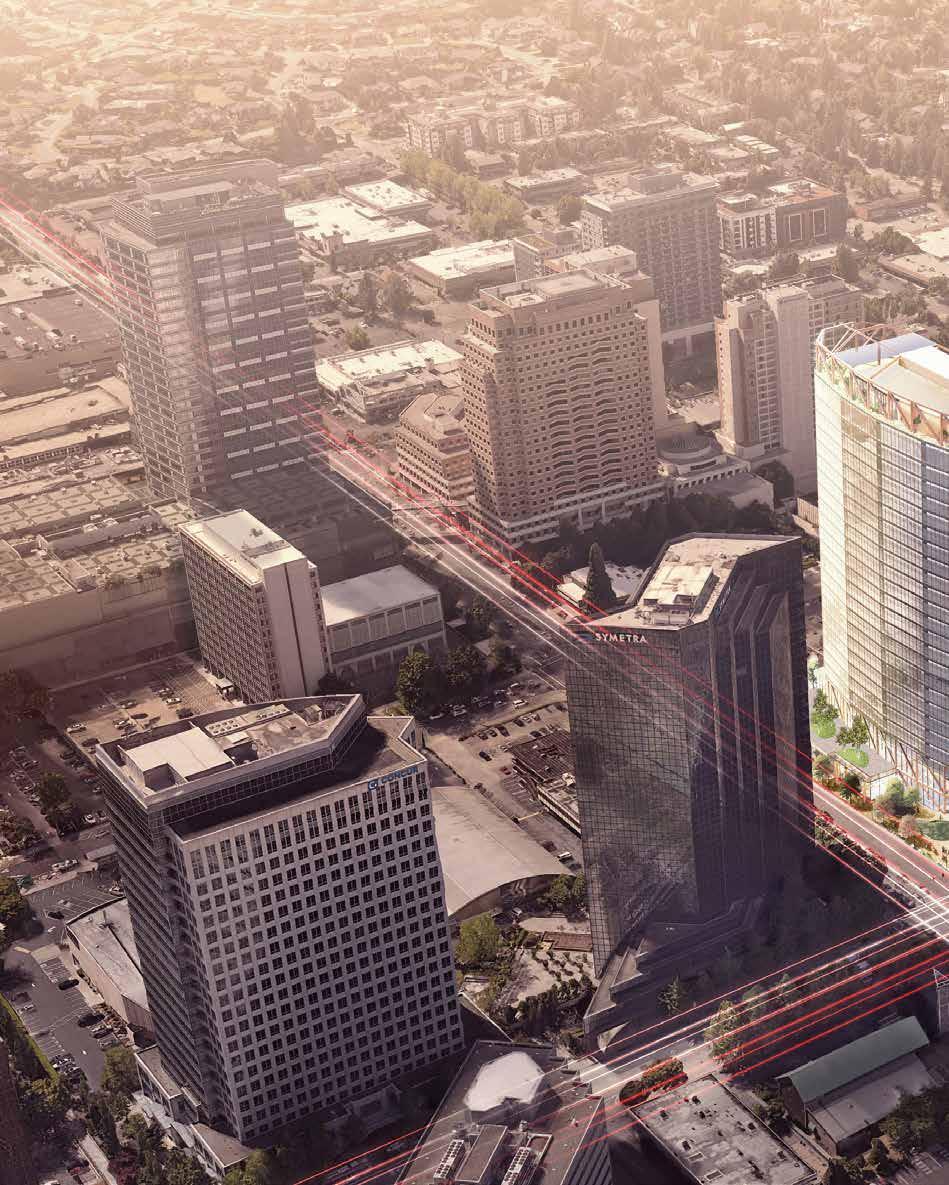

© Pickard Chilton
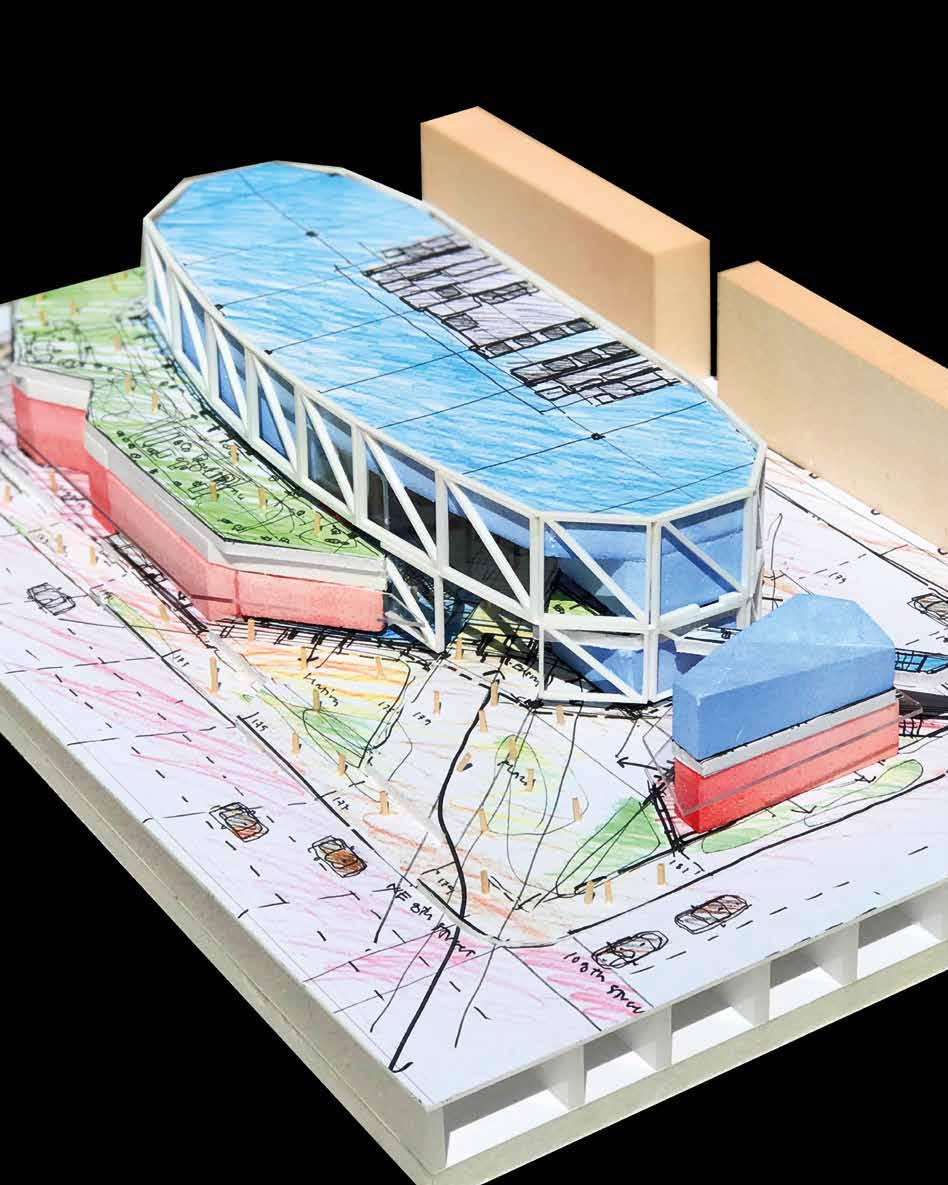

49
© Pickard Chilton
30M AMENITY PLAN 5M 15M 30M 0 HIGH RISE LOW RISE 50

EXPLODED AXON 5M 15M 30M 0 10M 30M 60M 0 SITE PLAN EXPLODED AXON 10M 30M 60M 0
Devon Energy Center
Oklahoma City, Oklahoma
Devon Energy Center: Devon’s new world headquarters serves as a focal point for the company and for Oklahoma City. Characterized by civic-scaled spaces, the corporate headquarters brings Devon’s local workforce together in a single state-of-the-art facility. A six-story glass rotunda with interior balconies serves as the entrance and connecting hub for the entire complex — and a dramatic setting for special events. The fvestory podium houses the conference and training centers and employee amenities. The indoor Galleria includes dining areas overlooking the new park and landscaped plazas that are key elements in the overall site strategy.
The tower’s height and unique three-sided footprint make it a landmark throughout greater Oklahoma City. The uppermost
Location: Oklahoma City, Oklahoma
Status: Completed in 2012
Devon Energy Center Size: 280,000 gsm
Devon Auditorium Size: 1,950 gsm
Certifcation: LEED-NC Gold
portion of the tower tapers slightly to enhance its proportions and to produce an elegant, soaring form. At the tower’s top, each face is chamfered to create a triangular form to refect the sky and offer a subtly changing presence on the skyline. The highly articulated mullion system integrates solar shading and night lighting, and adds richness and texture to the exterior.
Devon Auditorium: Devon Energy commissioned the design of the Auditorium as a part of its new world headquarters, gracing the neighborhood between Oklahoma City’s business and arts districts with an important civic amenity. A delicate, glassenclosed skybridge connects the headquarters to the Auditorium’s second level. The 300-seat auditorium supports the downtown’s
continued on page 60
Client (Owner): Devon Energy
Client (Development Manager): Hines
Master Plan & Design Architect: Pickard Chilton
Executive Architect: Kendall/Heaton Associates
Structural Engineer: Thornton Tomasetti
MEP Engineer: Cosentini Associates
Landscape: OJB Landscape Architecture, Murase Associates
Interiors: Gensler
Contractor: Holder Construction, Flintco 52
 © Joe Aker/Aker
© Joe Aker/Aker
Imaging

 © Alan Karchmer
© Alan Karchmer

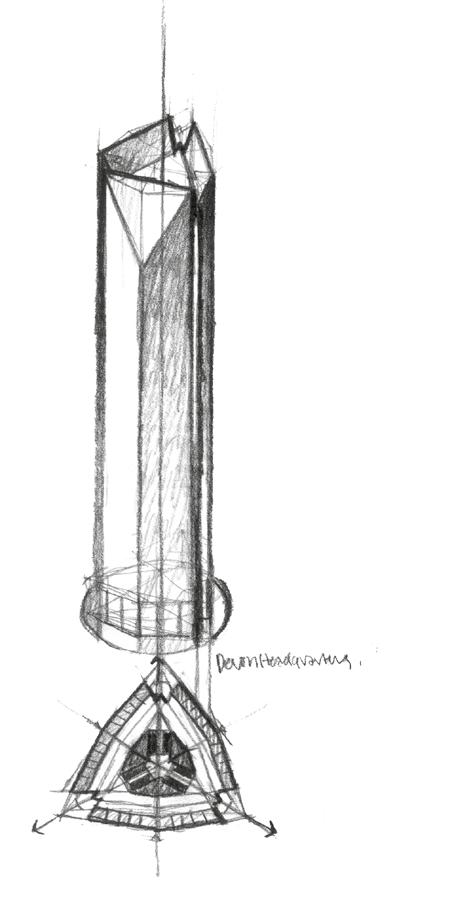


20M 60M 120M 0 TOWER PLAN SITE PLAN © Pickard Chilton 56 20M 60M 120M 0
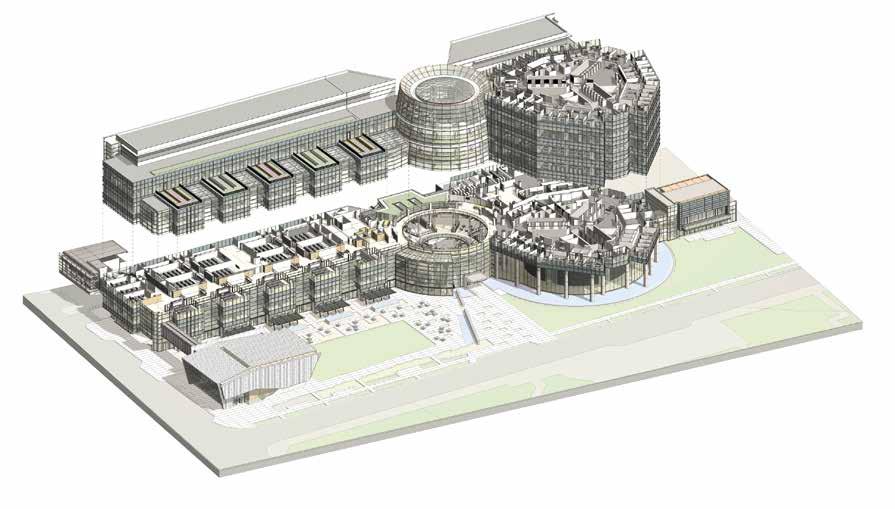
5M 15M 30M 0 GROUND PLAN
© Pickard Chilton 57 5M 15M 30M 0 GROUND PLAN
GROUND PLANE


© Pickard Chilton
58
© Alan Karchmer

 © Pickard Chilton
© Pickard Chilton
59
© Alan Karchmer
from page 52
renaissance, offering a venue for both private and public events, with acoustics designed to serve a range of musical performances.
Pickard Chilton created an intimately scaled gathering hall with a transparency that connects interior events to the surrounding neighborhood, making passersby aware of the activity within.

From its position in a landscaped garden, the Auditorium allows dramatic views of downtown
and the adjacent city park, Myriad Gardens. A double-height lobby with an 11.6-meter angled glass wall projects out toward the street, accentuating the Auditorium’s public profile.
At the entrance, a bank of skylights creates a curtain of daylight above the main stair. The use of warm woods and soft lighting in the seating area enhances the user’s experience, as does a striking view to the garden.
Aker/Aker Imaging 60
© Joe

61
© Alan Karchmer
600 Canal Place
Richmond, Virginia
DOMINION ENERGY’S new corporate offce tower 600 Canal Place is located in the heart of downtown Richmond. The project was designed to promote new ways of working and to enhance productivity and effciencies that will beneft Domonion Energy employees and customers.
Completed in 2019, the 20-story 600 Canal Place is approximately 92,000m2 and occupies a full city block. It includes a highperformance workplace for over 1,000 employees, street-level retail, employee amenities and parking.
The 600 Canal Place development offers dramatic views of the James River and downtown Richmond and establishes a new identity for Dominion and the city. The towers’ curved forms are inspired by the shape of a full sail, and diagonal rods on the façade further emphasize the metaphor.
600 Canal Place achieved LEED Gold and integrates a range of sustainability strategies including a high-performance exterior enclosure, energy effcient mechanical/ electrical systems, and an exterior landscaped terrace.
Location: Richmond, Virginia
Status 600 Canal Place: Completed in 2019
Size: 92,900 gsm
Certifcation: LEED-NC Gold
Client (Owner): Dominion Energy
Design Architect: Pickard Chilton
Executive Architect: Kendall/Heaton Associates
Structural Engineer: Magnusson Klemencic Associates
MEP Engineer: Alvine Engineering
Landscape: OJB Landscape Architecture
Interiors: PDR
Contractor: Hourigan, Clayco
62
 © David Sundberg/Esto
© David Sundberg/Esto
TYPICAL TOWER PLAN GROUND PLAN





GROUND
64
PLAN
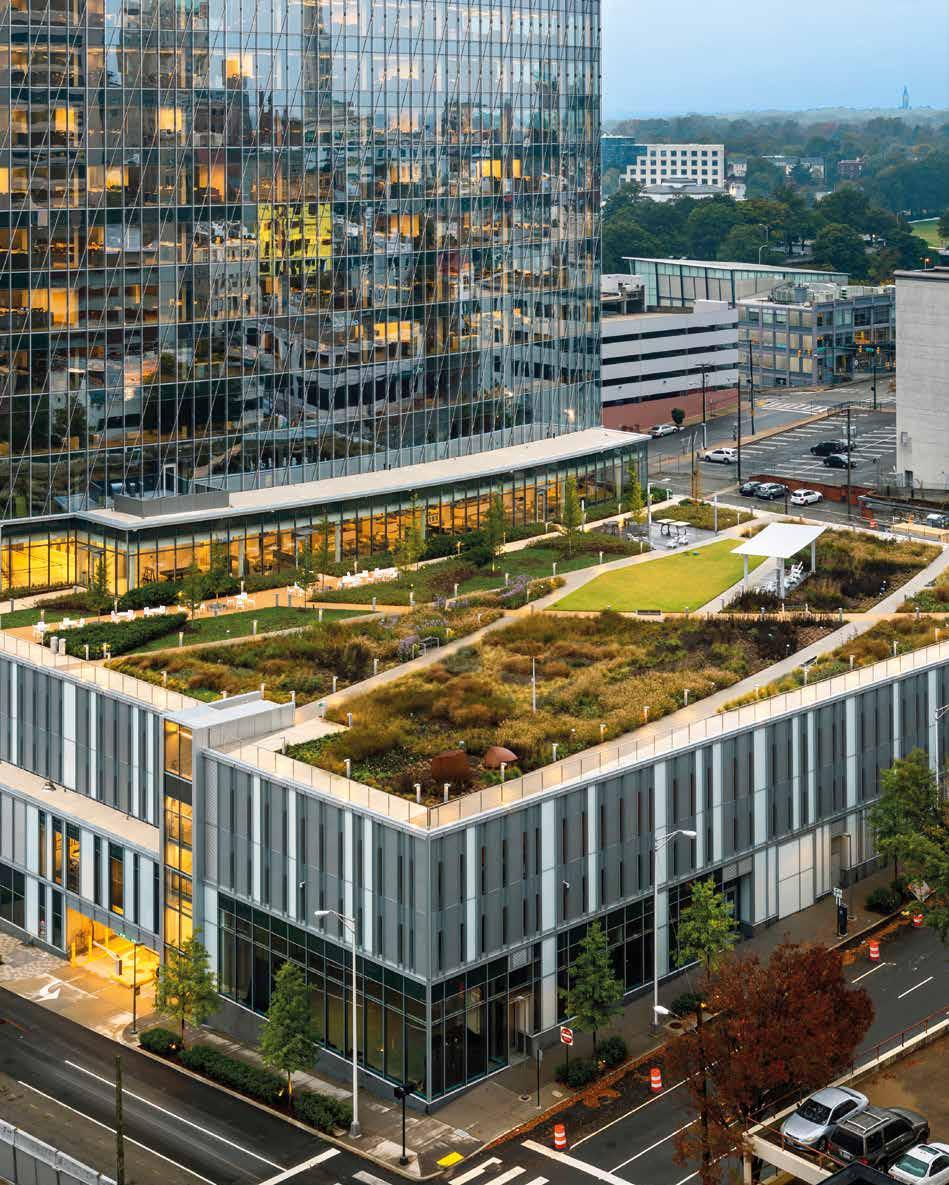
© David Sundberg/Esto
 ©
©
66
David Sundberg/Esto

Sundberg/Esto
© David

© David Sundberg/Esto 68
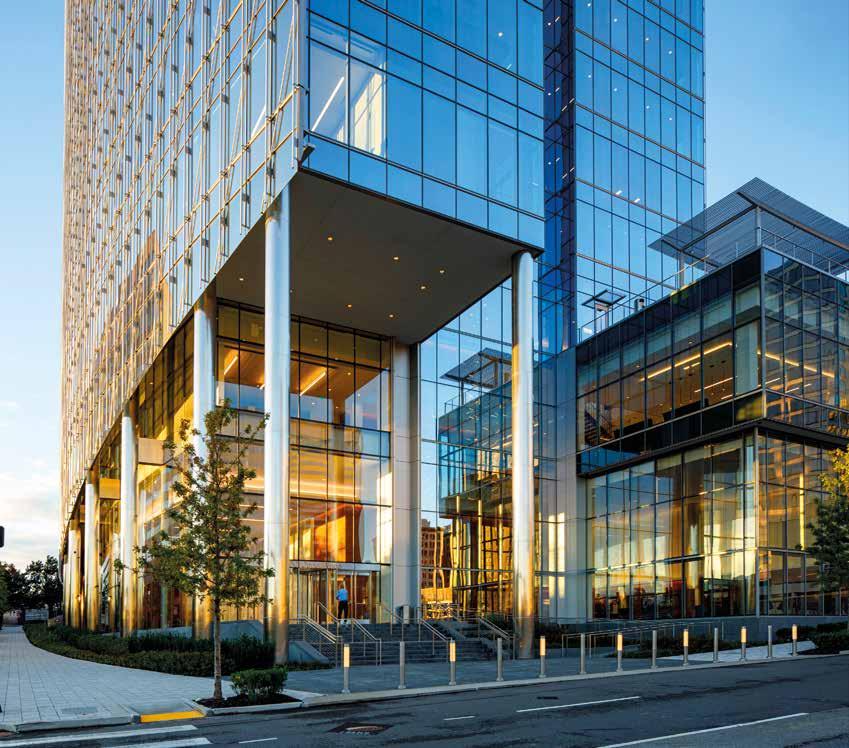
69
© David Sundberg/Esto

6 © David Sundberg/Esto

71
© David Sundberg/Esto
Norfolk Southern Headquarters Atlanta, Georgia
LOCATED on a three-acre site near Technology Square in Midtown Atlanta, Norfolk Southern’s new high-performance headquarters has been designed as an effcient, next-generation urban campus that reimagines the employee work environment and experience.
Composed of two offce towers, the complex is unifed by a fvestory campus-style hub that serves as a destination for employees to work and socialize. The hub also features multiple roof terraces as well as parking for 2000 cars. The entire development is clad in a highperformance enclosure with foorto-ceiling glass to maximize daylight and views.
On-site employee amenities include a vibrant on-site dining facility, an adjacent rooftop garden and private greenspace, a comprehensive ftness center, state-of-the-art conference and training facilities, on-site childcare, and a variety of workspaces to serve employees’ diverse needs while fostering interaction and collaboration. At the corner of West Peachtree Street and Ponce de Leon Avenue, an outdoor public entry plaza welcomes both employees and the public. The headquarter was occupied in November 2021.
Location: Atlanta, Georgia
Status: Completion in 2021 Size: 92,903 gsm
Certifcation: LEED-NC Gold Anticipated
Client: Norfolk Southern
Developer: Cousins Properties
Design Architect: Pickard Chilton
Executive Architect: HKS
Structural Engineer: Uzun + Case
MEP Engineer: Integral Consulting Engineering
Landscape: OJB Landscape Architecture
Interiors: HOK
Contractor: Holder Construction
72

© Pickard Chilton
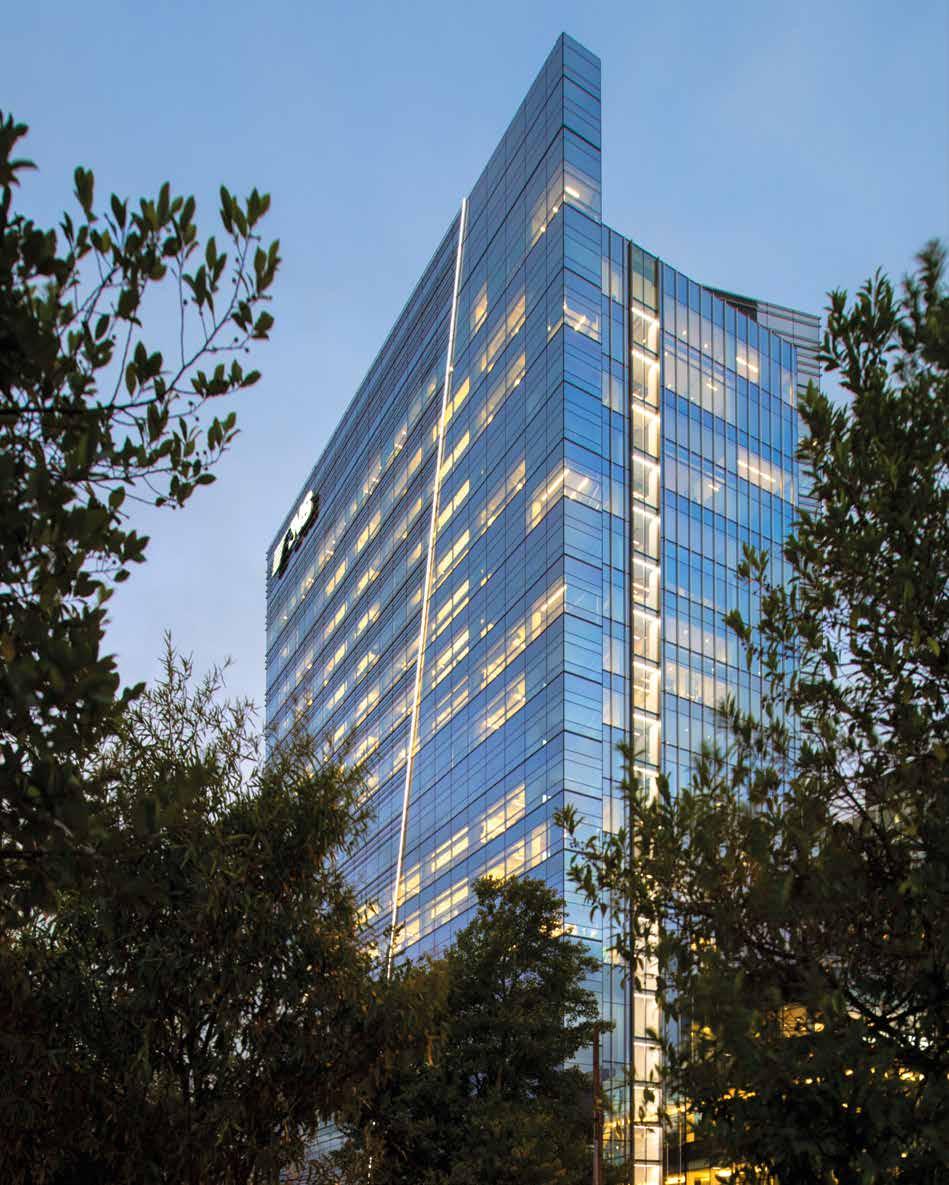
© Pickard Chilton

75
5M 0 5M 15M 30M 0 LEVEL 10 15M 30M LEVEL 5 5M 15M 30M 0 GROUND PLAN 5M 15M 30M 0 5M 0 GROUND PLAN LEVEL 10 LEVEL
76
5
15M 30M 10M 30M 60M 0 SITE PLAN SITE PLAN ELEVATION 10M 30M 60M 0 SITE PLAN 5M 15M 30M 0
 © Pickard Chilton
© Pickard Chilton
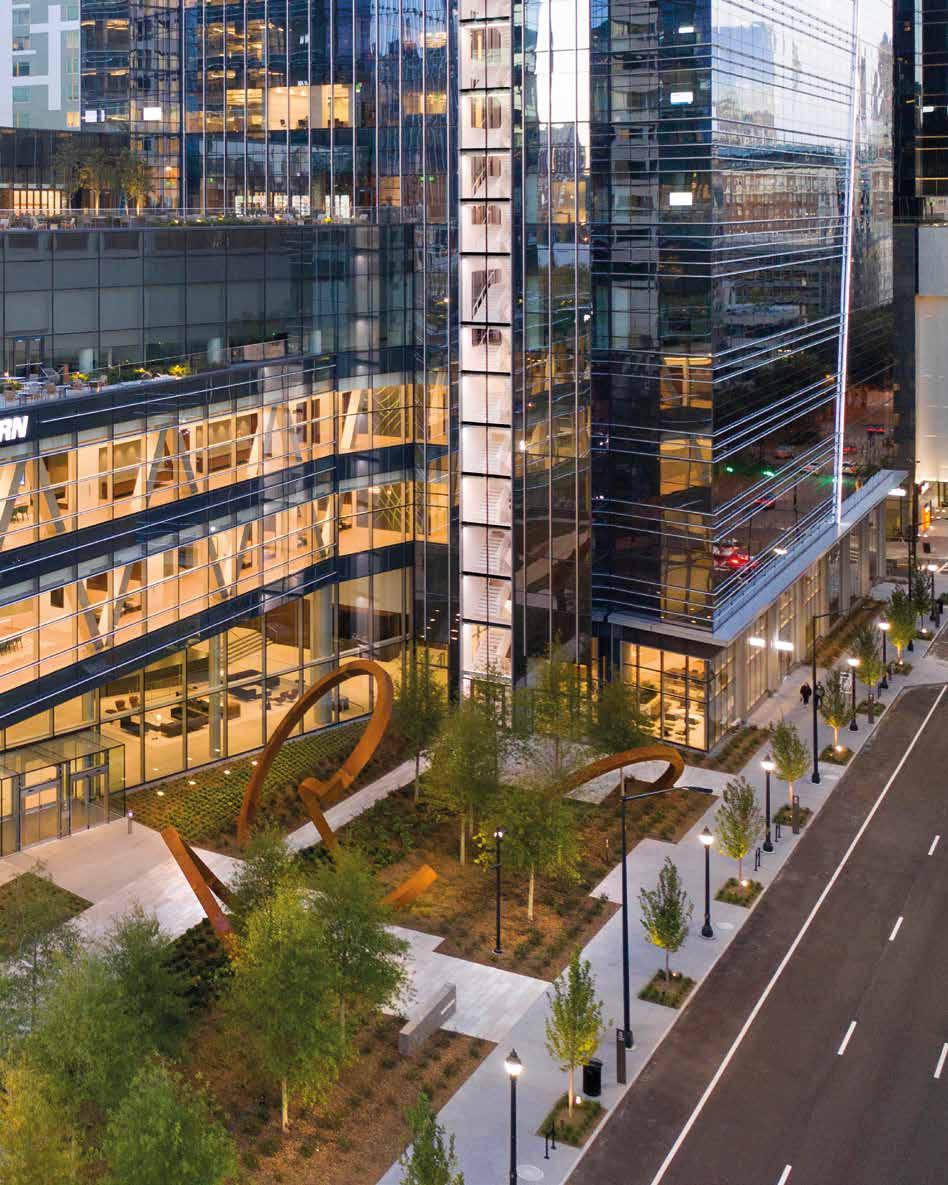
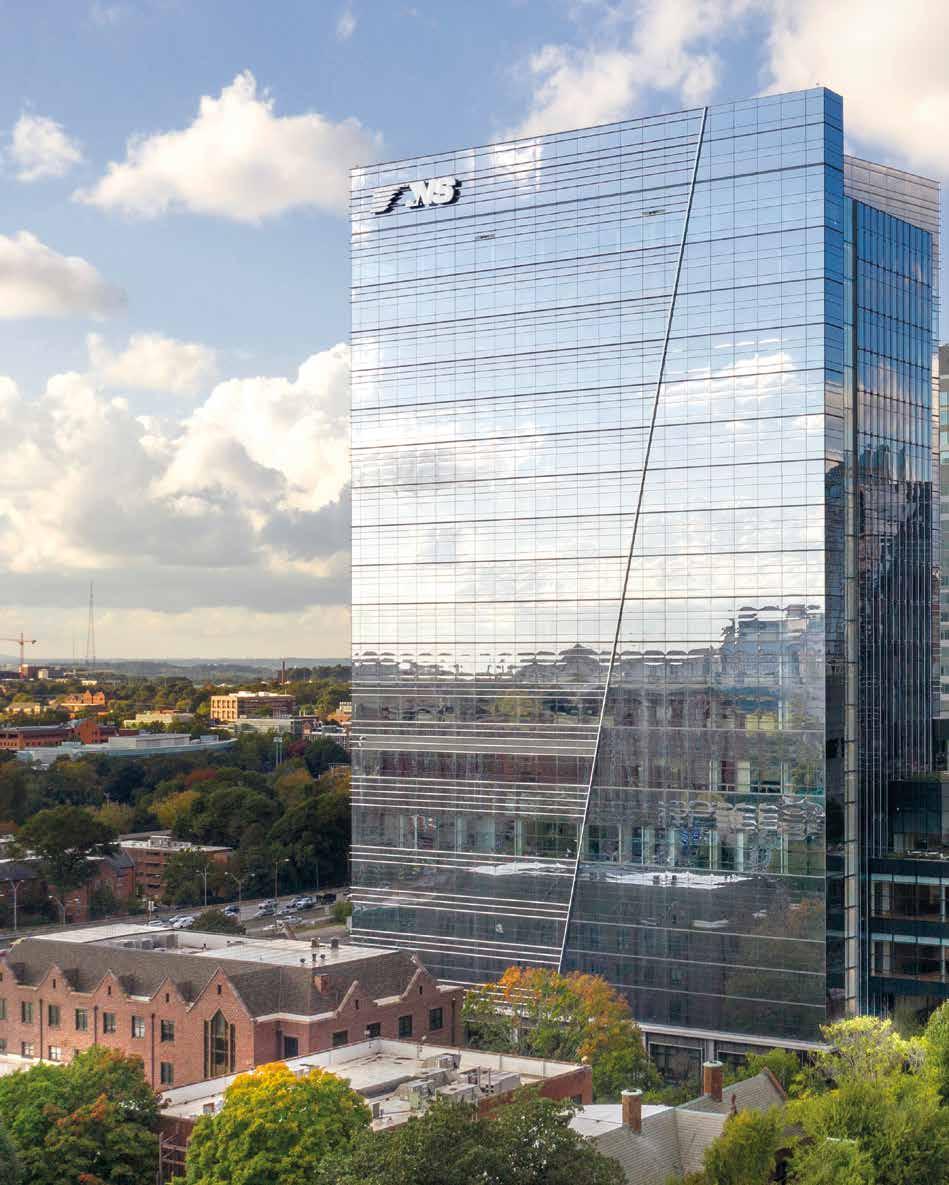

© Pickard Chilton
2+U
Seattle, Washington
2+U creates a space for the community in the heart of downtown Seattle. Located next to the Seattle Art Museum, the project knits together the Waterfront, Business District, and Arts District by lifting the tower 26 meters above the street, providing connectivity at the pedestrian scale, and views through the block to Elliott Bay.
Conceived during a “design hack-athon” selection process, the concept for 2+U creates a strong connection between the building’s form and the Northwest’s character, resulting in a true Pacifc Northwest building. Sharing the block with the Diller Hotel, 2+U is sensitively designed to respond to the iconic 1890 brick structure. Four low-rise buildings hold the street edge around base of the tower, mapping onto the datums set by the Diller, and responding to its materiality with a layered terracotta façade.
The space beneath the elevated tower creates a high forest-like canopy above 2,230 square meters of publicly accessible open space that serves the entire neighborhood. Envisioned a frst-of-its-kind Urban Village, this multi-level pedestrian experience traverses a 10-meter grade change within a network of ramps, steps, and terraces that recall the passages at nearby Pike Place Market. Publicly accessible elevators and ramps ft seamlessly within the city’s system of hill-climb assists, to help people of all abilities.
While the tower above provides year-round weather protection akin to a tree canopy’s warmth and comfort, the dynamic open-air retail experience below serves as a gathering space for the public. With fve access points, the Urban Village fuses local retail, art, culture, and nature to offer 1,487 square meters
continued on page 89
Location: Seattle, Washington
Status: Completed in 2020
Size: 92,900 gsm
Certifcation: LEED-CS Platinum
Client (Owner/Developer): Skanska Commercial Development
Design Architect: Pickard Chilton
Executive Architect: Kendall/Heaton Associates
Structural Engineer: Magnusson Klemencic Associates
MEP Engineer: WSP
Landscape: Swift Company
Contractor: Skanska USA Building 82
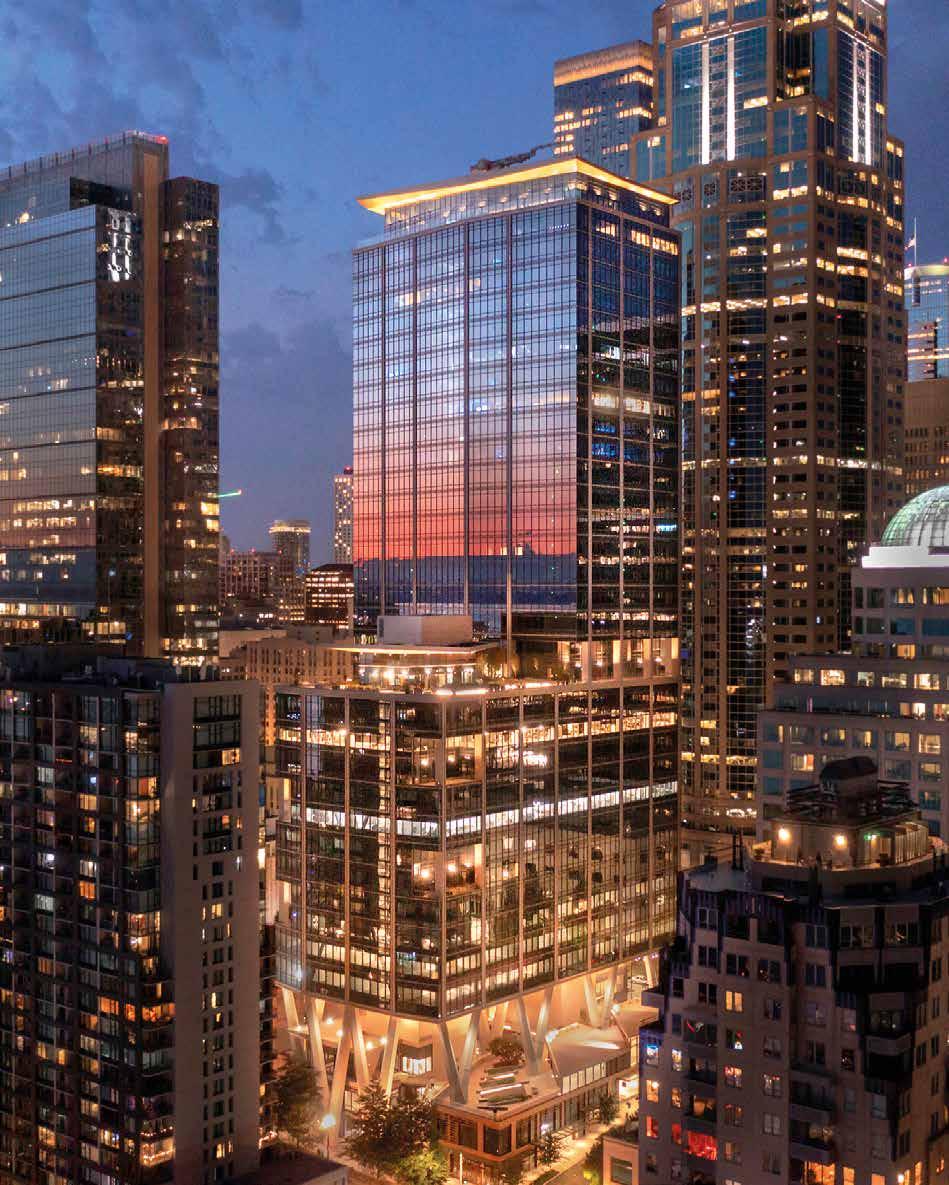 © David Sundberg/Esto
© David Sundberg/Esto
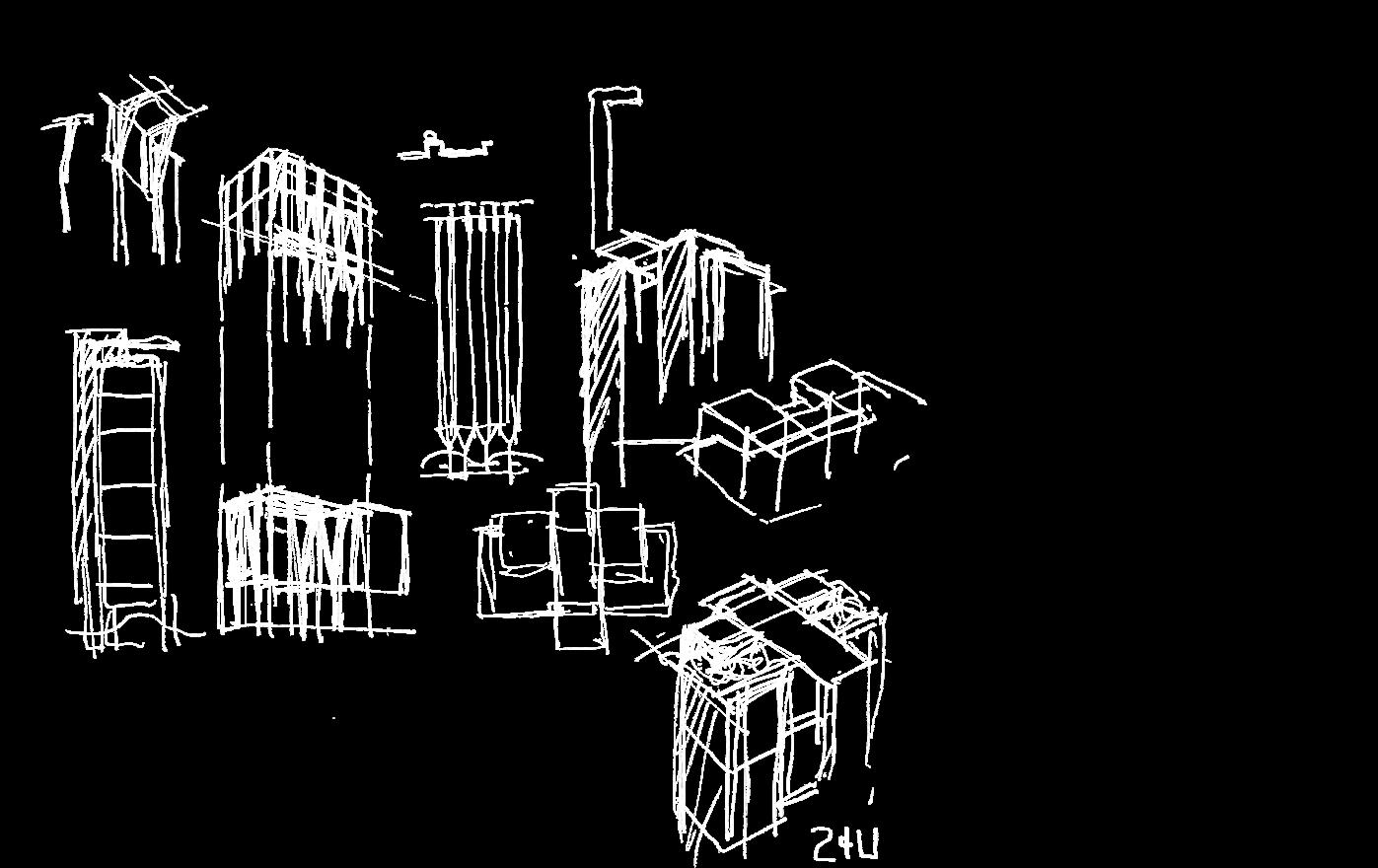

 ©Pickard Chilton
©Pickard Chilton

©Pickard Chilton 85
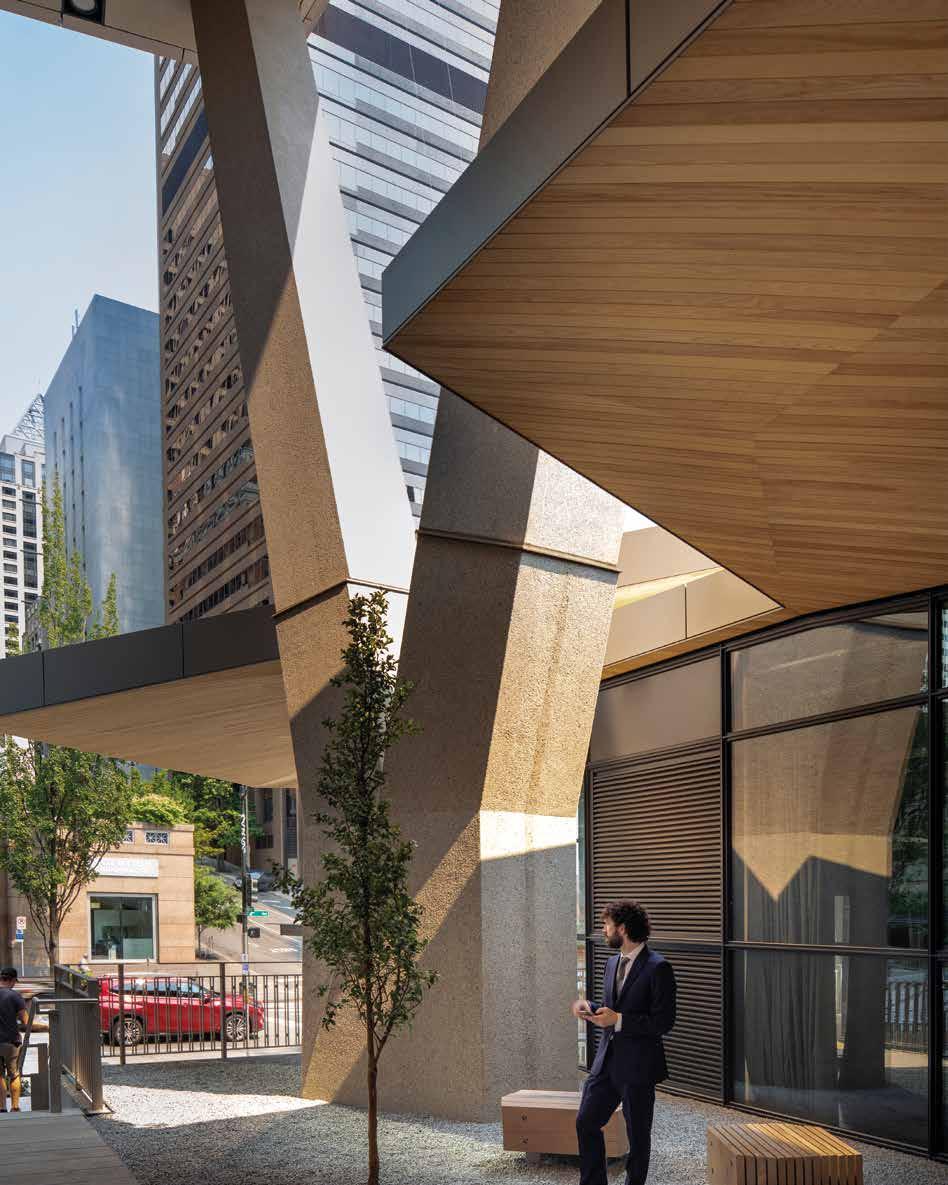 © David Sundberg/Esto
© David Sundberg/Esto
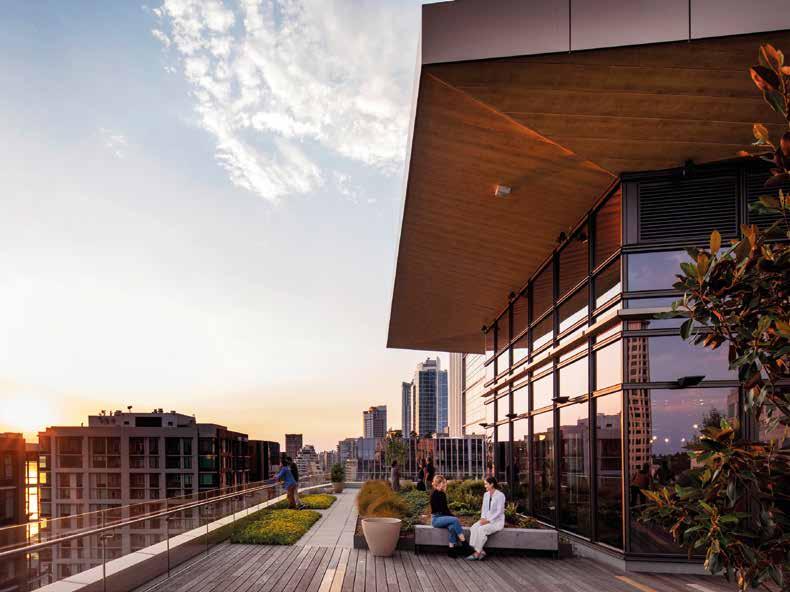
 © David Sundberg/Esto
© David Sundberg/Esto
87
© David Sundberg/Esto
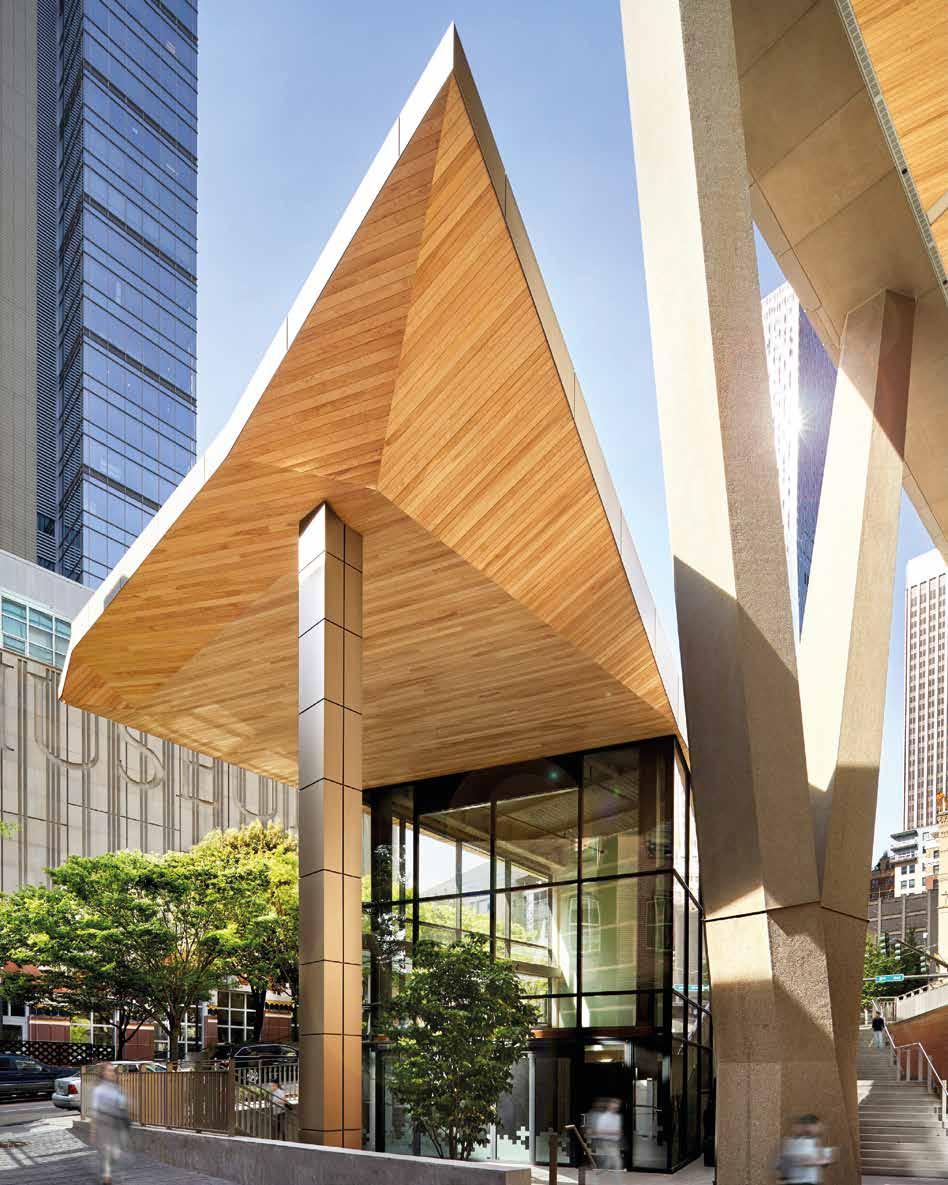
Sundberg/Esto
© David
of restaurant and retail space and The Studio, a free community arts and culture space. Designed to be a very porous and welcoming pedestrian experience, the village also accommodates event and entertainment spaces and large-scale art opportunities within the public plaza.
Collaborating with a multidisciplinary team committed to sustainable, high-performance solutions, the project began with a sustainability visioning session that shaped the design process. Impactful goals included maximizing daylight, optimizing
energy effciency while exceeding the stringent Seattle Energy Code and minimizing water usage. Designated LEED-CS Platinum, the 162-meter Class-A offce tower comprises a 19-story podium and 38-story tower. A side core allows for open foor plates with unobstructed views of Puget Sound and natural daylight in the tower’s toilet rooms and main egress stairs. The energy effciency of the tower is made possible in part by an active chilled beam system. Bioretention planters on multiple levels and a drought-tolerant garden on the level 19 terrace serve to mitigate runoff.

89
© Benjamin Benschneider
from page 82
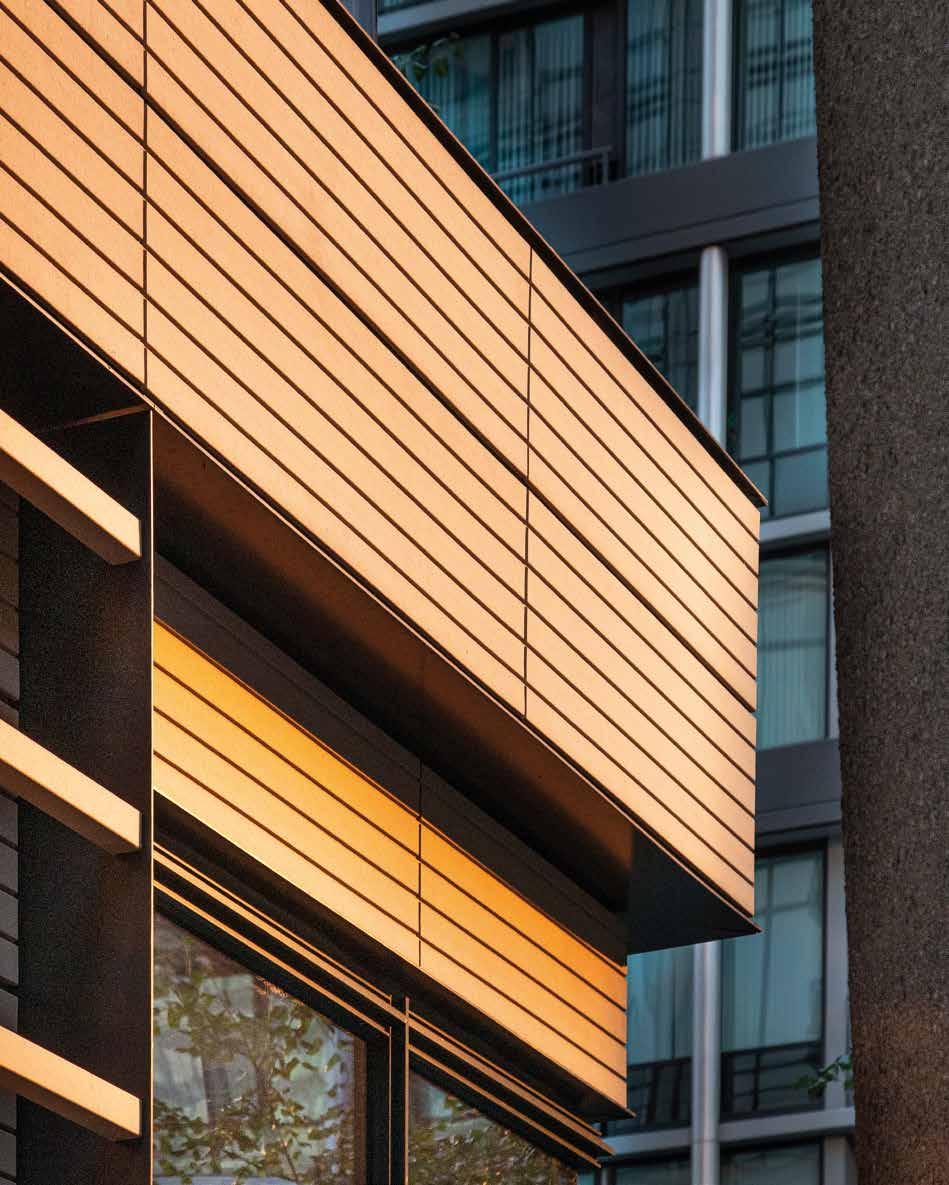 © David
© David
Sundberg/Esto
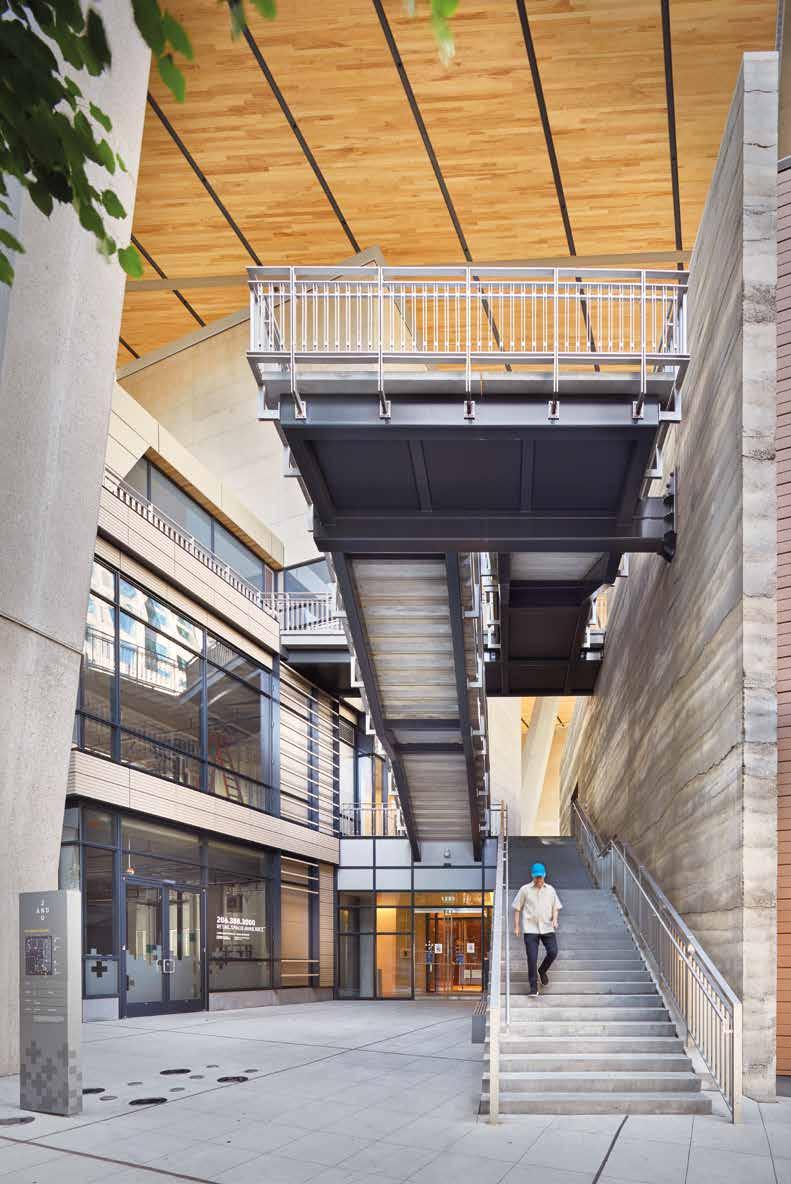
91
© David Sundberg/Esto
Tokyo Midtown Yaesu
Tokyo, Japan
ENVISIONED AS AN Integrated and human-scaled urban community, the Tokyo Midtown Yaesu Project is a 297,000-m2 high-rise mixeduse development comprising offce space, a luxury Bulgari Hotel and an elementary school atop a retail podium and a below-grade transportation hub. It offers direct access to Tokyo Station, one of the most important traffc nodes in Japan.
The 240-meter tower’s façade is gently curved to subtly contrast with the surrounding buildings. At the Northeast corner, the tower engages the ground to emphasize its verticality
and to offer a clear identity for the main entry. The exterior form of the elementary school is expressed with an articulated louvered façade that provides shading and allows for landscaped classroom balconies.
The curved podium echoes the gentle radius of the tower façade. Visitors rise through a cascade of escalators from the subterranean levels of Tokyo Station, through the podium retail levels to the Yaesu GRANROOF. Skylights allow sunlight to stream into the atrium and further down into the B1 level.
Location: Tokyo, Japan
Status: Completion in 2022 Size: 297,000 gsm
Client (Developer): Mitsui Fudosan
Design Architect: Pickard Chilton
Executive Architect: Nihon Sekkei
Contractor: Takenaka Corporation
92
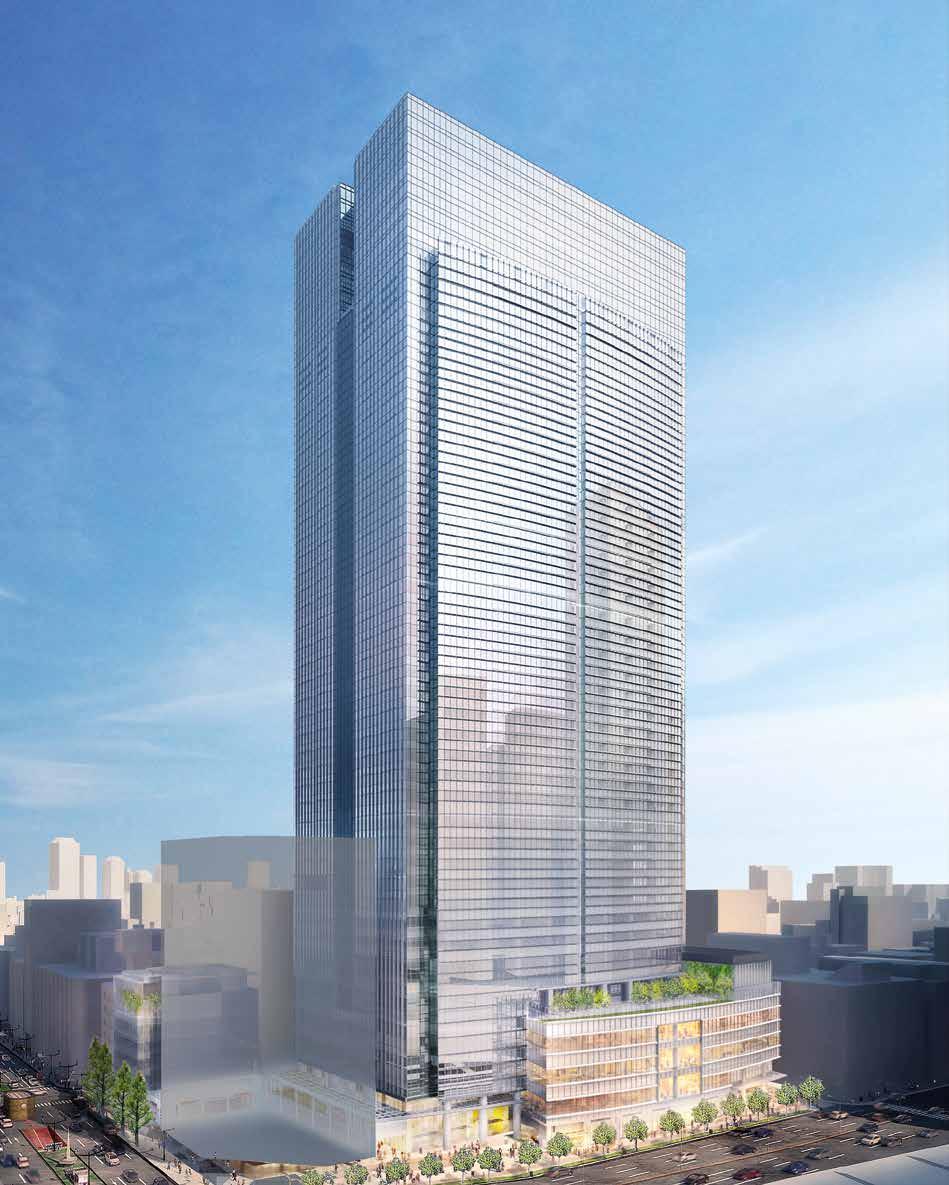
© Pickard Chilton

© Pickard Chilton
AMENITY
PLAN
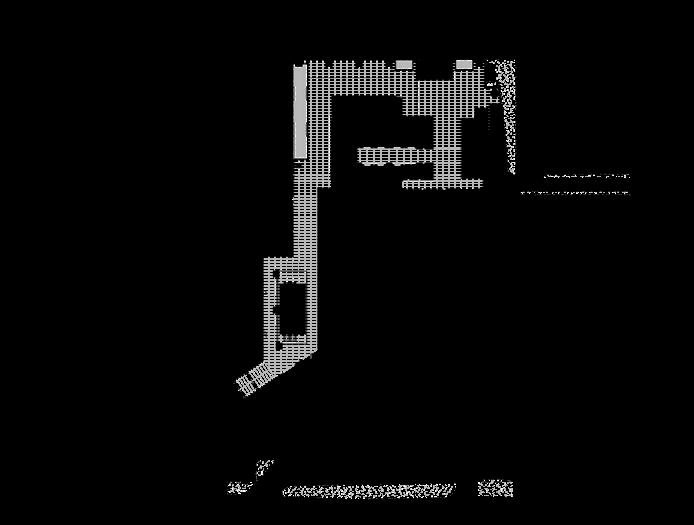

TYPICAL OFFICE
GROUND PLAN SITE PLAN


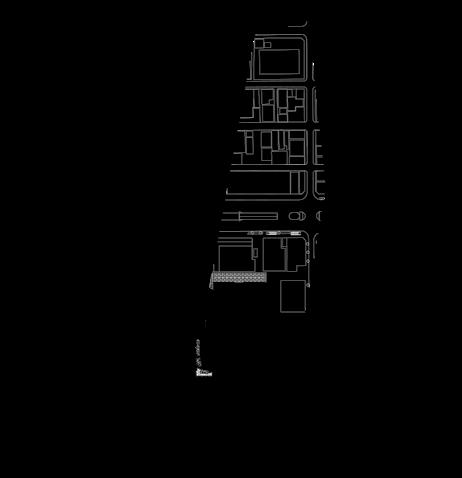

95
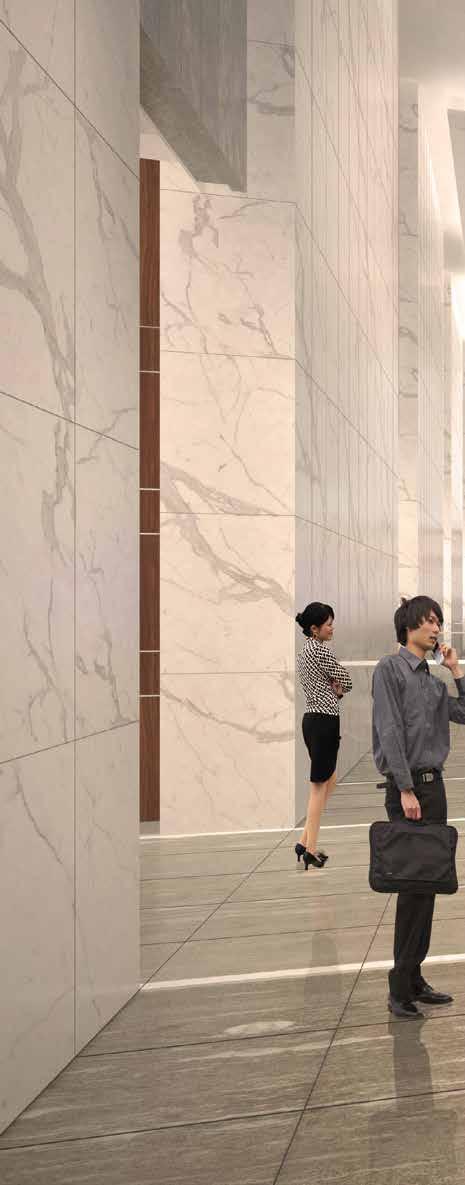

© Pickard Chilton 96

© Pickard Chilton


98
© Pickard Chilton
© Pickard Chilton

99 © Pickard Chilton
609 Main
Houston, Texas
609 MAIN IS a 48-story Class-A next-generation offce tower that offers a signature presence in the Houston skyline and contributes to the vitality of the Central Business District. At the nexus of the Metro and bus lines, the tower also offers a direct connection to the downtown pedestrian tunnel system.
The sustainably-designed offce tower is clad in a high-performance enclosure with low-E foor-to-ceiling glass. Effcient and fexible 2,600-m2 foor plates accommodate a variety
of uses, allow daylight deep into the building and offer panoramic views. Effcient building systems include under foor HVAC, “smart” elevators, and a sophisticated safety system. The podium conceals parking for 1,500 cars and features an expansive urban roof garden.
The lobby features a modern café and a digital working bar. Amenities include a conference facility, a fne dining restaurant, and a ftness center.
MEP
(Owner/Developer):
Architect:
Architect:
Associates
Engineer:
Location: Houston, Texas Status: Completed in 2017 Size: 97,500 gsm Certifcation: LEED-CS Platinum Client
Hines Design
Pickard Chilton Executive
Kendall/Heaton
Structural
Ensight Haynes Whaley
Engineer:
ME Engineers
100
Landscape: OJB Landscape Architecture Contractor: Harvey Builders
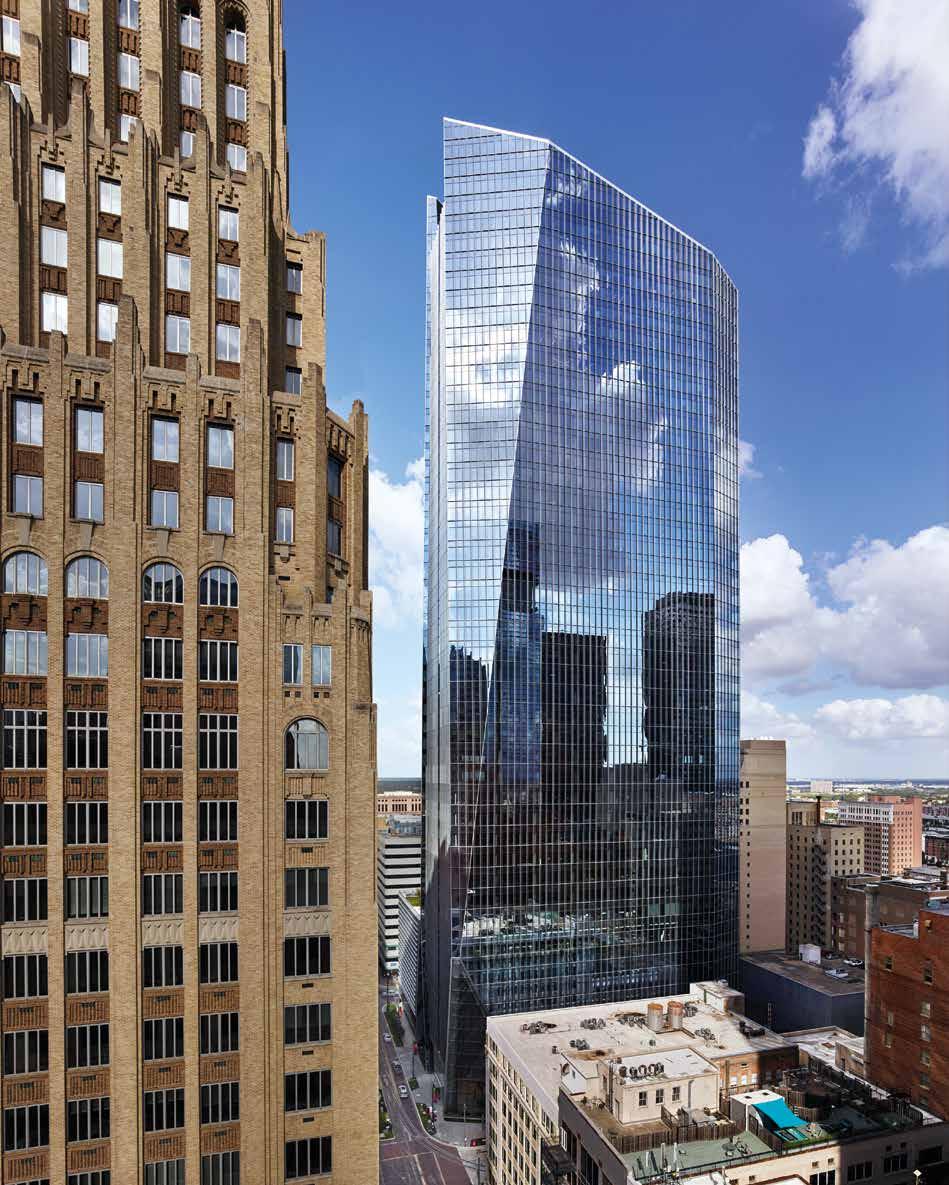
Karchmer/OTTO
© Alan
10M 30M 60M 0
5M 15M 30M LEVEL 47 LEVEL 12 LEVEL 12 LEVEL 47 ELEVATION 5M 15M 30M 0 102
SITE PLAN SITE PLAN
ELEVATION 5M 15M 30M 0 ELEVATIONELEVATION 5M 15M 30M 0 103

 © Joe Aker/Aker
© Joe Aker/Aker
Imaging
104
© Alan Karchmer/OTTO

Alan Karchmer/OTTO
©
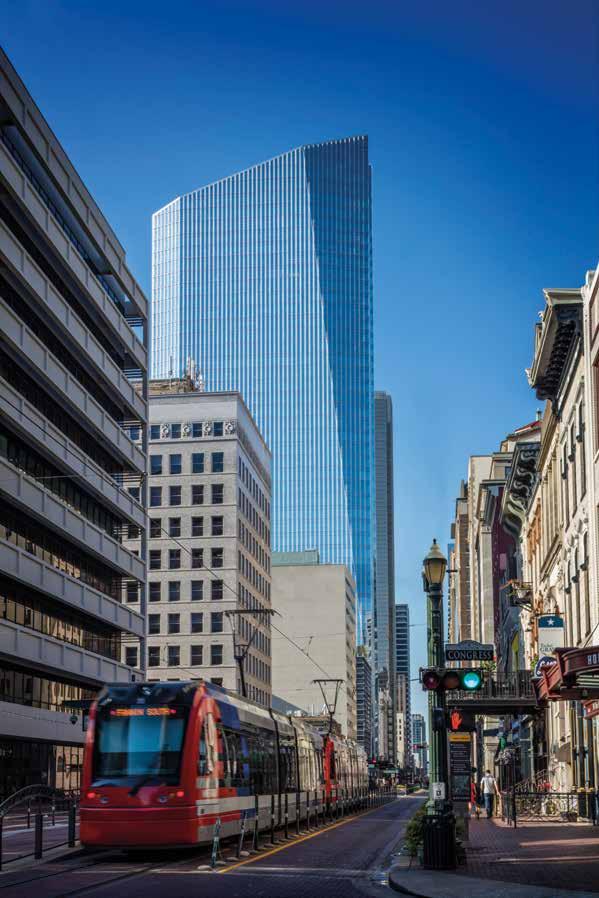 © Joe Aker/Aker Imaging
© Joe Aker/Aker Imaging
 © Joe Aker/Aker Imaging
© Joe Aker/Aker Imaging
Northwestern Mutual Headquarters
Milwaukee, Wisconsin
THE NORTHWESTERN MUTUAL
Tower and Commons create a highperformance urban campus that engages employees and the city of Milwaukee, while embodying Northwestern Mutual’s longstanding values.
Implementing best practices in workplace design, the elegant 32-story glass offce Tower’s gently curved form at the eastern edge of the campus embraces the gardens and maximizes panoramic views. It culminates in a crisp prow marking its position overlooking Lake Michigan and serves as a proud beacon.
As the heart of the project, the Commons creates a cohesive,
Location: Milwaukee, Wisconsin
Status: Completed in 2017
Size: 102,100 gsm
Certifcation: LEED-NC Gold
clearly organized campus that serves the entire Northwestern Mutual family. The Commons provides training facilities, meeting spaces, dining, and terraces that overlook their enhanced gardens. Nestled in the historic 1914 headquarters, a skylit atrium knits together the old with the new.
Reinforcing Northwestern Mutual’s commitment to Milwaukee, ground-level concourses, exhibits and dining spaces welcome visitors. The three-acre gardens and pedestrian-oriented streetscapes will reinvigorate the lakefront district’s urban vitality.
Client (Owner): Northwestern Mutual
Client (Development Manager): Hines
Executive Architect: Kendall/Heaton Associates
Structural Engineer: Magnusson Klemencic Associates
MEP Engineer: Alvine Engineering
Landscape: OJB Landscape Architecture
Interiors: Valerio Dewalt Train Associates
Contractor: Gilbane Building Company, CG Schmidt
108

© Pickard Chilton
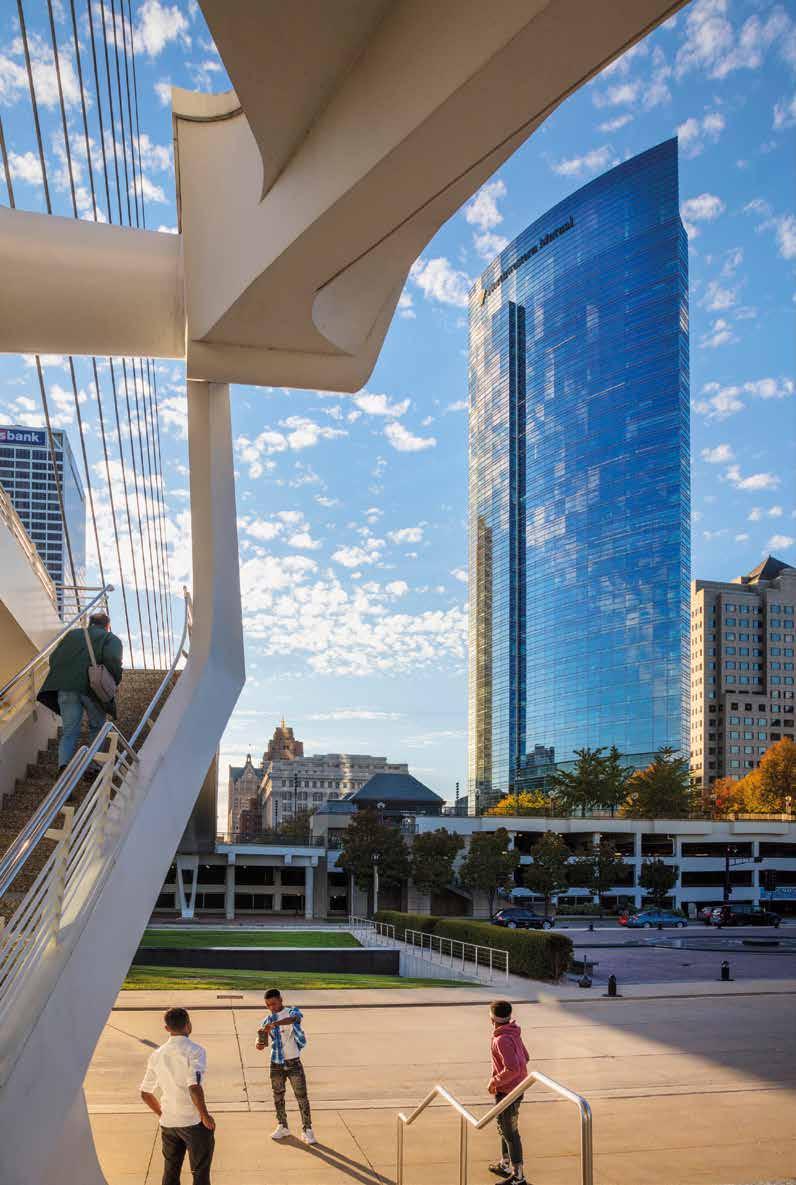
110
© David Sundberg/Esto

111
© David Sundberg/Esto


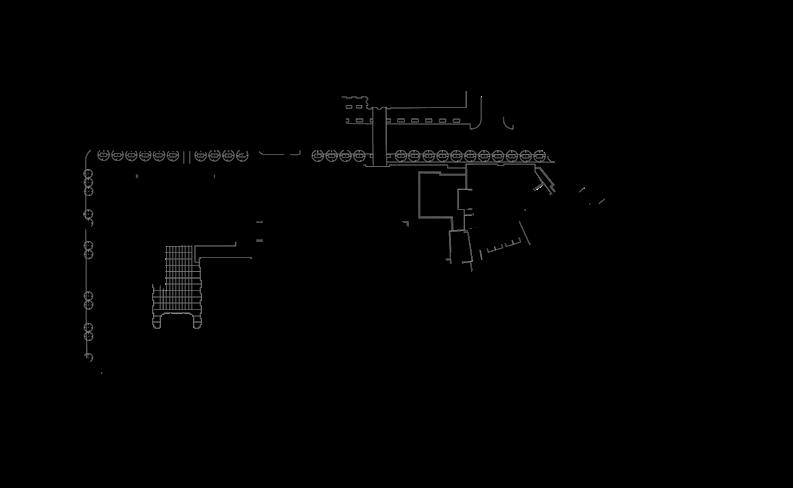


GROUND
SITE PLAN 112
AMENITY PLAN
PLAN
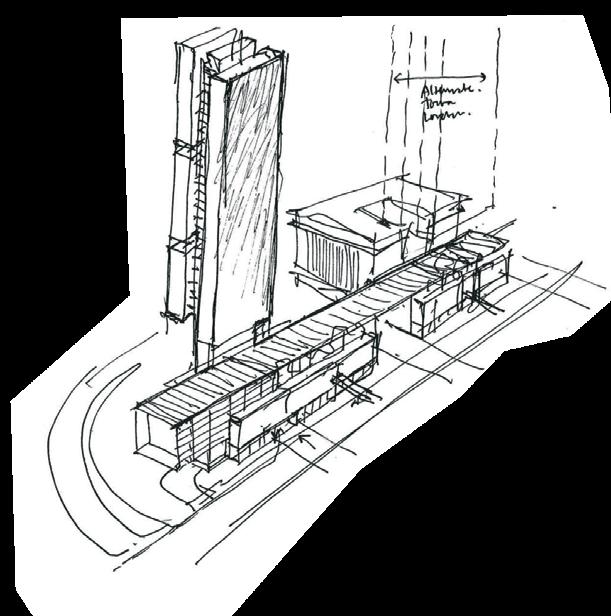


© Pickard Chilton 113
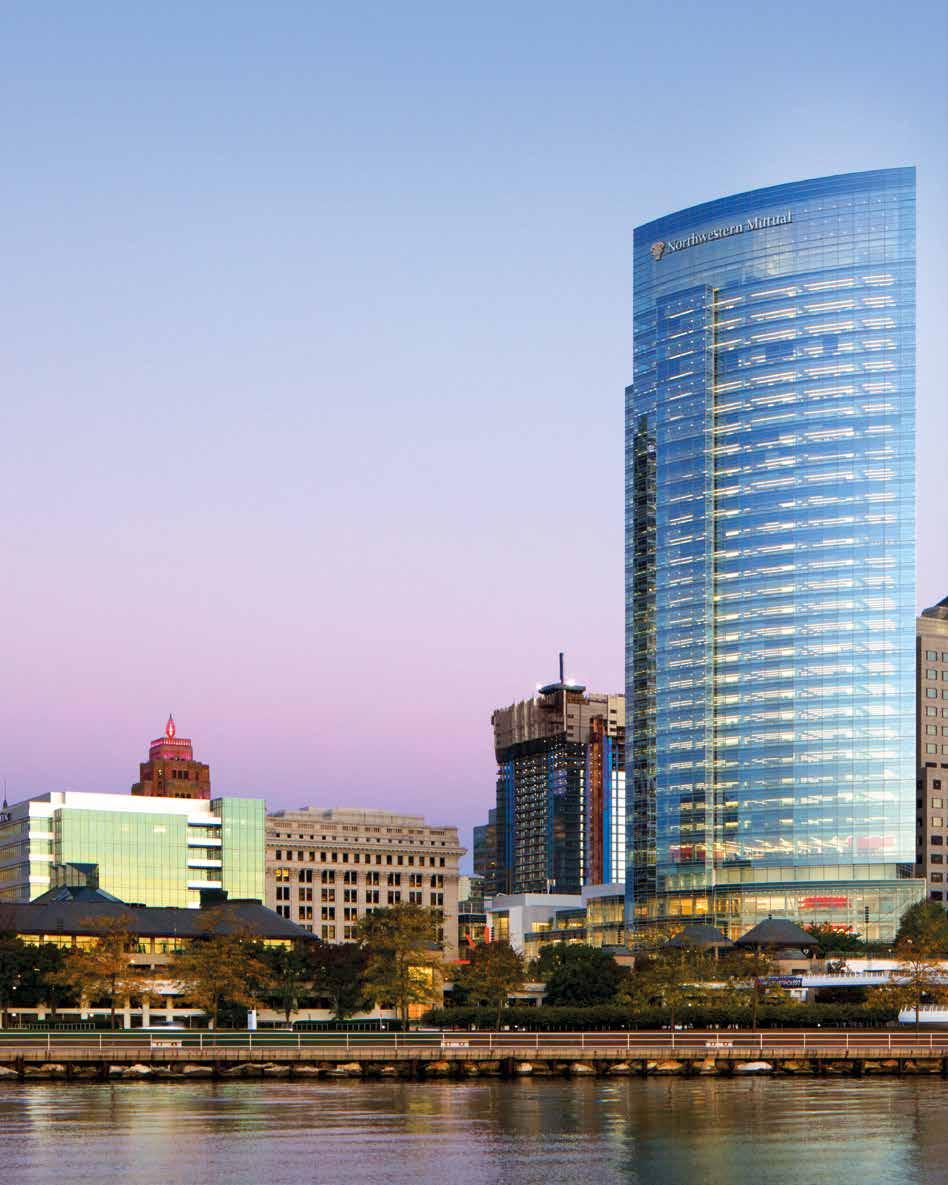
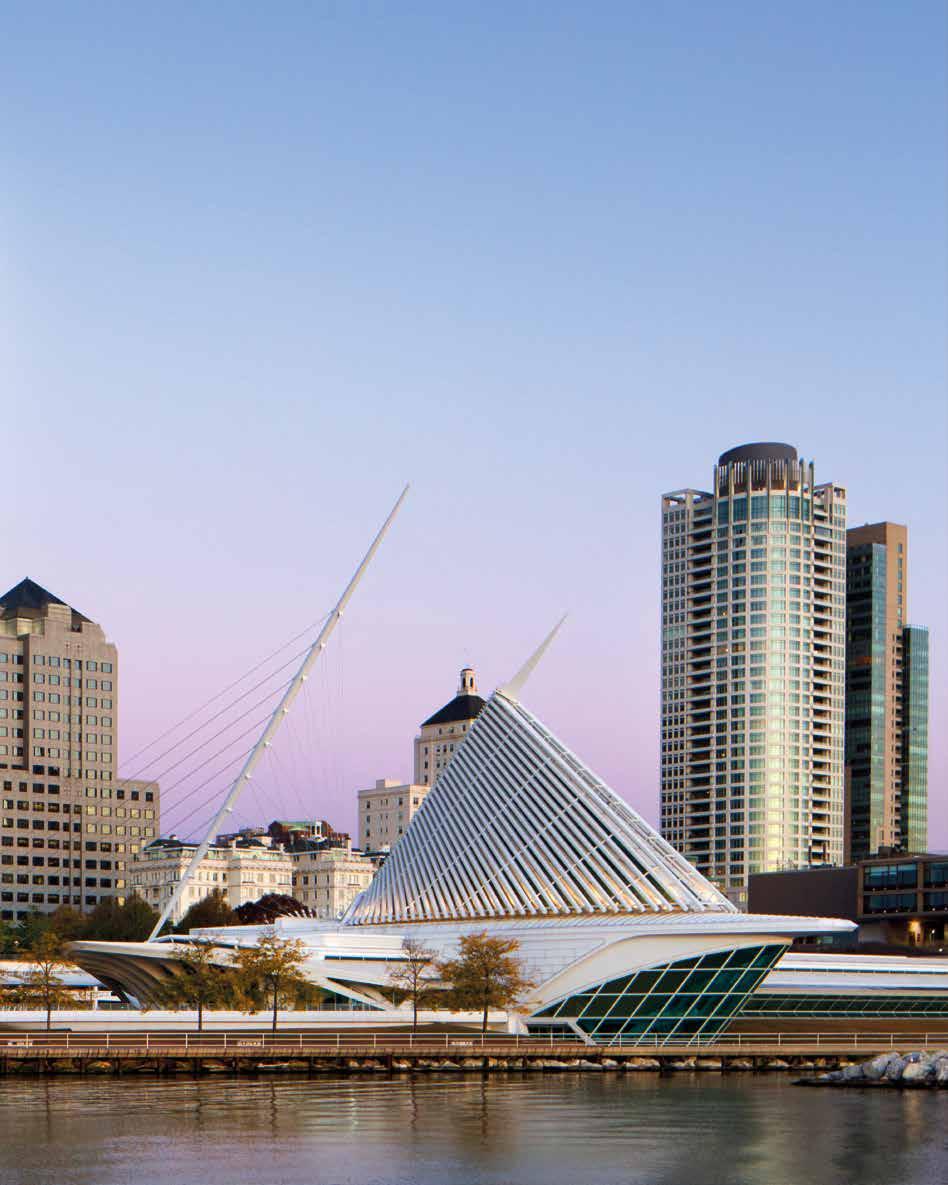 © Tom Rossiter
© Tom Rossiter

© Pickard Chilton
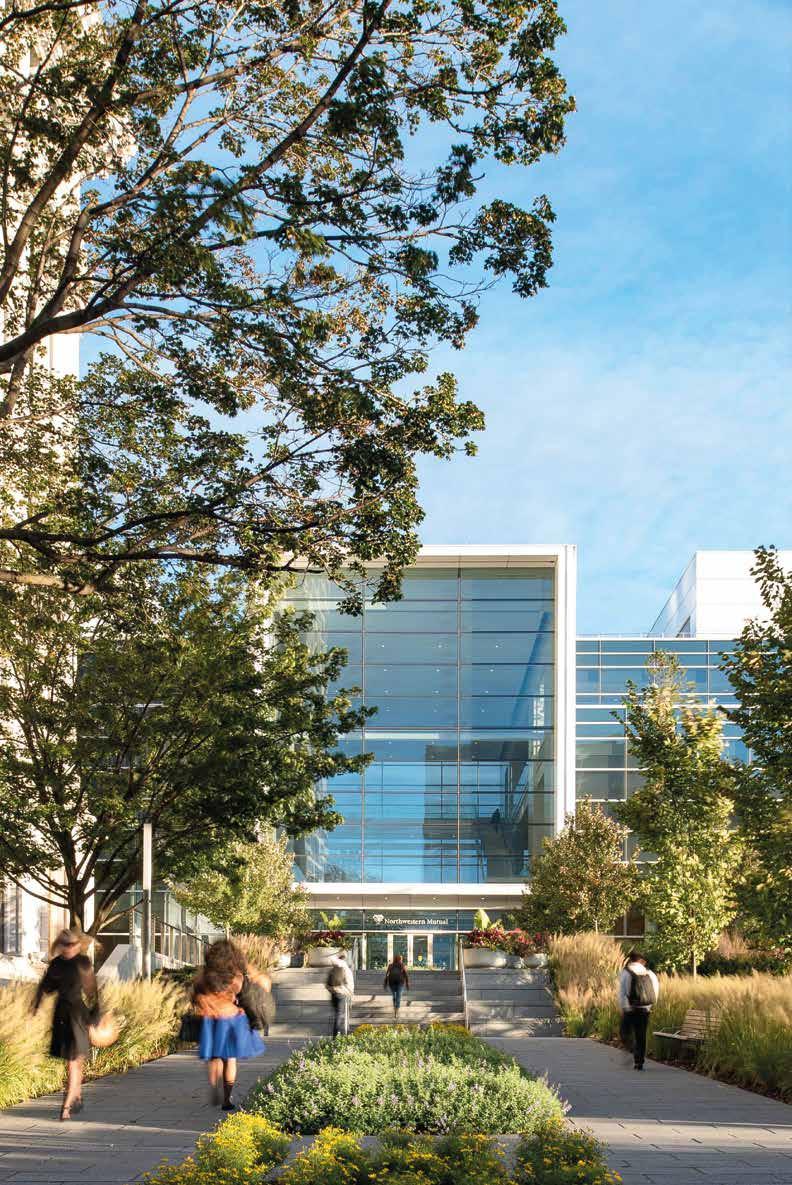
117
© Ian Patzke Photography

© David Sundberg/Esto 118
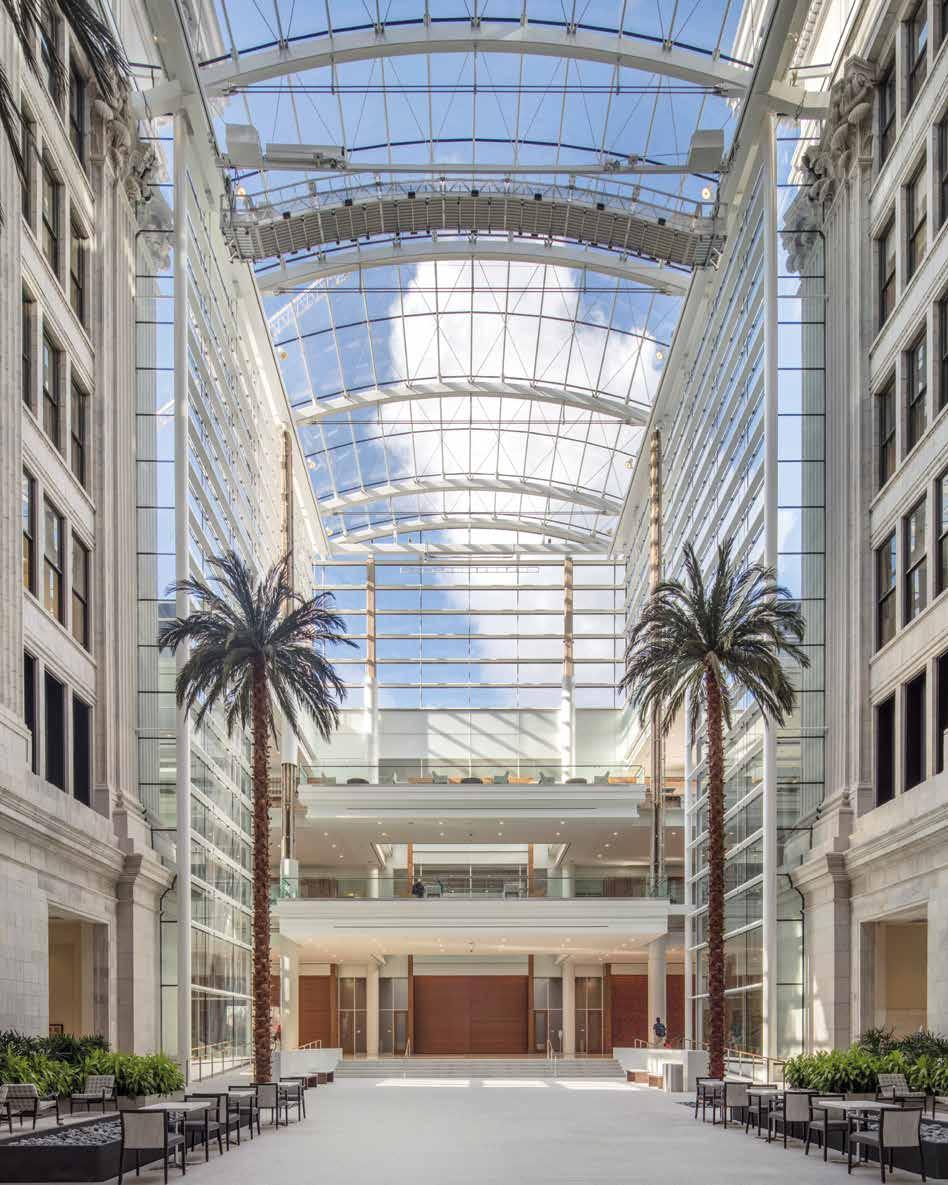 © Tom Rossiter
© Tom Rossiter
Google Cambridge Headquarters
Cambridge, Massachusetts
To accommodate Google’s continued growth, 3 Cambridge Center, an existing four-story commercial offce and retail building, is being redeveloped to serve as 325 Main, Google’s next-generation work environment in the heart of Kendall Square. The high-performance design comprises approximately 38,740 gsm of new offce space on 16 foors as well as 3,900 m 2 of retail at the lower levels.
With an activated ground and second-foor retail edge along Main Street and the façade abutting Kendall Plaza, 325 Main
will signifcantly enhance the pedestrian experience and enliven the public realm. A new pedestrian connection from Kendall Plaza up to the Kendall Square Rooftop Garden creates a multi-level public terrace overlooking Main Street and Kendall Plaza with potential for programming. 325 Main further enhances neighborhood connectivity with a pedestrian connection between Pioneer Way and Kendall Plaza. The existing MBTA headhouse serving the Kendall Red Line T-Station will be integrated at Kendall Plaza.
continued on page 128
Location: Cambridge, Massachusetts Status: Completion in 2022 Size: 38,740 gsm Certifcation: LEED-NC Gold Anticipated
Client (Owner/Developer): Boston Properties Main Tenant/User: Google
Master Plan & Design Architect: Pickard Chilton
Executive Architect: Stantec
Structural Engineer: Magnusson Klemencic Associates
MEP Engineer: BALA
Landscape: Lemon Brooke Contractor: Turner Construction 120
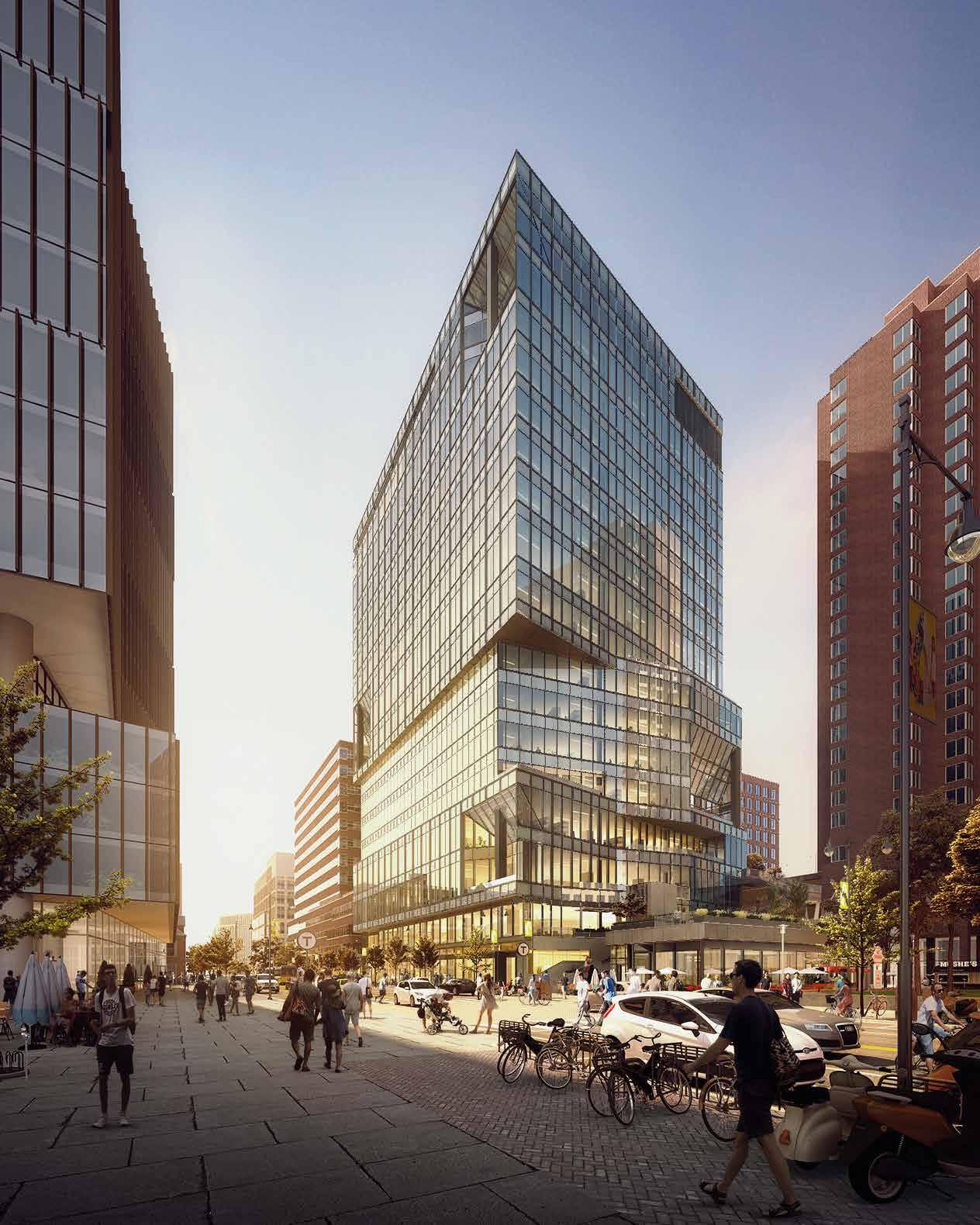
© Lifang

© Lifang
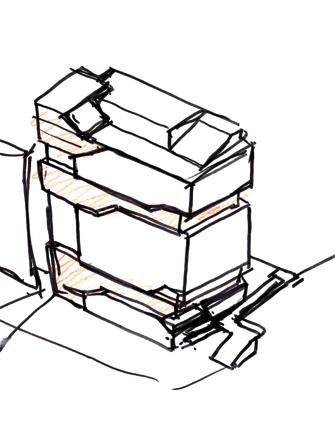

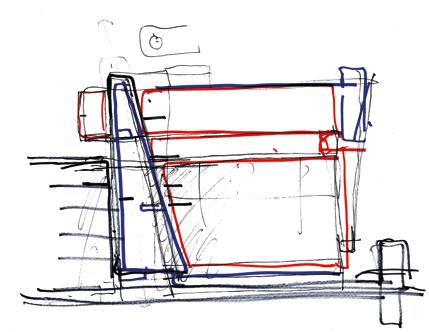

© Pickard Chilton

© Lifang


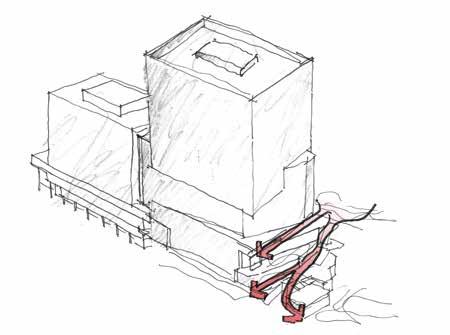

© Pickard Chilton
126
SITE PLAN SITE PLAN LEVEL 04
from page 120 LEVEL 02

GROUND 7.5M 22.5M 45M 0 LEVEL 7.5M 22.5M 45M 0 7.5M 22.5M 45M 0 60M
325 Main’s massing is conceived as a parallelogram, opening the space between the adjacent buildings and public areas. Articulating its massing, a series of inset “apertures” provide interest and balance, while creating outdoor terraces. Connecting 325 Main and the 355 Main Street building, a sloped “gasket” element creates a visual distinction between them while preserving the latter’s architectural integrity. Upper foors along Main Street have been pulled away from 355 Main Street to distinguish the visual separation. A glass façade, comprising spandrel, frit and vision glass and metal panels, will articulate the building. 7.5M 22.5M 45M 0 GROUND PLAN
LEVEL 05 LEVEL 16
7.5M 22.5M 45M 0
AXON 7.5M 22.5M 45M 0 AXON ELEVATION
7.5M 22.5M 45M 0 7.5M 22.5M 45M 0
LEVEL 16 LEVEL 05
127
LEVEL 05 LEVEL 16
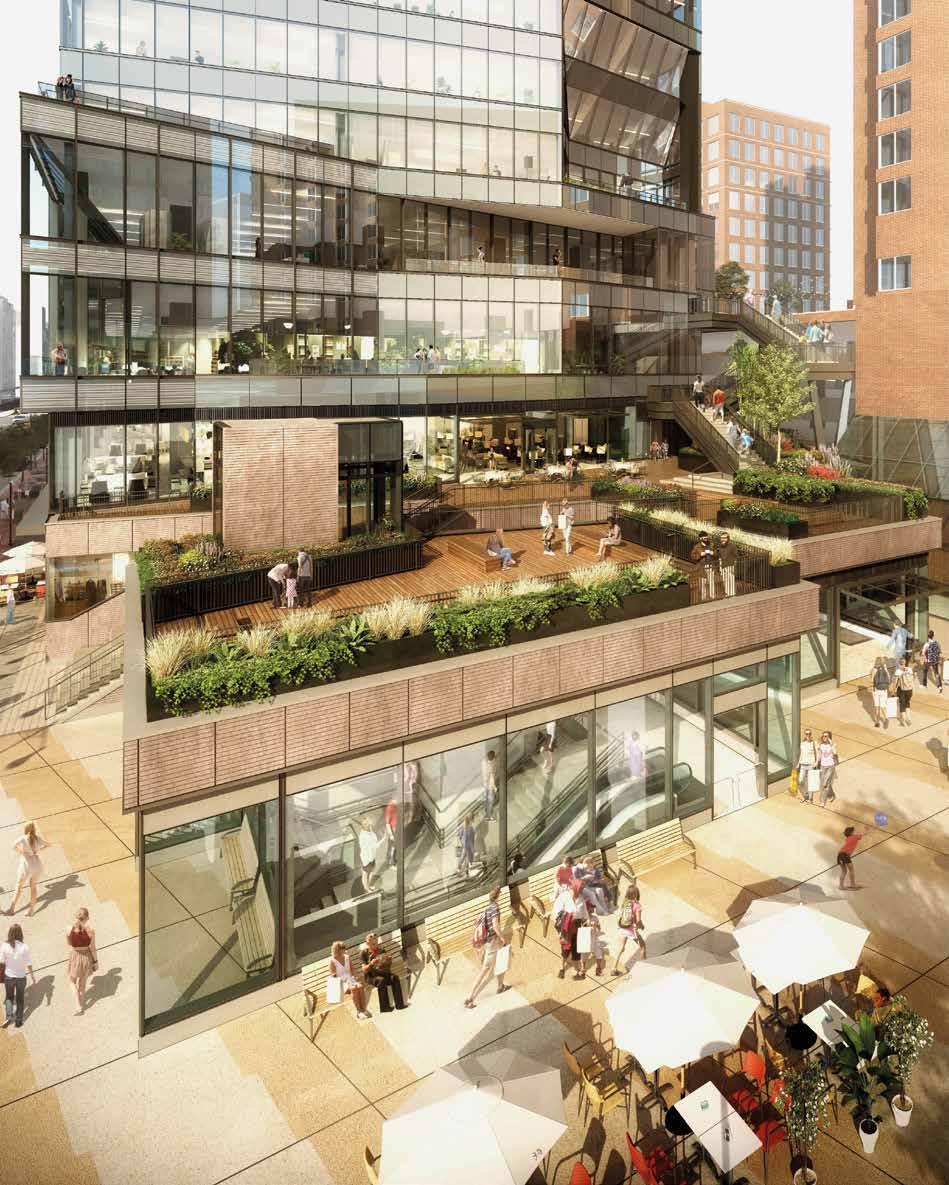
© Lifang
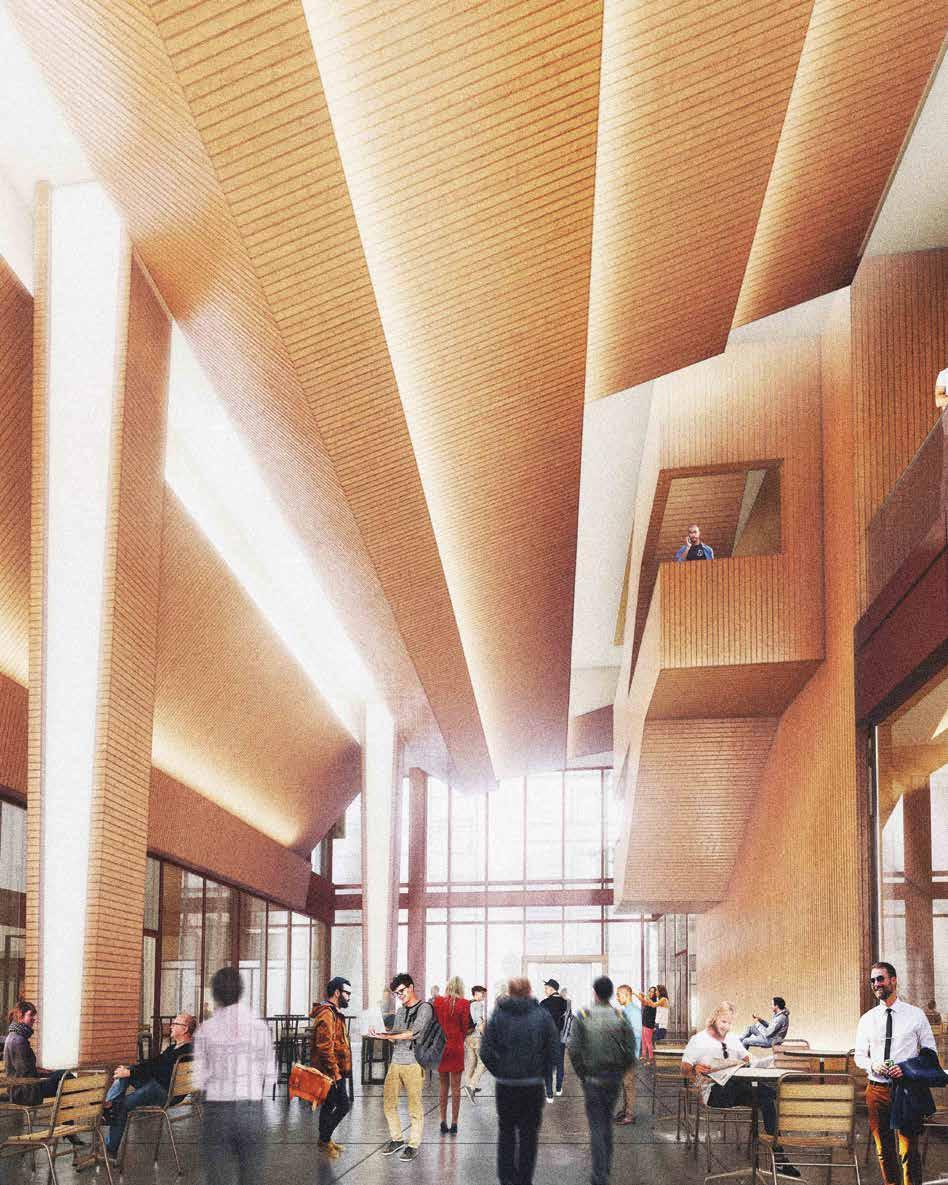
© Pickard Chilton
Global Gateway Shinagawa
Tokyo, Japan
PICKARD CHILTON recently completed the master plan and concept design for Global Gateway Shinagawa, the redevelopment of the northern portion of Tokyo’s Shinagawa Station. Phase 1 of the development was recently reviewed by the Council on National Strategic Special Zones and certifed by Prime Minister Shinzō Abe. Initial phases are expected to be completed by 2024.
Envisioned as a new global hub connecting Tokyo to the world, the Global Gateway Shinagawa has been designed as a next-generation urban environment that symbolizes Japan’s openness and is a catalyst for innovative, international companies to create new businesses and cultures. The key design concepts for the development include:
• Organize buildings along the 1,6-km
site as an “archipelago” of diverse uses and unique public spaces;
• Interconnect the buildings with a richly-landscaped pedestrian promenade that fows with a series of public parks and plazas;
• Create a cohesive architectural identity for buildings within the development; and,
• Respectfully integrate the Takanawa Gateway Station by Kengo Kuma & Associates.
In addition to leading the Design Code and Master Plan for Global Gateway Shinagawa, Pickard Chilton is designing Block IV within the development. Within two 30-story towers connected by a seven-story podium, the mixed-use complex comprises over 460,000 m2 and will include offces, a fve-star hotel, conference spaces, and retail.
Location: Tokyo, Japan
Status: Completion in 2024 (Phase 1) Size: 1.25 million gsm Certifcation: LEED-NC Gold (Anticipated)
Client (Owner/Developer): East Japan Railway Company
Master Plan & Design Architect: Pickard Chilton
Executive Architect: Design Joint Venture / JR East Design Corporation, JR-East Consultants Company, Nihon Sekkei, Nikken Sekkei
Contractor: Obayashi Corporation
130
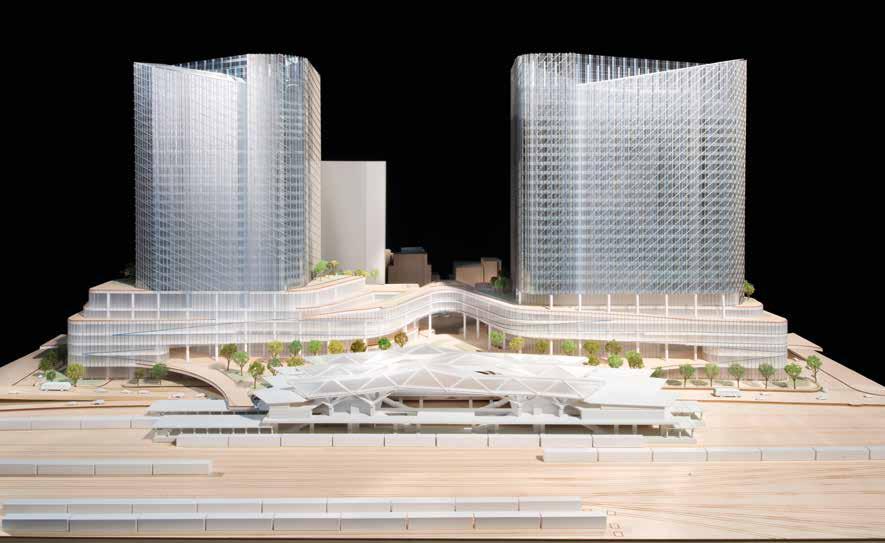
© Pickard Chilton
AXONOMETRIC
AXONOMETRIC
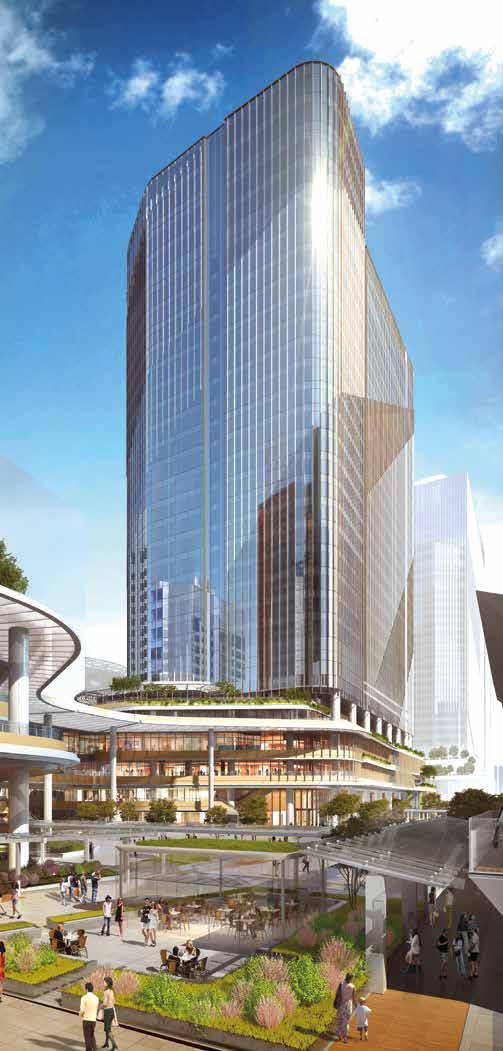

© Atchain 132

© Atchain

© Pickard Chilton

© Atchain
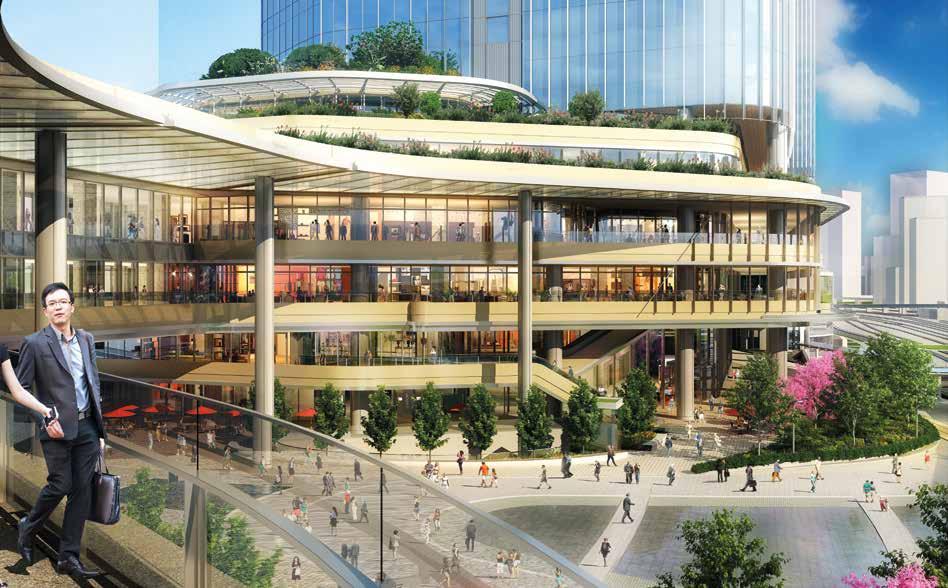
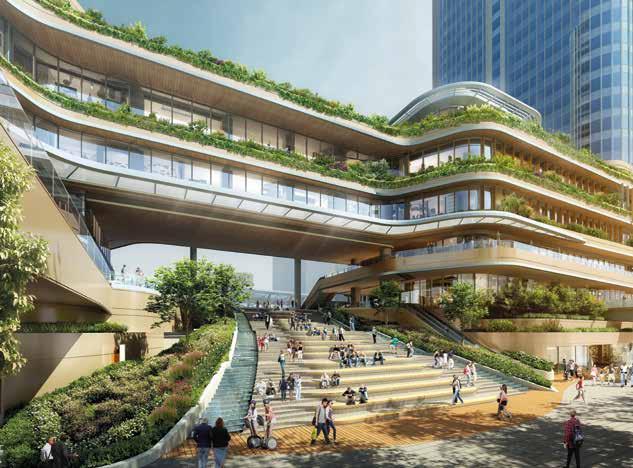
© Lifang 136
© Lifang


© Atchain 137
© Atchain
Eaton House
Dublin, Ireland
LOCATED IN DUBLIN’S historic
D4 district, Eaton House serves as Eaton’s new global headquarters. It is located in an early 19thcentury Georgian neighborhood, a rich tapestry of residences, small businesses, parks, and embassies. Following the demolition of the original fve terrace houses (c. 1830), a new building was constructed in 1970.
Reusing much of the 1970 building’s concrete frame, Eaton House is designed to be a building of its time while respectful of its historical context, but re-envisions the exterior enclosure in linear coursed stone, clear vision glass, and handmade cast glass bricks.
An analysis of the original terrace houses revealed that the façades were organized based on the golden rectangle. The new façade refects the original fve terrace houses in its organization, with clear glass openings recognizing the original golden rectangle proportions.
Recessed cast glass brick fanks the clear glass openings resulting in a 38% increase in daylight over the 1970 building’s façade. The cast glass brick respects how the material was used historically to add more daylight and creates a more open, productive work environment for the LEED Gold project.
Location: Dublin, Ireland
Status: Completed in 2015
Size: 3,065 gsm
Certifcation: LEED-NC Gold
Client (Owner): Eaton
Development Manager: The Richard E. Jacobs Group
Design Architect: Pickard Chilton
Executive Architect: MCA Architects, Dublin
Landscape: Mitchell + Associates
Interiors: NELSON
Contractor: John Sisk & Son
138

GROUND PLAN 5M 15M 30M 0 140

ELEVATION 5M 15M 30M 0 ELEVATION 5M 15M 30M 0 ELEVATION
141
© David Sundberg/Esto

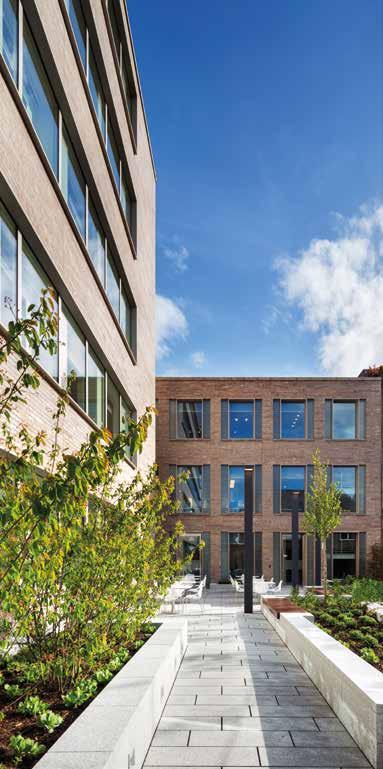
Sundberg/Esto 142
© David
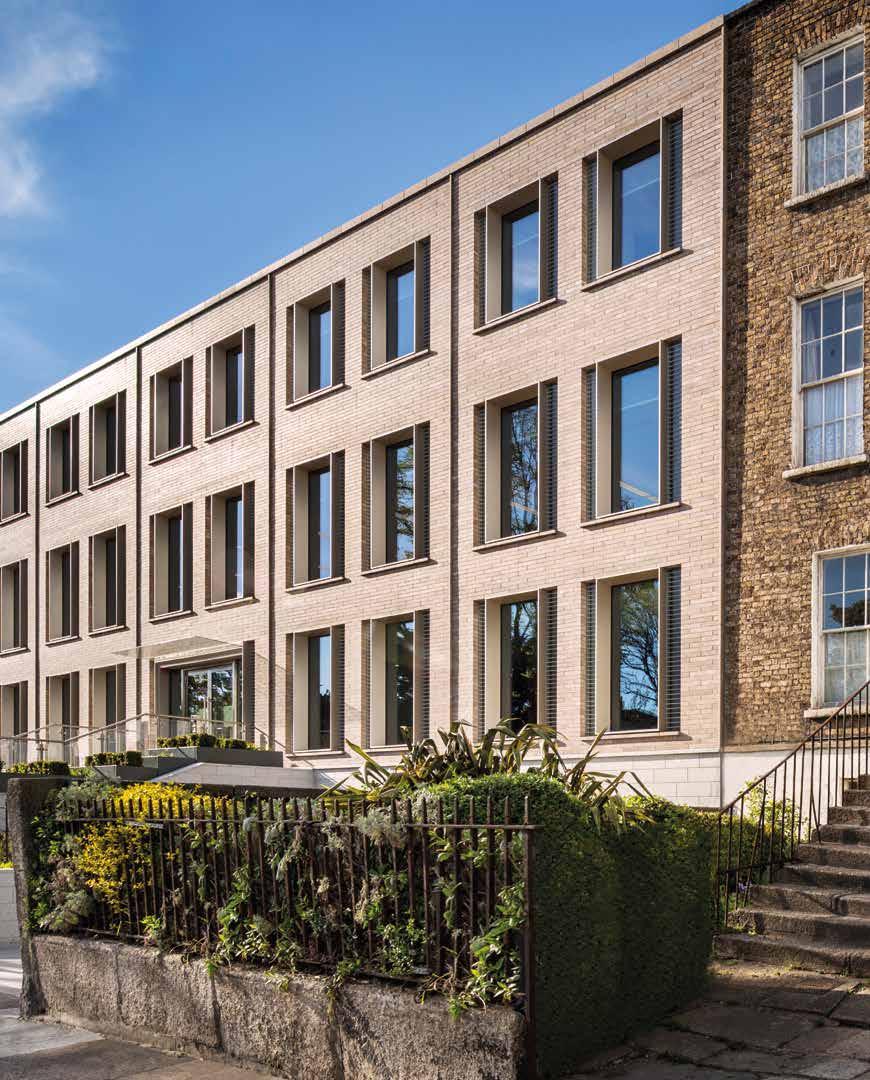
143
© David Sundberg/Esto
Plieninger Straße 140 Development Stuttgart, Germany
AFTER AN INVITED international competition, the Pickard Chilton-led team was selected to master plan and design an urban development at Plieninger Straße 140 in Stuttgart. The objective was to envision a sustainable, high-quality and futureoriented urban development that maximizes landscape open space while integrating the broader urban context. The resulting three-phase master plan yields a development with 125,000 m2 of above-ground gross foor area across six highperformance buildings.
Responding to the design brief’s guiding principles, the concept, entitled “Die Fuge” (“The Seam”), is a sweeping public space that
defnes the center of the master plan. Concentrating building density to the east and west of the site, Die Fuge’s curving form creates an inviting new public realm while meeting the project’s environmental goals. The buildings respond to the site’s topography with a series of occupiable green roof terraces with integrated photovoltaic panels.
Flexible and modular H-shaped offce buildings create exterior courtyards for drop-offs and access to bicycle storage and amenities. Inherent fexibility in planning supports long-term building resiliency and responsiveness to market conditions.
Location: Stuttgart, Germany
Status: Completion in 2024
Size: 46,680 m2 of site area; 125,000 m2 of gross foor area
Certifcation: Local certifcation anticipated
Client (Owner/Developer): P140 PropCo S.à.r.l.
Design Architect: Pickard Chilton
Executive Architect: ARP Architektenpartnerschaft
Landscape: Glück Landschaftsarchitektur
144



SITE PLAN © Lifang 145
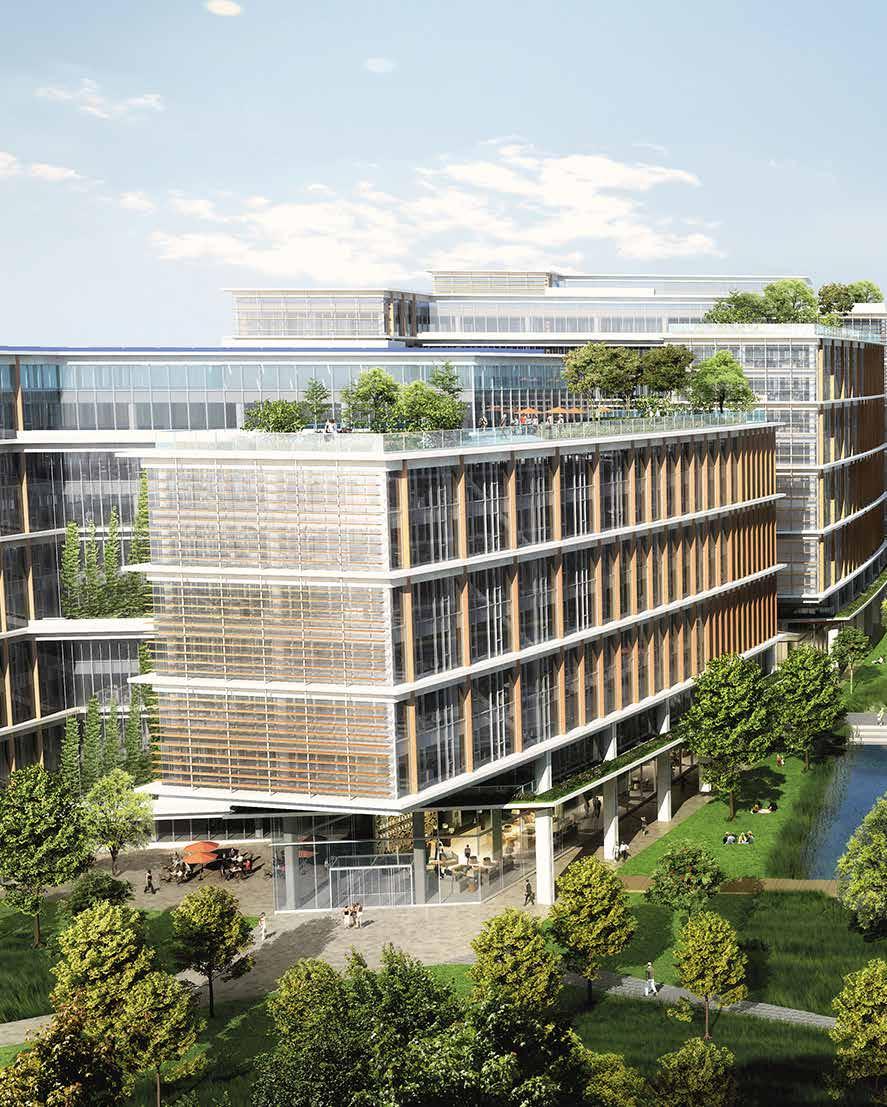
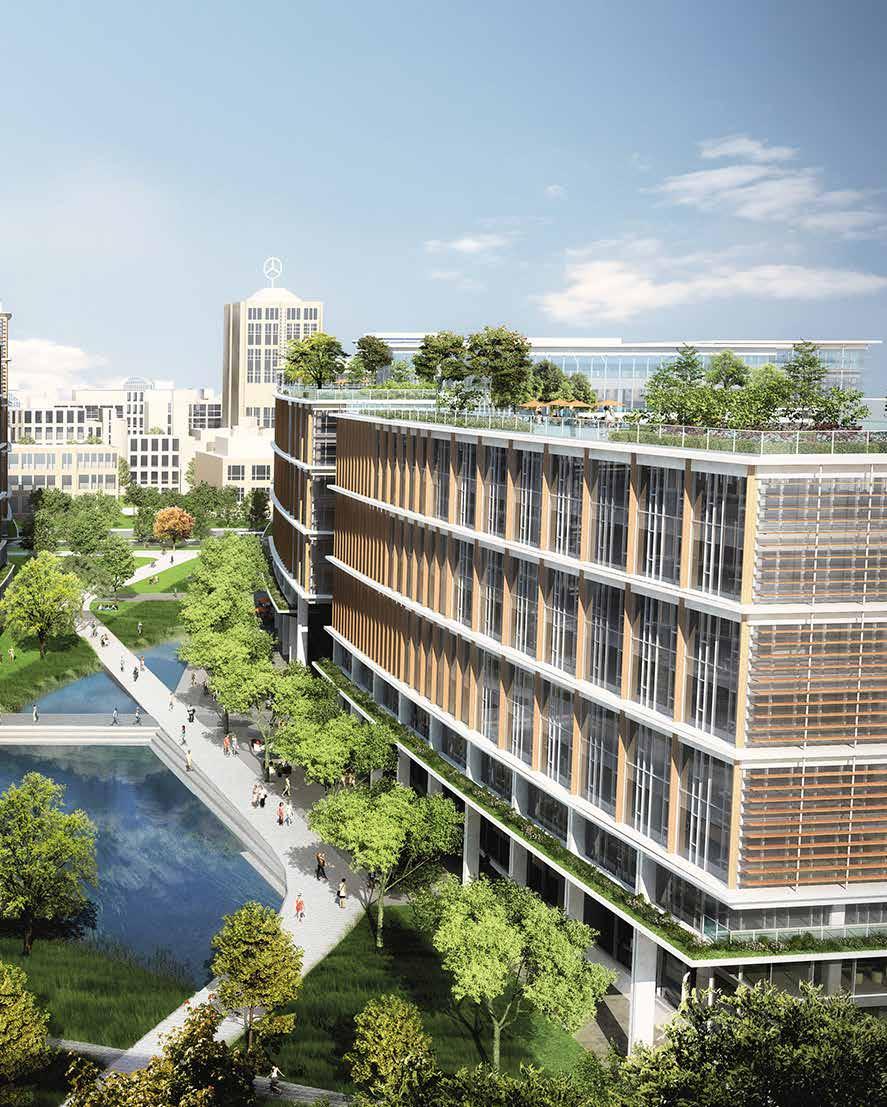
© Lifang


GROUND
PHASE 2 AXON 148
PLAN

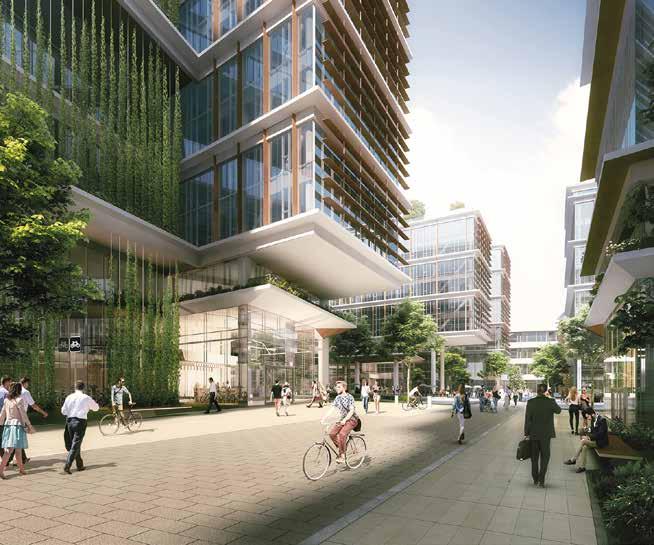
149 © Lifang © Lifang

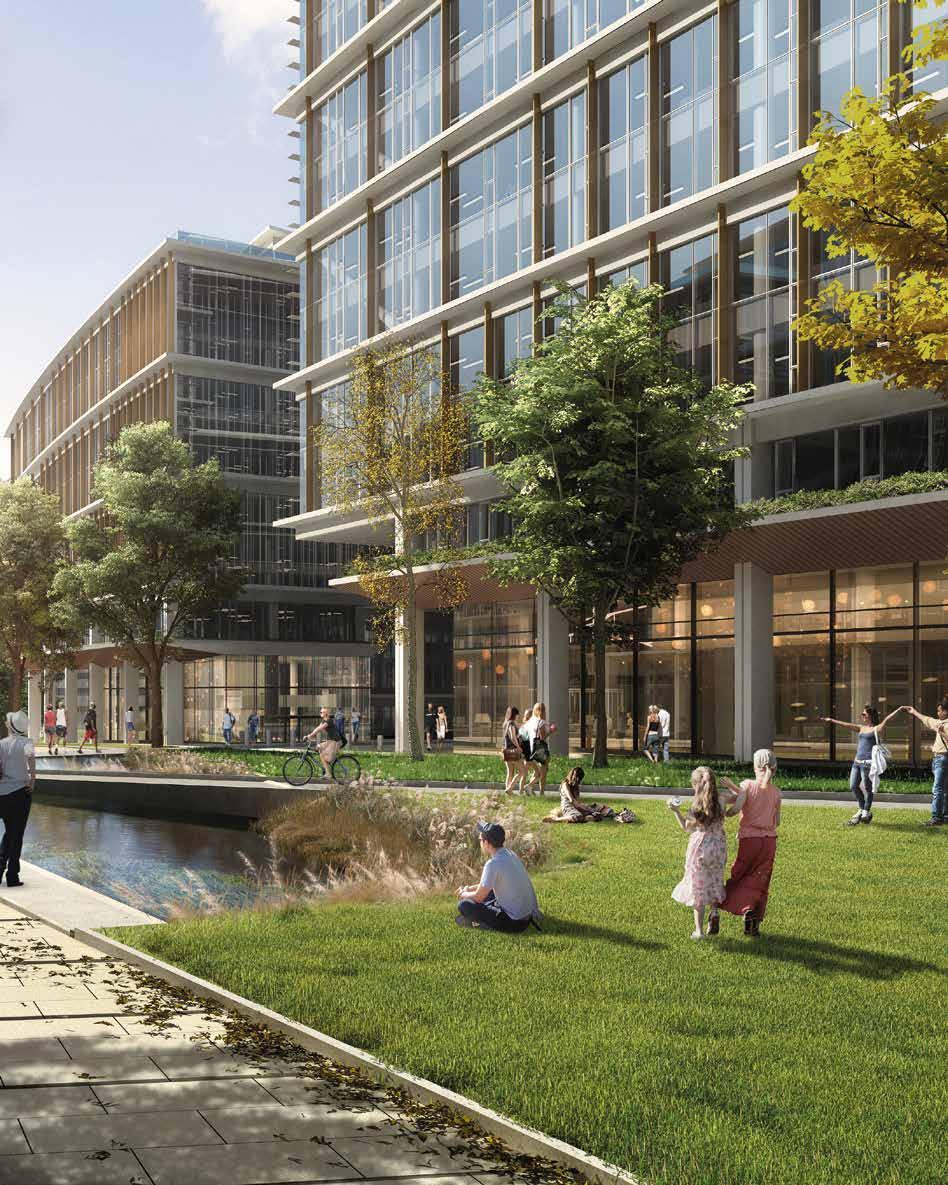
© Lifang

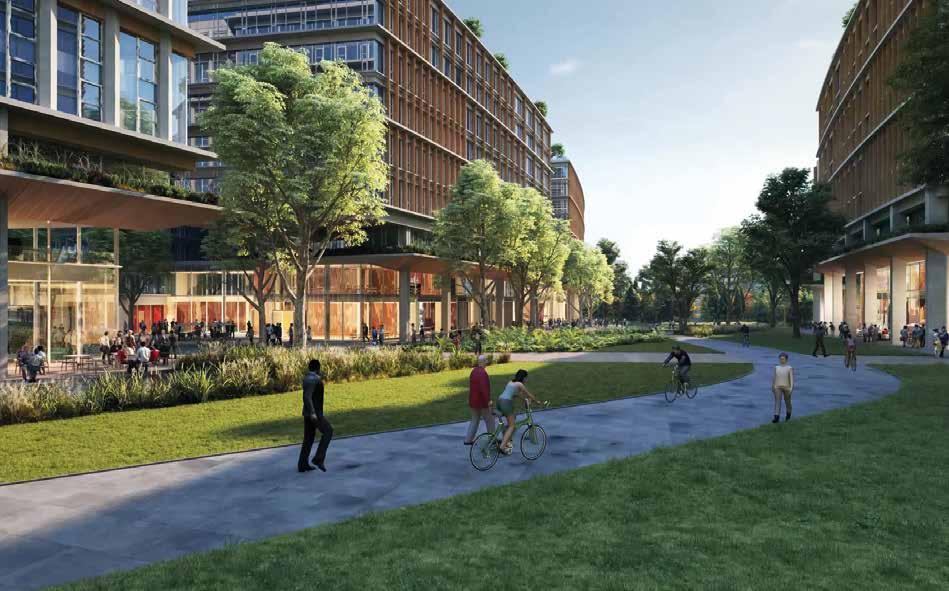
© Lifang
© Lifang


©
Lifang
© Lifang
T3 RiNo
Denver, Colorado
T3 RiNo is six-story heavy timber offce building featuring numerous open terraces, a variety of amenity spaces and three levels of belowgrade parking. Ideally centered in the heart of the RiNo neighborhood, T3 RiNo’s location offers immediate connectivity and accessibility. The project offers prime opportunities for retailers, tenants, and community residents alike.
Offce foors offer panoramic views of the Denver skyline and the Rocky Mountains while outdoor terraces thoughtfully break down the building’s mass to provide tenants with multiple private outdoor
experiences. Coalescing natural light and sculpture, the design emphasizes occupants’ connection to nature through both form and materiality.
Offce levels provide a variety of collaborative work environments and fexible outlets beyond tenants’ desks. A blend of indoor and outdoor spaces enhance and activate the ground-foor experience by combining lifestyle with social productivity. Restaurants and cafés, along with retailers, ftness and bike facilities, and a collaborative work lounge, unite to create a dynamic destination for both the tenants and area residents.
Location: Denver, Colorado
Status: Completion in 2024
Size: 35,600 gsm
Certifcation: LEED-NC Gold Anticipated
Client (Owner/Developer): McCaffery, Ivanhoé Cambridge, Hines
Design Architect: Pickard Chilton
Executive Architect: DLR Group
Structural Engineer: Magnusson Klemencic Associates
MEP Engineer: Alvine Engineering
Landscape: Norris Design
154

© Pickard Chilton
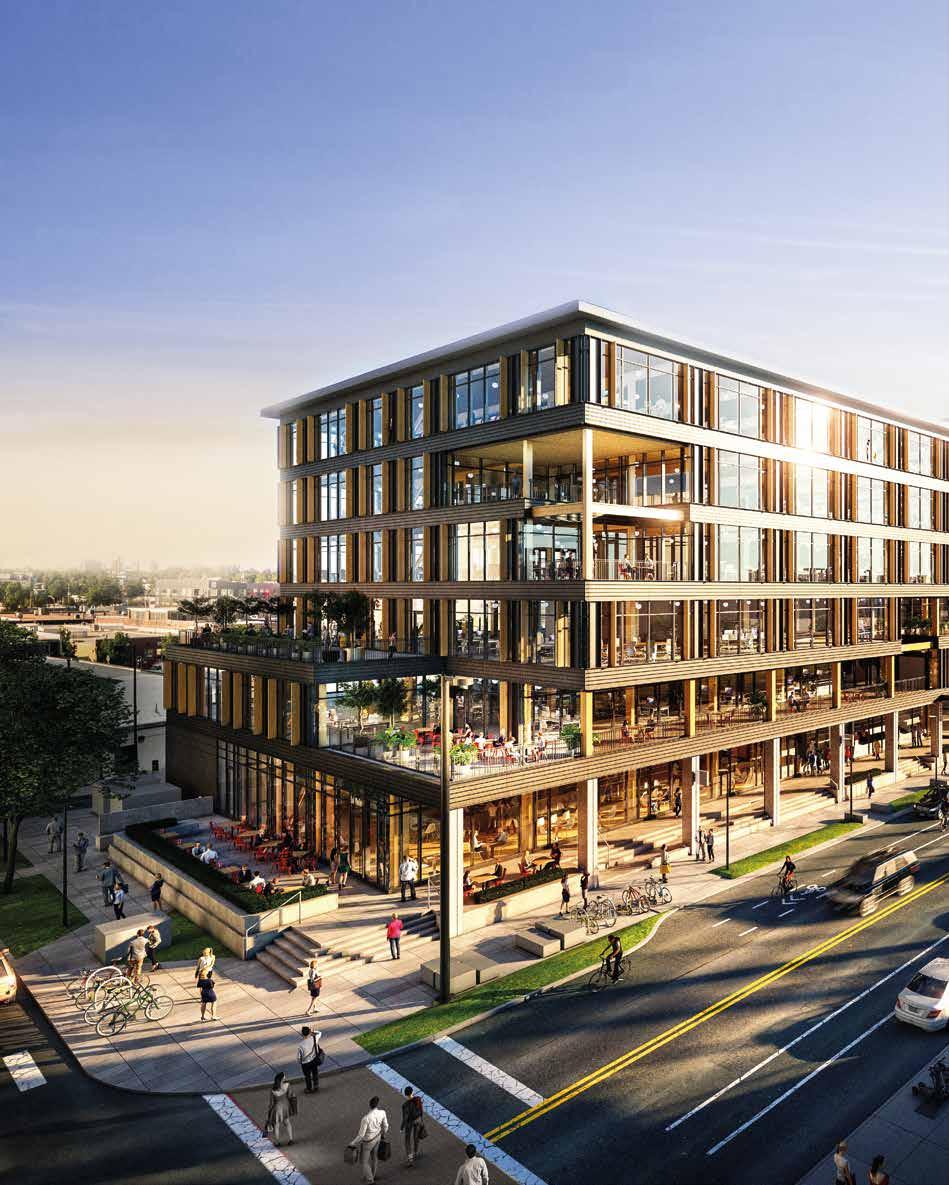
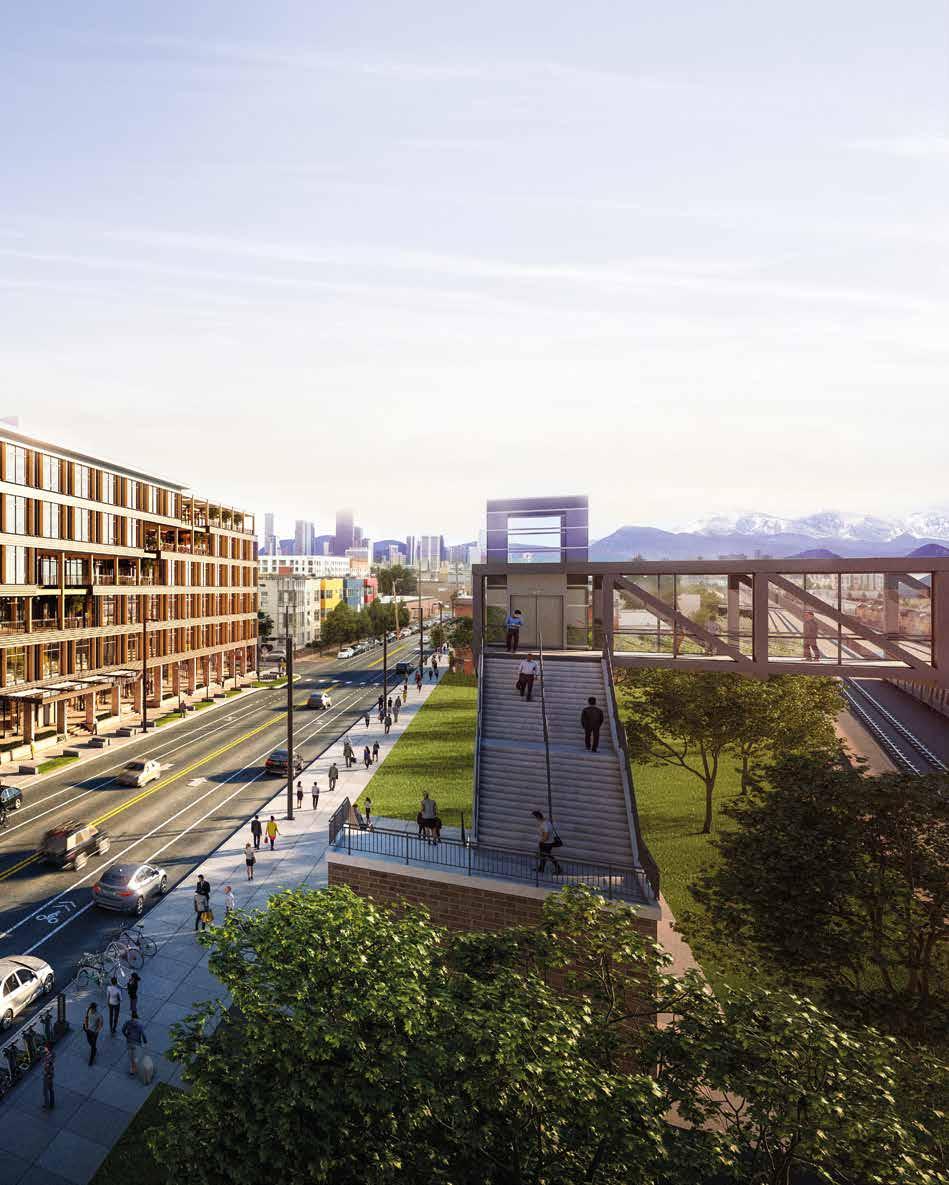
© Neoscape
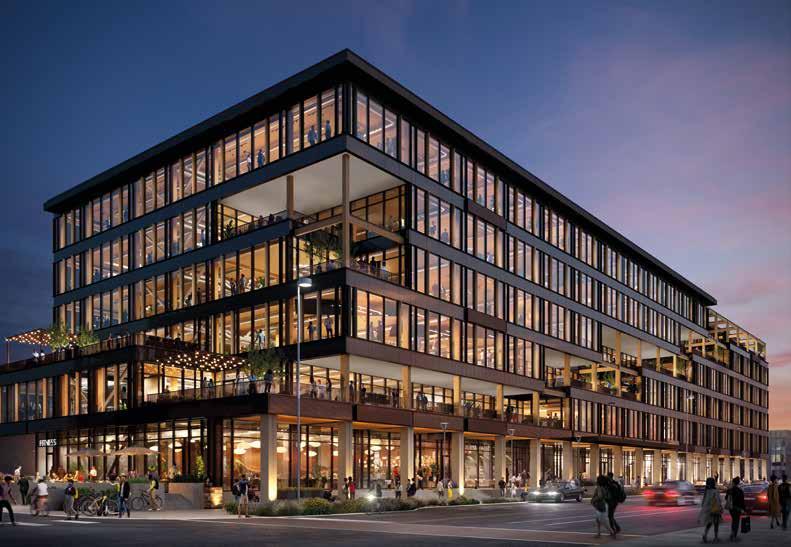

© Steelblue © Studio216 158


 © Pickard Chilton
© Pickard Chilton


GROUND 22.5M 45M LEVEL 02 22.5M 45M 10M 30M 60M 0 SITE PLANSITE PLAN GROUND PLAN LEVEL 02 160

02 © Pickard Chilton

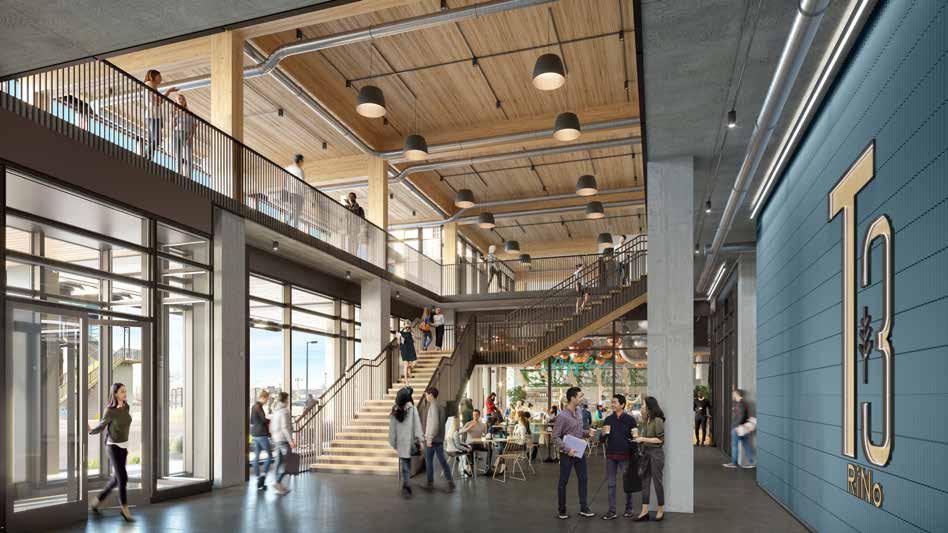
© Steelblue
162
© Steelblue


© Steelblue
163
© Steelblue
The RO Houston, Texas
SITED NEAR THE affuent Greenway Plaza and River Oaks Districts, this frst phase of The RO, a broader 7-hectare next-generation mixed-use development, is currently in design.
The RO has been master-planned as a best-in-class, urban, multi-use destination on a 68,800-m2 site. Purposefully designed to contrast with a contrived “town center,” the vision for this organically phased development is to create a complimentary, high-density environment.
Intended to engage empty nesters and millennials alike, the frst phase of the development features a 36-story luxury multifamily high-rise comprising rental units atop a fourstory podium and a 27,870-gsm offce tower offering signifcant Class AA creative and fexible offce space. Maximizing density and fexibility, the design takes advantage of shared access points and shared parking while retaining and enhancing view corridors.
Location: Houston, Texas
Status: Master Plan Design Completed in 2017 Size: 278,700 gsm
Certifcation: LEED-CS Gold Anticipated
Client (Owner/Developer): Transwestern
Master Plan & Design Architect: Pickard Chilton
Executive Architect: The Preston Partnership; Kendall/Heaton Associates
164

© Lifang


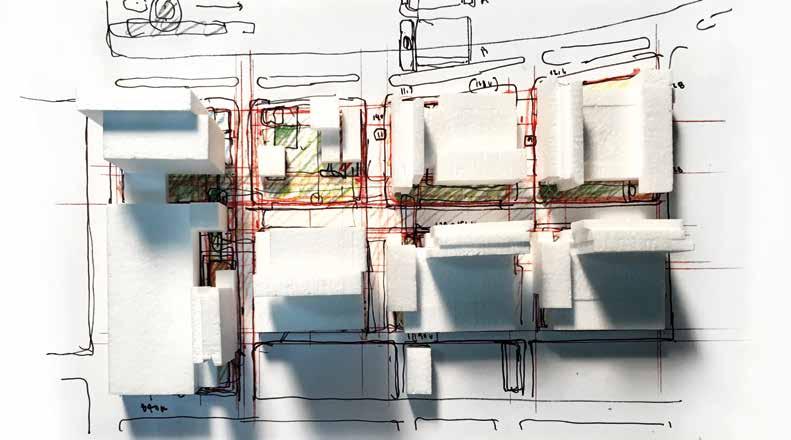
© Pickard Chilton 166

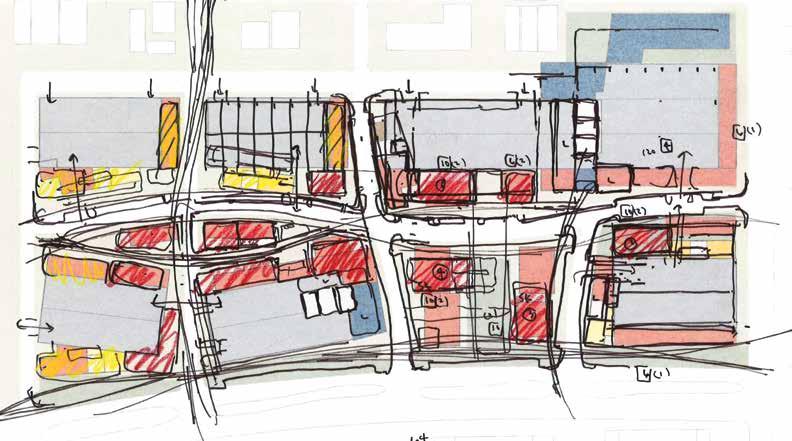
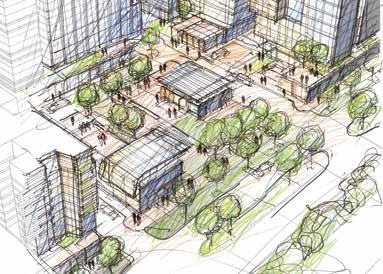
© Pickard Chilton 167
PARCEL 1 - LEVEL 34 PARCEL 1 - LEVEL 16
PARCEL 1 - LEVEL 8


LEVEL 6 LEVEL 8

PARCEL 1
168

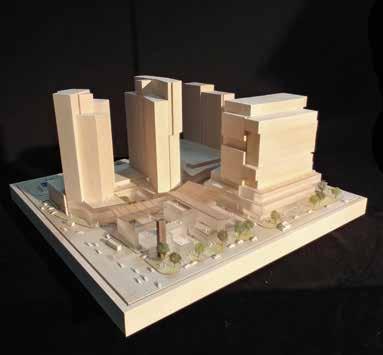
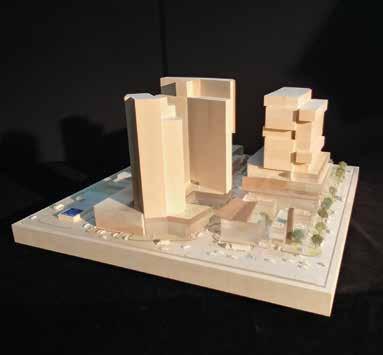

25M 50M 75M 0 SITE PLAN 5M 15M 30M 0 GROUND LEVEL LEVEL 6 PARCEL 2 GROUND LEVEL GROUND PLAN © Pickard Chilton 169

© Lifang 170

© Lifang

172 © Lifang

© Lifang


174 © Lifang
© Lifang
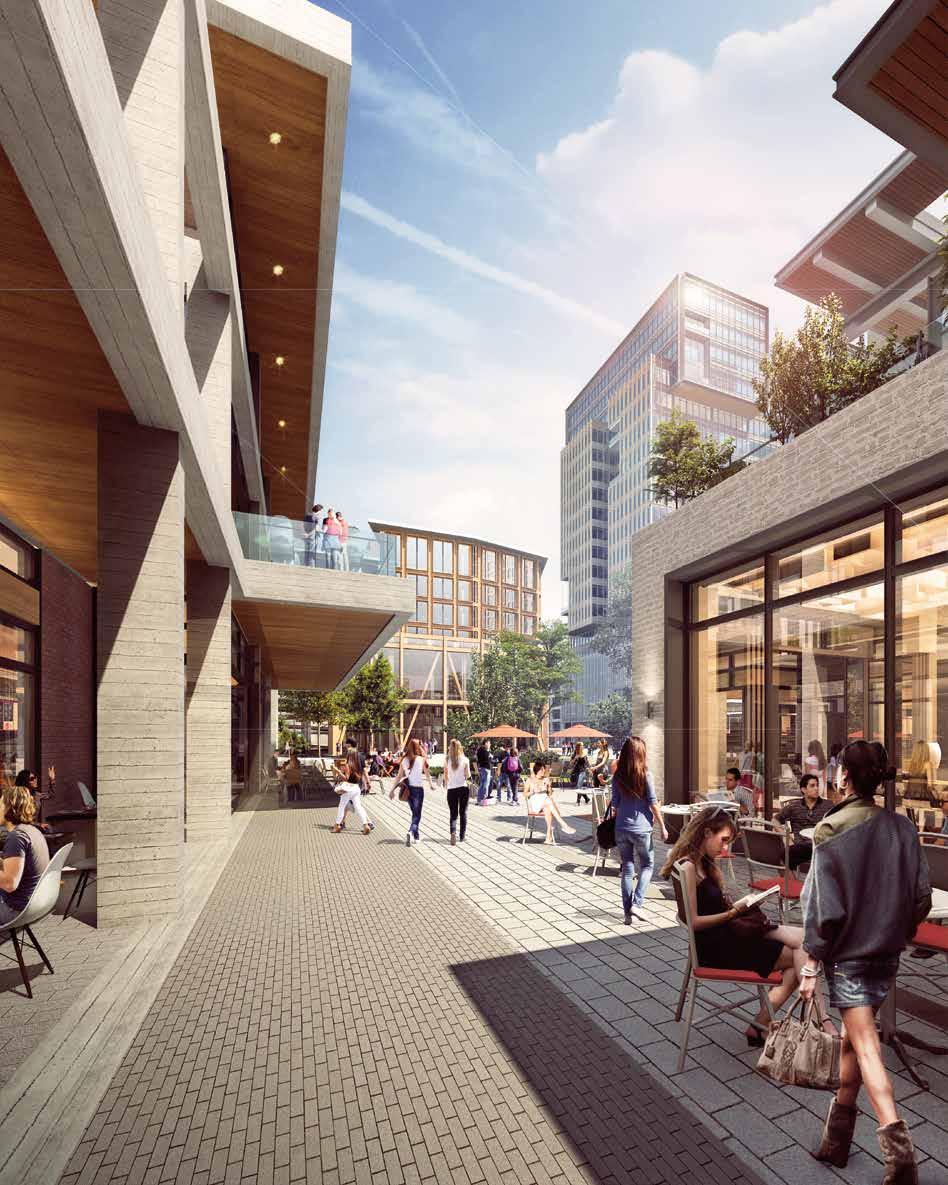
© Lifang
Uber Sky Tower
Los Angeles, California
FOR AN INVITED competition, Pickard Chilton and ARUP collaborated on the concept design for a Mega-Skyport –Uber’s vision for a next-generation urban aviation transport system. Dubbed “Sky Tower,” the project is intended to facilitate at least 1000 vehicle arrivals and 1000 departures per hour, with each vehicle accommodating up to fve passengers.
Once the objective of the desired throughput was resolved, Pickard Chilton and ARUP endeavored to create an elegant yet highly
engineered and sophisticated work of architecture that would support and augment the Uber brand. Due to the multi-faceted kit-of-parts and adaptability of the individual module, it can be applied both vertically and horizontally to suit any given context.
While the Sky Tower is conceptual, it is not science fction. Based on a pragmatic and researchdriven approach, the Sky Tower concept delivers to Uber a modular, extensible and sustainable solution that supports their vision for the future of intra-urban transportation.
Location: Los Angeles, California
Certifcation: LEED Platinum
Client: Uber
Design Architect: Pickard Chilton
Structural Engineer: ARUP
Aviation Consultant: ARUP
176






© Pickard Chilton © ARUP


178
© Pickard Chilton
 ©
©
179
Pickard Chilton
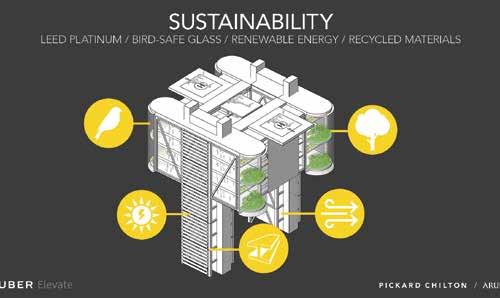

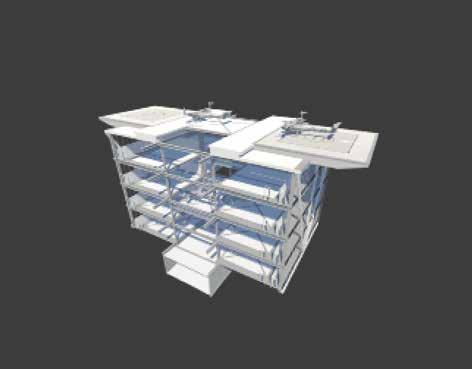


© Pickard Chilton © ARUP
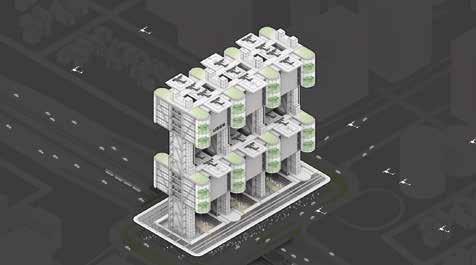

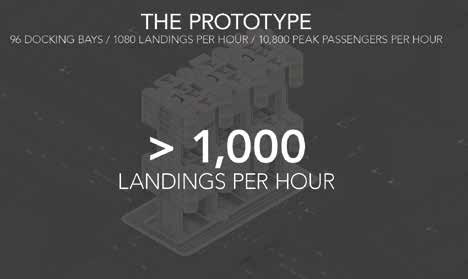

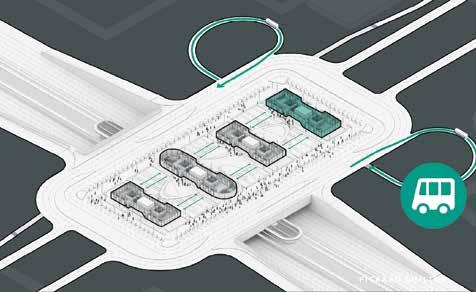
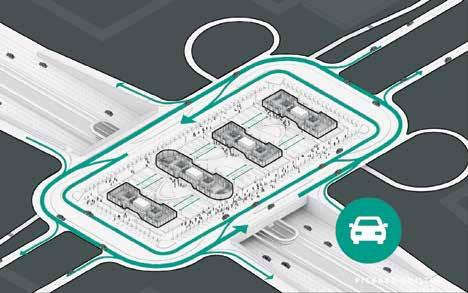



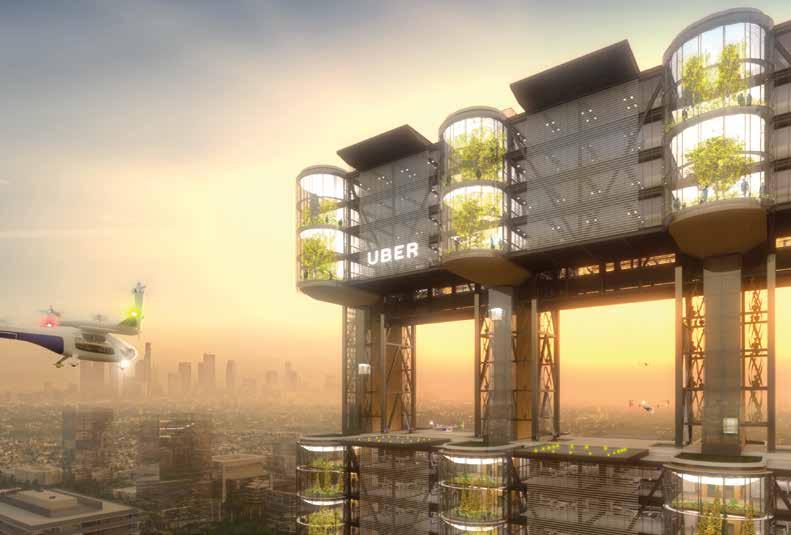
Chilton 182
© Pickard Chilton © Pickard


©
Pickard Chilton
183
© Pickard Chilton
CalPERS Headquarters Complex
Sacramento, California
THE CALIFORNIA PUBLIC
Employees Retirement System (CalPERS) Headquarters Complex is a mixed-use development integrating 51,100 m2 of commercial offce space, 2,322 m2 of retail space, 16,722 m2 of housing and belowgrade parking for 1,000 cars. The site comprises two contiguous blocks located in Sacramento’s downtown.
The building’s design is a response to both the urban fabric of Sacramento and to the sustainable design goals of CalPERS. The exterior skin incorporates sunshades, light shelves, and planters, helping the building exceed
California’s aggressive energy effciency requirements. The clear glass curtain wall integrates canopies and trellises to effectively blend interior and exterior space. A central courtyard offers both employees and the public a sheltered urban retreat, while a dramatic multi-story glass atrium brings light into the core of the building. In addition, the building’s fenestration changes from street to street in response to sun orientation, internal program requirements, and neighborhood adjacencies. As a result, the project received LEED Gold certifcation.
Location: Sacramento, California
Status: Completion in 2006 Size: 102,100 gsm
Certifcation: LEED-NC Gold
Client (Owner): California Public Employee Retirement System
Master Plan & Design Architect: Pickard Chilton
Executive Architect: Kendall/Heaton Associates
Structural Engineer: CYS Structural Engineers, Magnusson Klemencic Associates
MEP Engineer: ARUP
Landscape: Hart/Howerton
Landscape: Interior Architects
Contractor: Hensel Phelps Construction Co.
184
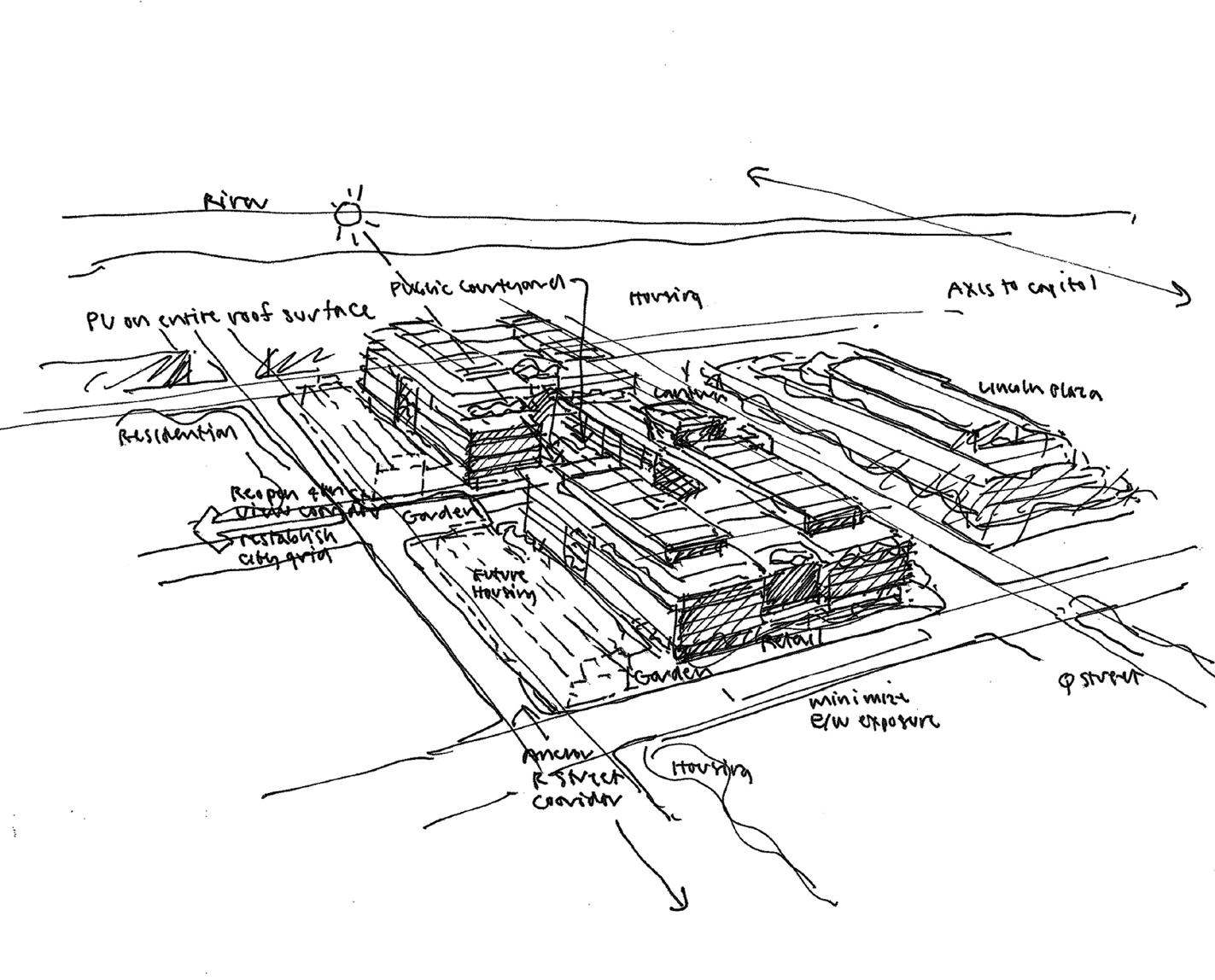
© Pickard Chilton 185
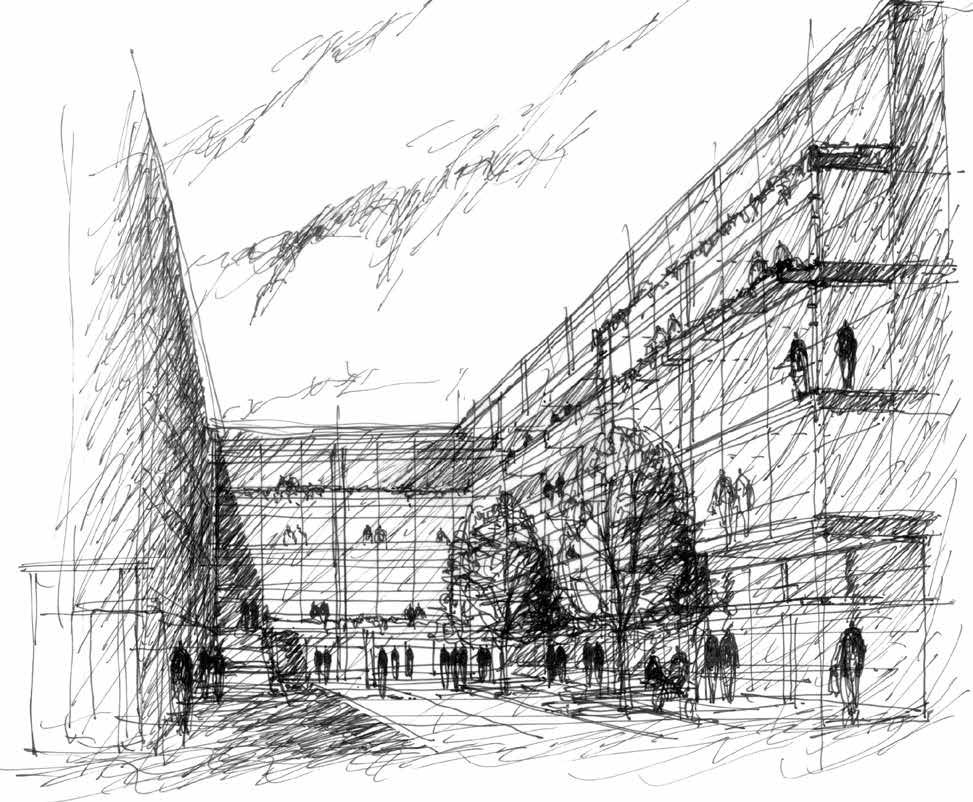
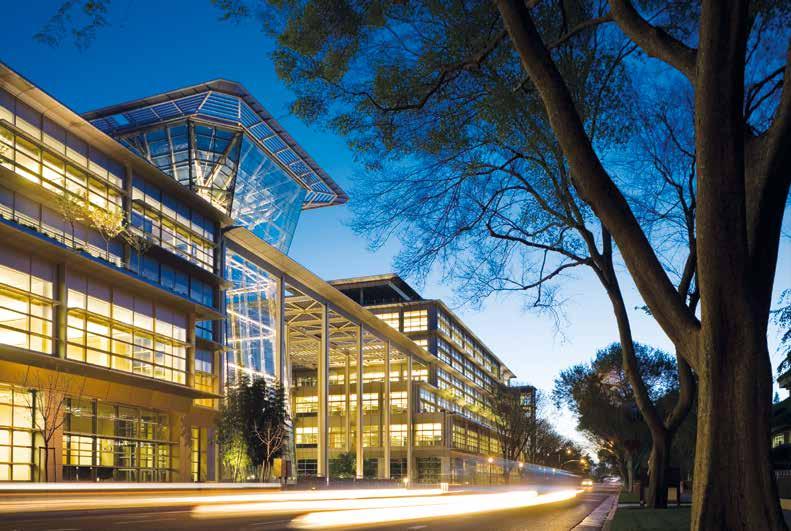
© Pickard Chilton © Peter Aaron/OTTO 186


Aaron/OTTO
© Peter
187
© Peter Aaron/OTTO
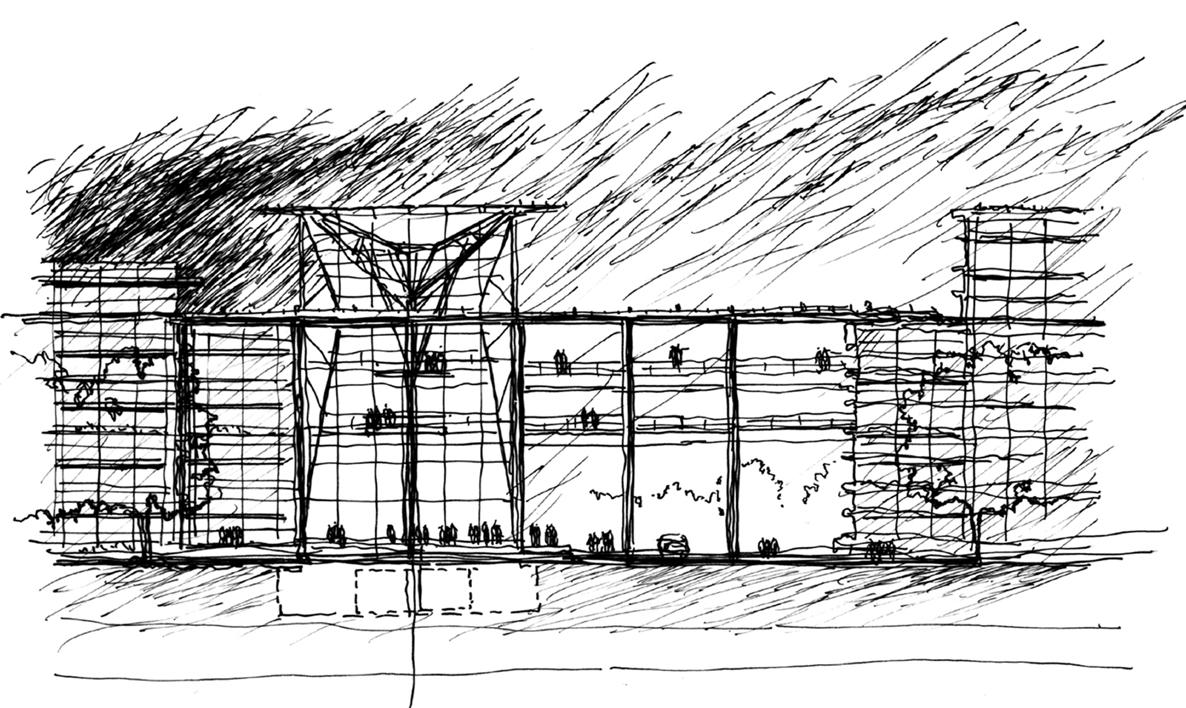
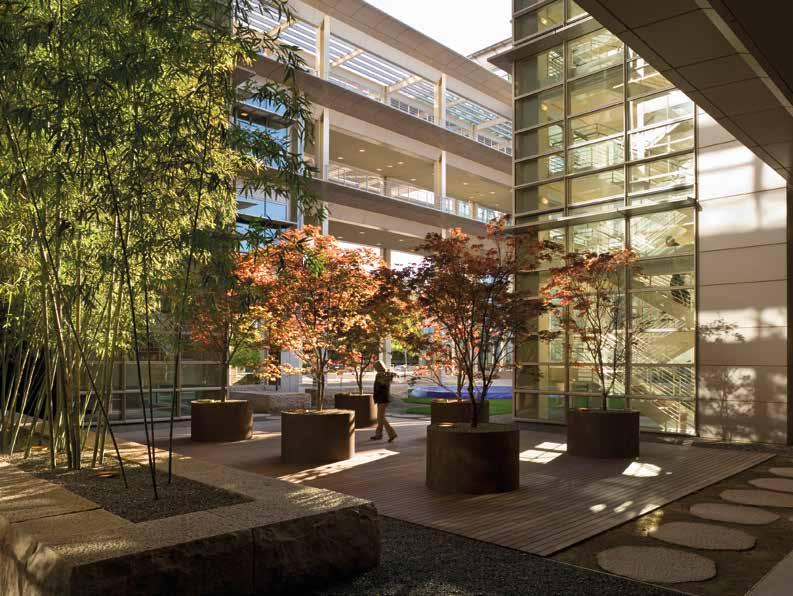
© Pickard Chilton
Peter Aaron/OTTO 188
©

189
© Peter Aaron/OTTO




GROUND
SITE PLAN 190
PLAN


LEVEL 04 © Pickard Chilton 191

Aaron/OTTO
© Peter

Peter Aaron/OTTO
©
Next Generation Workplace
Amsterdam, The Netherlands
THE DESIGN FOR a 35,000-m2 multi-tenant building on a prominent site in Amsterdam incorporates three volumes arranged in a triad and lifted off the ground to create an open, permeable, and inviting ground plane accessible to the public. A central atrium space within the building serves as a hospitality-oriented urban living room, encouraging longer stays and more opportunities for interaction between people.
The atrium is alive with energy and light, trees and plants, and active with balconies, overlooks, meeting rooms, dining areas, exhibition space, fexible work areas, and
places for casual interaction. The atrium is an amenity-flled ecosystem for creative collaboration and building community internally among the building occupants and externally with the public.
The exterior building composition is a series of interlocked and stepping volumes that respectfully address adjacent buildings and break down the scale. The warm bronze tones of the exterior enclosure incorporate photovoltaic panels in a unique sawtooth pattern orienting panels toward the southern exposure and accessible outdoor green terraces.
Location: Amsterdam, The Netherlands
Size: 35,000 gsm
Certifcation: BREEAM Excellent Targeted
Developer: Hines
Design Architect: Pickard Chilton
Executive Architect: INBO
Master Plan Architect: Team V
Sustainability, Façade, Civil: Arcadis
Landscape: BOOM
194

© Lifang 195
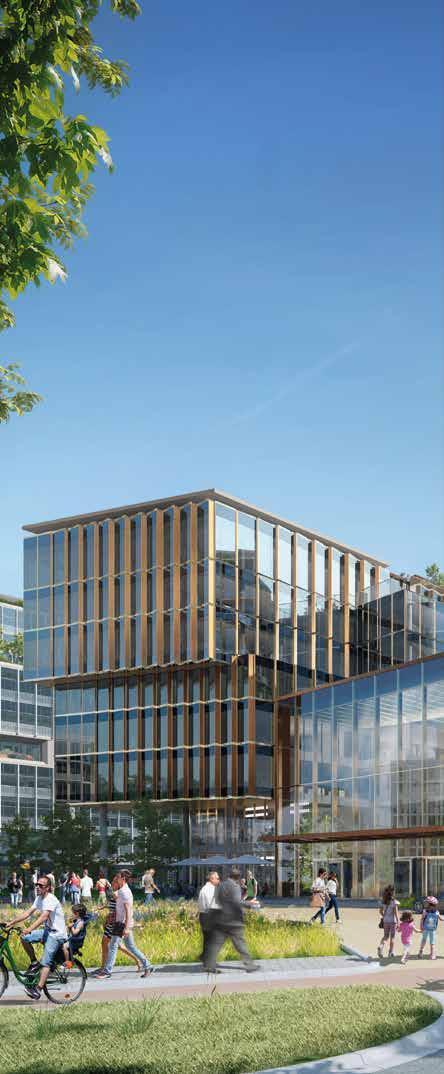




196
GROUND PLAN LEVEL 01
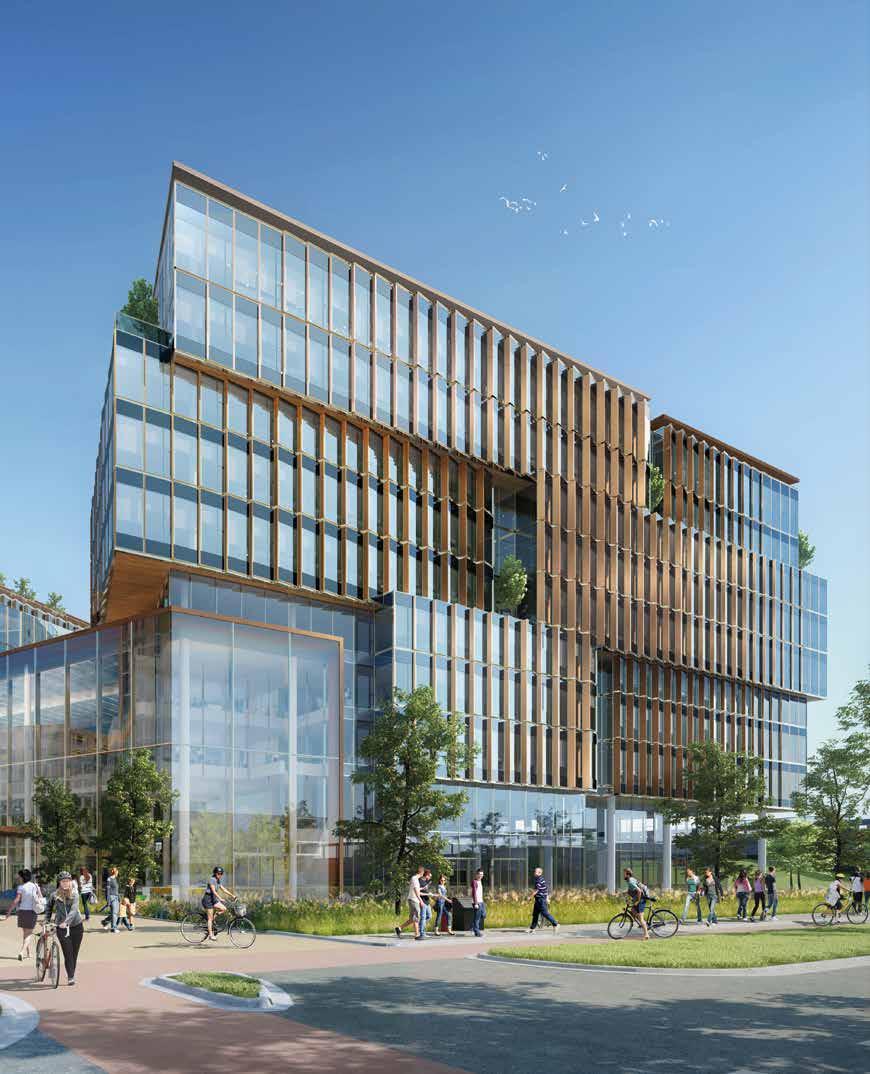
© Lifang 197





198
LEVEL 02 LEVEL 03

© Lifang 199
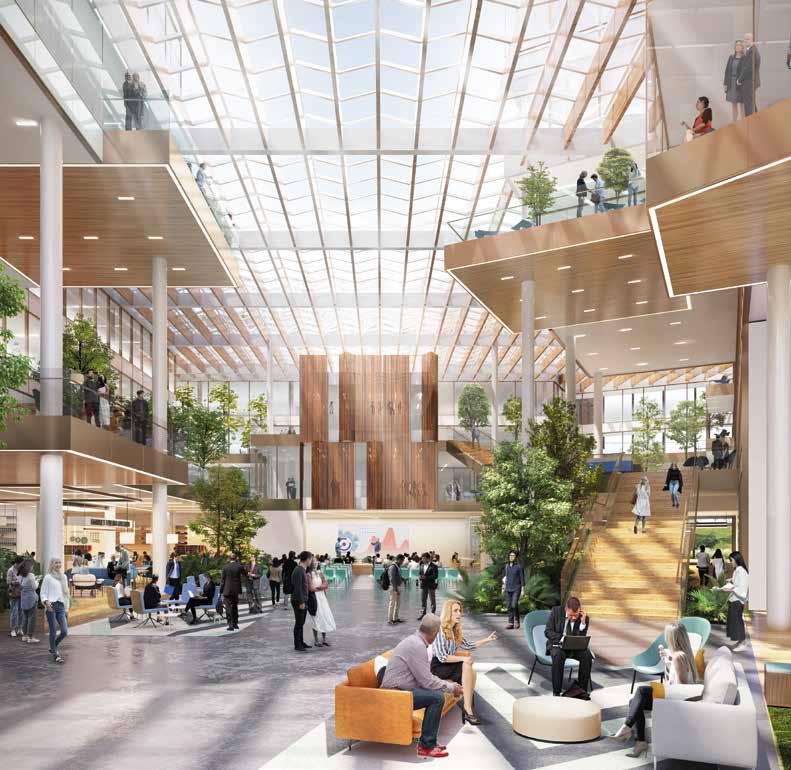
© Lifang 200

© Lifang 201
Mass Timber Architecture
PICKARD CHILTON HAS designed 325,000 gsm of mass timber architecture across North America since 2013 – the equivalent in carbon reduction of eliminating 6,985 cars from the road or the annual amount of energy necessary to power 3,108 homes. We are vocal proponents of carbon-informed mass timber design and actively support the global initiative to increase its accessibility and availability to a greater span of geographic regions and markets.
Since completing our frst timber project in 2018, the ATCO Commercial Centre in Calgary, we have built upon and continually expanded our team’s knowledge of this rapidly evolving and much-anticipated industry. The fundamental attraction of mass timber is its innate connection to the human experience, its contribution to providing healthy, sustainable environments, and the simplicity of the construction process as compared with conventional carbon-laden building methods.
Connecting
the Benefts of Wood and Well-being
The use and application of natural wood in mass timber buildings create healthier and inspirational environments. They embody the central principles of biophilic design, the human attraction to be close with other forms of natural life. Designing an interior environment rich with natural wood has a positive effect on the autonomic nervous system, making occupants subconsciously more comfortable and relaxed. Unfnished wood can be incorporated throughout the interior and exterior design, celebrating the beauty and strength of the natural material. Large structural elements in warm wood tones evoke a comforting familiarity of a tree canopy.
Due to their inherent density and composite attributes, wood products and mass timber contribute to sound control and acoustic dampening within a building. Mass timber building products are hypoallergenic, enhancing a building’s air quality, and the improved humidity control of the material improves the thermal comfort over baseline construction.
202
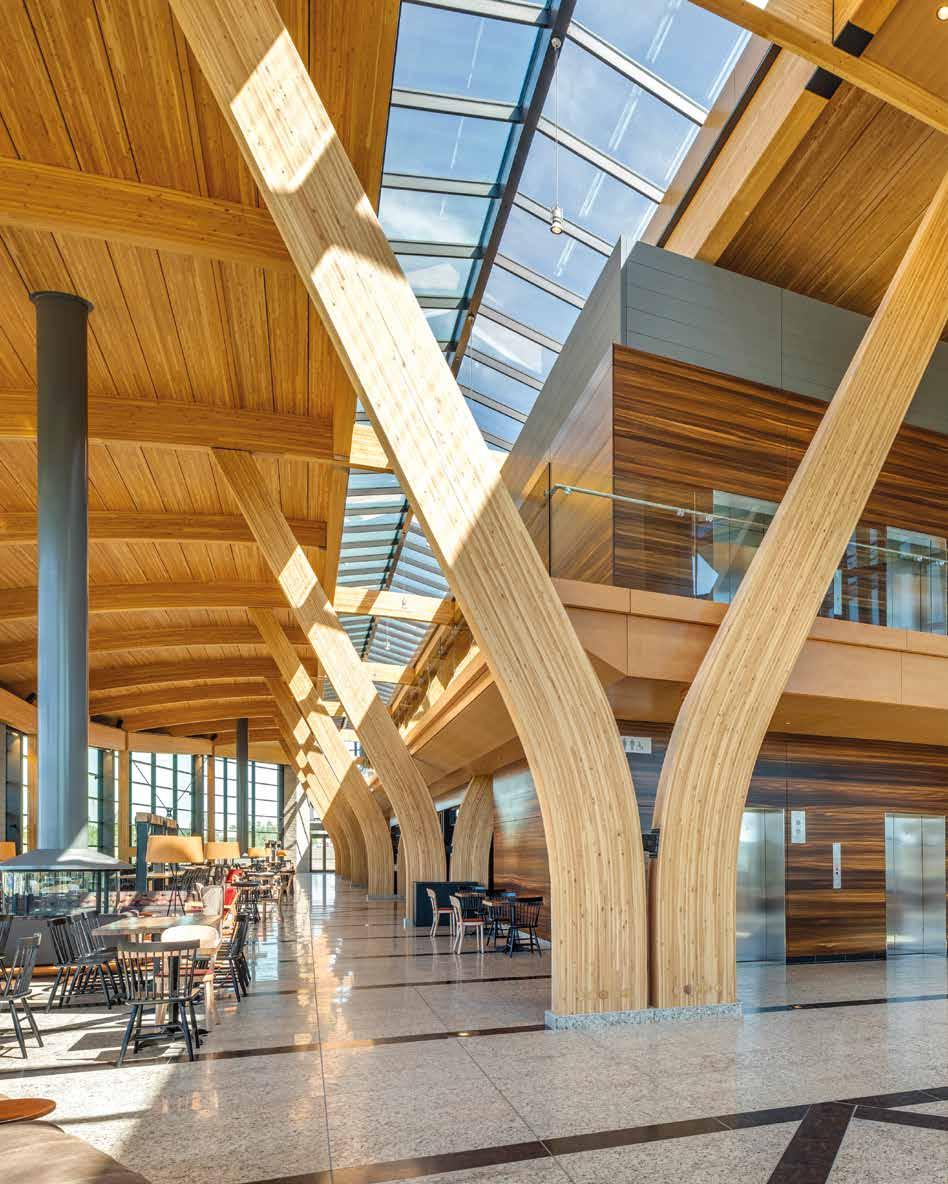
ATCO © Jason Dziver
The Craft of Mass Timber Construction
Humankind has used wood to build shelter for millennia. The simplicity and effciency of mass timber’s construction process differentiate it from conventional carbon-laden building methods. Large-scale structural elements are prefabricated and delivered to the site ready to assemble, signifcantly reducing construction time and waste. Prefabricated elements are assembled with less intensive construction sequences than their concrete or steel counterparts. This effcient staging process allows for less disruption and construction noise, thereby demonstrating sensitivity and consideration of neighboring sites and the greater community.
Mass timber’s unique characteristics also share signifcant life-safety benefts. Due to the natural density of mass timber, it does not burn like conventional wood, but rather slowly chars. Mass timber products therefore qualify for a fre rating even when left exposed without additional fre-protective materials. Careful consideration of the use of mass timber and the planning of its construction sequences creates abundant opportunities for greater effciency of personnel, time, and materials.
204
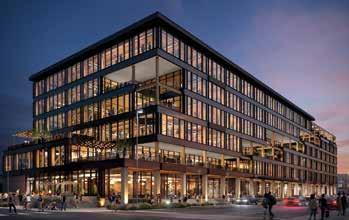
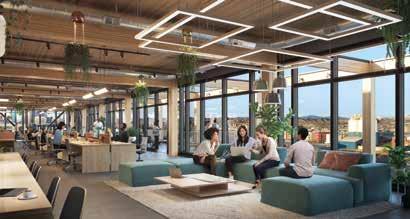
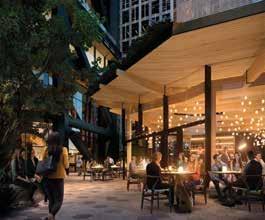
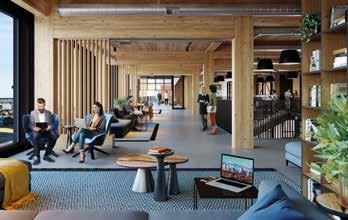

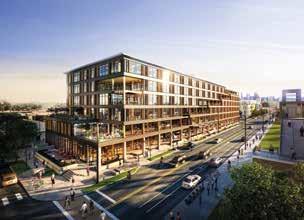
6 5 4 3 2 1 1. T3 RiNo (on page 154) - © Steelblue; 2. T3 RiNo (on page 154) - © Steelblue; 3. The Eight (on page 42) - © Steelblue; 4. T3 RiNo (on page 154) - © Steelblue; 5. ATCO - © Jason Dziver; 6. T3 RiNo (on page 154) - © Neoscape 205
Studio Profle
Pickard Chilton is a global architecture studio that designs innovative buildings and transformative environments that deliver value and inspire community. Founded in 1997, the New Haven, Connecticut-based, 50-person studio provides design services to public and private sector clients internationally. The studio is large enough to be entrusted with highly competitive projects of landmark scale yet small enough to offer visionary clients the gratifying experience of shared engagement in the realization of their ambitious goals.
The studio practices exclusively as a Design Architect and collaborates with experienced Executive Architects to meet the unique needs of each client. This practice model ensures that clients have access to the most highly qualifed professionals for all aspects of design, project management, building technology, and construction administration. A collective belief that 1+1=3 enlivens our collaborations and gives weight to all voices involved in the design process. The intangible element in the equation is the relationships that add incomparable value to the process, the project, and ultimately our clients’ missions. This collaborative alchemy produces environments where occupants, innovation, and communities thrive.
Process
We believe that design is a process of discovery. All aspects of the studio’s work are animated by the belief in the transformative power of research-driven design to deliver high-performance buildings that create measurable value for clients, produce an engaging and productive workplace, and build better communities.
With over 1,600 square feet of fabrication space in our New Haven studio, Pickard Chilton is committed to design by making. Studio members work alongside two professional model designers to bring complex ideas to life. A critical aspect of our process, physical models serve our clients while also providing invaluable perspective for the discovery of new design ideas.
Understanding our clients is foundational to how we practice. Our goal at the outset of every project is to answer more questions than are asked. For architecture to achieve that objective, it must be the product of more than an equation or a conversation; it depends on a relationship founded on trust, communication, and mutual respect. When these are established, we are able to uncover our client’s needs and understand the non-architectural issues that we can address with design.
Only through mutual trust is it possible for us to appreciate these nuances that enliven and deepen our design response. The deeper our design response, the more resonant and effective the outcomes can be, creating unanticipated benefts that ripple outward to building occupants, our client, the community, and the profession.
Jon Pickard FAIA, RIBA Principal
Jon Pickard is recognized internationally for his achievements in architecture. These include 1180 Peachtree and headquarters for Norfolk Southern in Atlanta; Northwestern Mutual in Milwaukee; ExxonMobil in Houston; and Devon Energy in Oklahoma City.
He received his Bachelor of Arts in Architecture from Iowa State University and his Master of Architecture from the Yale School of Architecture. He is a member of the Royal Institute of British Architects and the AIA College of Fellows.
William D. Chilton FAIA, RIBA Principal
William Chilton leads projects for corporate and institutional clients worldwide. Recent headquarters projects include SherwinWilliams in Cleveland and Eaton in Dublin, and large mixed-use projects in Germany and Japan, including Global Gateway Shinagawa in Tokyo.
He received his Bachelor of Arts in Architecture from Iowa State University and Master of Architecture from the University of Minnesota. He is a member of the Royal Institute of British Architects and the AIA College of Fellows.
Anthony Markese FAIA, RIBA, LEED AP Principal
Anthony Markese leads the design of projects worldwide. These include Akamai Technologies’ and Google’s headquarters in Cambridge, 2+U in Seattle, ExxonMobil’s Campus in Houston, 1144 15th in Denver, River Point and 300 North LaSalle in Chicago, and CalPERS’ Headquarters in Sacramento.
He received a Bachelor of Science in Architecture from the University of Illinois and a Master of Architecture from the Yale School of Architecture. He is a USGBC LEED-AP and member of the AIA College of Fellows.
Leadership
Pickard Chilton’s process and ethos draw on a deep heritage that informs our practice. Jon Pickard, William Chilton, and Anthony Markese share a formative background in the Midwestern United States, combined with an extensive record of success in designing complex, high-profle projects internationally. The resulting layered perspective informs all aspects of the frm’s work, as Pickard Chilton presents clients with a knowledge-based approach that emphasizes design vision, integrity, and exceptional service. The principals are deeply involved with every project, forming relationships with clients that typically lead to ongoing collaborations.

206
The Senior Associates and Associates of Pickard Chilton lead the studio as award-winning designers of iconic corporate buildings and campuses, as well as commercial high-rises and academic and cultural institutions. These experienced studio leaders apply the same
Senior Associates
exacting standards to every project, while fostering a culture of teaching, mentoring, and creativity. If there is a signature Pickard Chilton “style,” it is one with its emphasis on design through making and artful collaboration with clients, colleagues, and communities.
Nancy Clayton AIA, LEED GA
With nearly three decades directing a broad range of corporate, academic, and cultural projects, Nancy Clayton has served as Design Director for several signifcant corporate high-rise and campus projects. She directed Northwestern Mutual’s headquarters in Milwaukee, Wisconsin; components of the ExxonMobil Global Campus in Houston; Devon Energy’s headquarters in Oklahoma City; and the expansion of ConocoPhillips Headquarters in Houston. Most recently, Ms. Clayton directed 2+U, a mixed-use offce tower in downtown Seattle.

Before joining Pickard Chilton, Ms. Clayton was a Senior Associate with Gwathmey Siegel and Associates Architects, where she collaborated on many awardwinning academic campus and museum projects, including the expansion to Frank Lloyd Wright’s Guggenheim Museum.
Ms. Clayton graduated summa cum laude from Princeton University with a Bachelor of Arts in Architecture. She received her Master of Architecture from Princeton University.
Stephen Fritzinger AIA, LEED AP

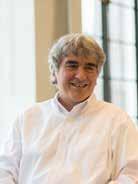
BD+C Stephen Fritzinger has over three decades of design experience including corporate headquarters and commercial, residential, and hospitality buildings. Mr. Fritzinger has served as Project Director for several signifcant projects including the ExxonMobil Global Campus in Houston; The Atrium, a luxury residential tower in Dubai, UAE; Eighth Avenue Place in Calgary; and ConocoPhillips Headquarters West Campus expansion in Houston.
Mr. Fritzinger was formerly a Senior Associate and Project Manager with Kevin Roche John Dinkeloo & Associates where he collaborated on projects ranging from the Merck Headquarters in New Jersey to the Borland Software Headquarters in California. Other notable projects include the Bank of America Plaza in Atlanta and several for Cummins, Inc. in Columbus, Indiana.
He received a Bachelor of Arts degree in Art History from Brown University, followed by a Master of Architecture from the Yale University School of Architecture, where he has also taught.
Michael Hensley AIA, RIBA, LEED AP BD+C, WELL AP Michael Hensley’s deep experience includes numerous corporate, commercial, and residential projects. Mr. Hensley has been a member of the design team leadership for several signifcant headquarters and highrise offce projects including the Field Street Tower in Dallas; T3 RiNo and 1144 Fifteenth Street, both in Denver; the ExxonMobil Global Campus in Houston; The Atrium in Dubai; and Kingdom Tower in Jeddah.
Mr. Hensley led the Pickard Chilton Leed initiative to educate staff on the Leed accreditation and design process. Additionally, as a Well AP, Mr. Hensley promotes the advancement of health and wellbeing in buildings and communities to both clients and colleagues.
Mr. Hensley received a Bachelor of Architecture from the School of Architecture at the University of Texas at Austin where he graduated as a Collegiate Scholar with University Honors. He was a National Hispanic Recognition Program Scholar and a recipient of the University of Texas Architecture Travel Scholarship.
207
Senior Associates and Associates
GA David Brown has experience with numerous corporate, commercial and residential/hospitality projects. Of note, Mr. Brown has been a key member of the design teams for several signifcant headquarters and high-rise projects including: 300 North LaSalle and River Point, both in Chicago; Eighth Avenue Place in Calgary; and 900 New York Avenue in Washington, DC.
Mr. Brown is currently serving as Project Manager for an offce tower in a confdential mixed-use master plan development in Houston. Most recently, he served as Project Manager for 145 Broadway, Akamai’s new headquarters in Cambridge, Massachusetts, as well as Amegy Bank’s new headquarters and the Energy Center for ExxonMobil’s Global Campus, both in Houston, Texas.
Mr. Brown received a Bachelor of Architecture from the Oklahoma State University School of Architecture.
Stephen Harris has experience with multiple corporate, commercial, multifamily residential, and civic projects. He has been a key design team member for complex projects of varying scale and program including: Northwestern Mutual’s headquarters in Milwaukee; the Minnesota Senate Building in St. Paul; 609 Main at Texas in Houston; and the OLC Integrated Development in Kuala Lumpur, Malaysia.
Mr. Harris is currently a senior design team member team for 600 Fifth Street NW, the redevelopment of a 37,200-m2 offce building in Washington, DC. Most recently, he served as project leader for a confdential high-rise multifamily development in Houston, and Hines’ One Worldcenter Development in Miami.
Mr. Harris received a Bachelor of Arts magna cum laude from Carleton College and a Master of Architecture from the University of Texas at Austin. Mr. Harris leads the studio’s recruiting efforts and has served as a member of numerous design juries at the undergraduate and graduate levels.

Howlett’s design experience includes participation in invited international design competitions for a range of signifcant corporate, commercial and research projects. He led the design team for the Global Gateway Shinagawa master plan and Block 4 buildings in Tokyo, and is currently project manager for Plieningerstraße 140 in Stuttgart, Germany.
Mr. Howlett has been a contributing design team member for the Rosslyn Plaza master plan in Arlington, Virginia, Northwestern Mutual’s headquarters in Milwaukee, a confdential mass timber corporate campus in California, and offce projects in Boston, Miami, and Tampa. He previously worked in Washington, DC, and New York.

Mr. Howlett received his Master of Architecture degree from the Yale School of Architecture, earning the Parsons Medal for City Planning. Prior to Yale, Mr. Howlett was a Fulbright Fellow in Rotterdam. He received his Bachelor of Science in Architecture and minor in Landscape Architecture from the University of Virginia.
Lanczycki AIA
John Lanczycki has 25 years of experience coordinating all phases of design and construction services on numerous signifcant corporate and commercial projects. He has been responsible for construction administration for some of Pickard Chilton’s highest profle projects, including several complex commercial and corporate developments.
Mr. Lanczycki is currently the Project Manager for Hewlett Packard Enterprise’s new campus currently under construction north of Houston. Most recently, he was the project manager for 300 Colorado, a 33,500-m2 Class A offce tower in Austin, Texas. He previously served as Project Architect for Northwestern Mutual’s headquarters in Milwaukee, Wisconsin, and the 50-story Devon Energy Center in Oklahoma City, Oklahoma.
Mr Lanczycki holds a Bachelor of Architecture from the Wentworth Institute of Technology in Boston, Massachusetts.


AP Deborah Lukan has been Project Manager at Pickard Chilton for more than 1.1M m2 of corporate offce and mixed-use projects including 600 Canal Place, Dominion Energy’s new headquarters in Richmond, Virginia; the ExxonMobil Offce Campus in Houston, Texas; 900 New York Avenue offce building in Washington, DC; Four Seasons Place, a 60- and 36-story, 300,000-m2 gsf luxury hotel, residential, and retail complex in Kuala Lumpur, Malaysia; and 300 North LaSalle, a 60-story tower in Chicago.
Ms. Lukan has previously worked in Shelton, Connecticut, and London, United Kingdom, where she collaborated on numerous institutional and higher education projects. She currently serves on the Professional Advisory Board for the Clemson School of Architecture, and is the architect licensing coordinator and mentor for Pickard Chilton interns.
She earned a Bachelor of Science in Architectural Design from Clemson University and a Master of Architecture from Virginia Polytechnic Institute.

208 Associates
David Brown AIA, LEED
Stephen Harris AIA
Owen Howlett AIA, LEED AP, WELL AP Owen
John
Deborah Lukan AIA, LEED
AIA, LEED AP BD+C Seung Namgoong has extensive experience on transformative urban master plans, large-scale corporate headquarters, and commercial and mixeduse high-rise projects for a diverse and international client base.
Mr. Namgoong is currently a key designer and the project manager for the 13-hectare Global Gateway Shinagawa development and Tokyo Midtown Yaesu, a 297,000-m2 mixed-use high-rise, both currently under construction in Tokyo, Japan. Most recently, he was a key design team member 600 Canal Place, Dominion Energy’s new headquarters for in Richmond, Virginia. Previous project experience includes, The Atrium in Dubai; Eaton House in Dublin; Eaton Center in Cleveland; and the 1000+ meter Kingdom Tower in Jeddah.
Mr. Namgoong received a Bachelor of Art in Architecture and Minor in Art from University of California at Berkeley and a Master of Architecture from the Yale School of Architecture. Mr. Namgoong is fuent in English, Korean, and Japanese.

experience includes the design for multiple large-scale corporate and commercial projects to serve a diverse and international client base.
She is currently the Design Team Leader for two mass timber developments in California: a 116,000-m2 confdential corporate campus, and an offce complex in Redwood City. Most recently, she was a Design Team Leader for 2+U, a 92,000-m2 offce tower in Seattle. Previous projects include the T3 RiNo development in Denver, and 325 Main Street, Google’s new headquarters in Cambridge.

Completed projects include 1144 Fifteenth Street in Denver; the Senate Offce Building in St. Paul, Minnesota; and the ATCO Campus in Calgary.
Ms. Nelson received a Bachelor of Fine Arts in Interior Design and a Masters of Architecture from Iowa State University where she received the Miller Fellowship, the Graduate AIA Medal. Ms. Nelson was recently an AIA Connecticut board member and is the Co-chair of the AIA Women in Architecture Committee.
Rodney Nelson has been a key design team member for multiple signifcant headquarters and highrise projects including Northwestern Mutual’s headquarters in Milwaukee; the ExxonMobil Global Campus in Houston; the Devon Energy Center in Oklahoma City; and Wells Fargo in Des Moines.
Most recently, Mr. Nelson has led the design of a series of next-generation high-rise corporate and offce developments nationally, including Norfolk Southern’s headquarters as well as a speculative offce development, both in Atlanta; a proposed mixeduse offce development on Boston’s waterfront; and L Block component of Tampa’s Water Street development.
Within the studio, Mr. Nelson regularly shares his knowledge of façade design ensuring awareness of lessons learned and upholding consistent high quality across the frm’s projects. He previously worked at frms in Portland, Maine and Edinburgh, Scotland. Mr. Nelson received a Diploma in Architecture from HerriotWatt University, Edinburgh, Scotland.
Simmons AIA,
Benjamin Simmons has been responsible for coordinating all phases of design and construction for some of Pickard Chilton’s highest-profle projects. He is currently serving as Design Team Leader for Hines’ 415 20th offce tower in Oakland, California. Most recently, he directed Hines’ One WorldCenter, a mixeduse high-rise featuring Class A offce, multifamily residential, and retail in Miami. Previously, he served as project lead for River Point, a 50-story high-rise in Chicago, as well as leading Eaton House, Eaton’s global headquarters in Dublin.
Mr. Simmons has been a key member of design teams for Eaton Center, a corporate campus in Beachwood, Ohio; the 50-story Eighth Avenue Place in Calgary; 300 North LaSalle, a 60-story high rise in Chicago; 1180 Peachtree in Atlanta; Wells Fargo Headquarters in Des Moines; and The Atrium, a residential tower in Dubai.
Mr. Simmons received a Bachelor of Architecture from Oklahoma State University.
the
of Design Computing, Andrew Swartzell creates and integrates technologies at the forefront of the AEC industry to provide studio teams with the latest computational design tools and knowledge.


As a Designer, Mr. Swartzell has coordinated all phases of design and construction projects for a diverse and international client base. He recently was the Design Team Leader for Uber’s Sky Tower and Sky Loft and has also been a key design team member for signifcant headquarters and high-rise offce projects, including the Iskandar Investment Headquarters in Malaysia, BHP’s headquarters in Houston, and Eighth Avenue Place in Calgary.
Mr. Swartzell holds a Master of Architecture degree from the University of Pennsylvania. He graduated with Distinction and Honors in Architecture from Pennsylvania State University, where he received a Bachelor of Architecture degree and was the recipient of the Alpha Rho Chi Medal.

209
Seung Hwan Namgoong
Adrienne Nelson AIA, IIDA Adrienne Nelson’s
Rodney Nelson
Benjamin
RIBA
Andrew Swartzell LEED AP As
studio’s Director










 © David Sundberg/Esto
© David Sundberg/Esto

 © David Sundberg/Esto
© David Sundberg/Esto

 © David Sundberg/Esto
© David Sundberg/Esto
 © David Sundberg / Esto
© David Sundberg / Esto
 © David Sundberg/Esto
© David Sundberg/Esto



 © David Sundberg / Esto
© David Sundberg / Esto

 © Alan Karchmer
© Alan Karchmer


 © Alan Karchmer
© Alan Karchmer
 © Peter Aaron/Eston
© Peter Aaron/Eston











 © Pickard Chilton
© Pickard Chilton

 © Pickard Chilton
© Pickard Chilton





 © Joe Aker/Aker
© Joe Aker/Aker

 © Alan Karchmer
© Alan Karchmer








 © Pickard Chilton
© Pickard Chilton


 © David Sundberg/Esto
© David Sundberg/Esto






 ©
©








 © Pickard Chilton
© Pickard Chilton



 © David Sundberg/Esto
© David Sundberg/Esto


 ©Pickard Chilton
©Pickard Chilton

 © David Sundberg/Esto
© David Sundberg/Esto

 © David Sundberg/Esto
© David Sundberg/Esto


 © David
© David
















 © Joe Aker/Aker
© Joe Aker/Aker

 © Joe Aker/Aker Imaging
© Joe Aker/Aker Imaging
 © Joe Aker/Aker Imaging
© Joe Aker/Aker Imaging










 © Tom Rossiter
© Tom Rossiter



 © Tom Rossiter
© Tom Rossiter


















































 © Pickard Chilton
© Pickard Chilton


































 ©
©
































































